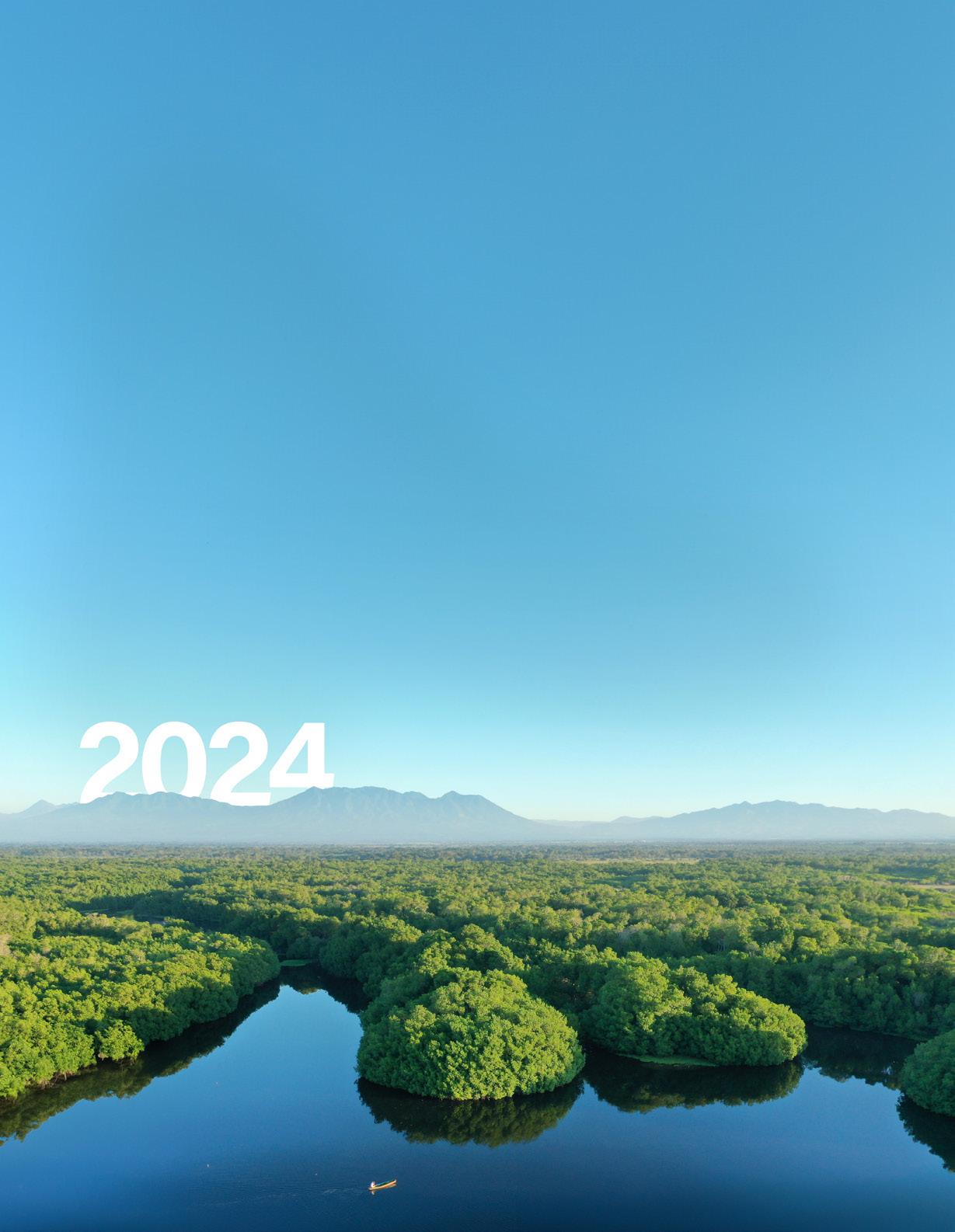

THE STATE OF THE WORLD’S MANGROVES
The State of the World’s Mangroves 2024
Maricé Leal and Mark D Spalding
Cartography by Kate Longley-Wood. Contributing authors: Aji Anggoro, Camilo Andres Arrieta Giron, Jacob Ashton, Ronald Baker, Rodrigo Andrés Baos Estupiñán, Basir, Mark Beeston, Justine Bell-James, René Benguerel, Nimai Bera, Anete Berzina-Rodrigo, Punyasloke Bhadury, Tanmatra Bhanti, Chris Brown, Peter Bryant, Pete Bunting, Juan Pablo Caicedo García, Steven Canty, Nilson Cardoso, Raúl Carvajal, Gustavo Adolfo Castellanos-Galindo, Paula Castro Brandão Vaz dos Santos, Sabyasachi Chakraborty, Xavier Chalén, Jayati Chourey, Benjamin Christ, Valeria Contessa, Carlos Correa, Marília Cunha-Lignon, Ajanta Dey, Giovanny Diaz, Karen Douthwaite, Norman C Duke, Diane Figueroa, Anwesha Ghosh, Luz Gil, Emily Goodwin, Kerry E Grimm, Tomislav Hengl, Sebastian Herrera-Fajardo, Bernal Herrera-Fernández, Topik Hidayat, Lammert Hilarides, Jennifer Howard, Whitney Johnston, Ariane Kaploun, K. Kathiresan, Adolfo Kindgard, Hari Kushardanto, Edmond Kuto, Emily Landis, Joe Shing Yip Lee, Vienna Leigh, Valeria López Portillo Purata, Donald Macintosh, Pasin Maprasom, Bruna Martins, Tania Maxwell, Christine McClung, Laura Michie, Nicolas Moity, Julio Montes de Oca, James Morris, Nibedita Mukherjee, Ivan Nagelkerken, Simon Ntab, Maria Nuutinen, Ana Pachon, Chiara Patriarca, Hannah Pickard, Renilde Piedade, Valerie Pietsch McNulty, Suvarna Punalekar, Alfredo Quarto, Cicelin Rakotomahazo, Vatosoa Rakotondrazafy, Jaona Ravelonjatovo, Jennifer Ring, Frances Camille Rivera, Juan Robalino, Elena Roddom, Kristina Rodriguez, Sarai Rodríguez, Ake Rosenqvist, Samadrita Roy, Mailton Santos, Suzanne Scatliffe, Steve Schill, Madicke Seck, Kenichi Shono, Frida Sidik, Marc Simard, Stefanie Simpson, Milon Sinha, Levis Sirikwa, Lydia Slobodian, Lindsey S Smart, Maura Sousa, John Stelzer, Ena Suarez, Jennifer Tabola, Veerachai Tanpipat, Amit Thavaraj, Timothy Tiggeloven, Susanna Tol, Marcos Valderrábano, Pieter van Eijk, Bregje van Wesenbeeck, Vincent van Zelst, Adriana Vidal, Jaxine Wolfe, Thomas A Worthington, Nelson Zambrano, Luis Alonso Zapata Padilla, Chris Zganjar, Anelise Zimmer, and Philine S.E. zu Ermgassen
Map credits
Administrative boundaries used in the basemaps are provided by GADM (Global Administrative Areas) version 3.6.
The Global Mangrove Alliance
The Global Mangrove Alliance is currently coordinated by members Conservation International, The International Union for the Conservation of Nature, The Nature Conservancy, Wetlands International, World Wildlife Fund, SaciWATERs, and Audubon Americas.
Special thanks are offered to the Convention on Biological Diversity and Executive Secretary Astrid Schomaker.
DOI provided by Smithsonian Libraries and Archives.
The designations employed and the presentation of material in this work do not imply the expression of any opinion on the part of the Global Mangrove Alliance or any of its members concerning the legal status of any country, territory, or area or of its authorities, or concerning the delimitation of its frontiers or boundaries.
Suggested Citation: Leal, Maricé and Spalding, Mark D (editors), 2024 The State of the World’s Mangroves 2024. Global Mangrove Alliance.
DOI: https://doi.org/10.5479/10088/119867
Cover image: Early morning fishing in the Natural Reserve of Monterrico (Reserva Natural de Usos Múltiples de Monterrico) on the Pacific Coast of Guatemala. © Jose Jorge Ubico Koose / Mangrove Photography Awards.
Special thanks to the Mangrove Photography Awards and Mangrove Action Project for access to remarkable mangrove imagery.
Designed and produced by Yoke www.yokedesign.studio
For further information: www.mangrovealliance.org and www.globalmangrovewatch.org
Contact:
contact@mangrovealliance.org membership@mangrovealliance.org
1. Introduction
1.1 Foreword


Astrid Schomaker, Executive Secretary Convention on Biological Diversity
Mangroves are not just a home, but a pulsing heart for the surrounding lands and seas.
Tracing a rich green fringe around tropical shores across the world, mangroves are connectors between land and sea, and between freshwater and the ocean. The biodiversity they shelter reflects these different biomes – insects and crustaceans, monkeys and manatees, birds and fish. They are not just a home, but a pulsing heart for the surrounding lands and seas, as mangroves are some of the world’s most productive ecosystems. Fish and prawns come here to spawn, or to shelter, or to grow out their early life-histories. Migrating birds take shelter and sustenance from the trees, mudflats, pools, and channels.
Under the Convention on Biological Diversity, the global community has recognized the importance of biodiversity, not only for its own sake, but also for the many ecosystem services and functions it provides for our well-being and survival. In many ways, mangroves are the poster child of the interdependence between people and nature. As such, it is great to read, in this State of the World’s Mangroves, of the fantastic advances in our knowledge, and to see how this knowledge is being shared around the world.
In a few short years, the Global Mangrove Alliance has grown to become a remarkable amalgamation of organizations, people and knowledge. Its partnerships spread around the globe, connecting many NGOs with national partners and local groups and practitioners. The Alliance has built an ambition for mangroves that can help to achieve, and even surpass, the 2050 Goals established under the Kunming-Montreal Global Biodiversity Framework.
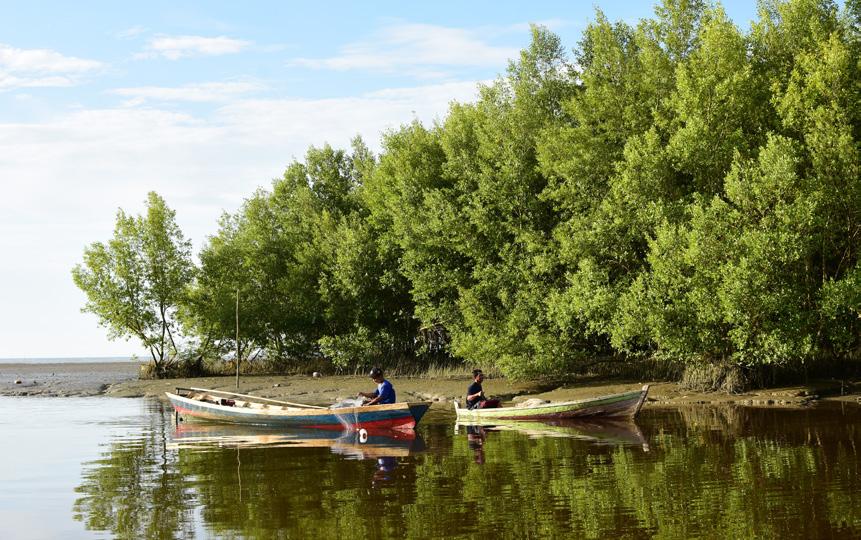
Mangroves are important in the context of nearly all Goals and Targets of the Framework, and must play a central role not only in efforts for restoration (Target 2) and area-based conservation (Target 3), but also in targets addressing spatial planning, sustainable use, climate change and species conservation, among others.
This report is an impressive synthesis of the state of knowledge for mangroves and presents a clear case of the critical need to protect these ecosystems. It shows how mangroves annually support nearly 800 billion juvenile fishes, prawns, bivalves and adult crabs, and play an essential role in ensuring food security. It shows the tremendous progress towards protection of all of these ecosystems as well as how this contributes to carbon sequestration and protection of coastal areas from storm surge.
But, it is not all smooth sailing. The latest maps of threats produced by the IUCN reveal a very mixed story, with certain areas showing ongoing threats and pressures. FAO has also generated important data to help us understand the drivers of change, both gain and loss, building on their remarkable networks of in-country expertise.
The road ahead will not be easy, but it is possible by working with coastal communities, better sharing information, establishing best practices for restoration, and working to build up policy and to enable countries, communities and the private sector to ensure we not only hold on to mangroves, but can realize the vision of “substantially increasing” the extent and condition of mangroves and ensure that they can continue to provide the many co-benefits that are essential to a healthy functioning global ecosystem.
Local fishermen rely on the productive waters of the mangrove forest area near Sedau Village, Singkawang, West Kalimantan, Indonesia. © Reza Novriandi / Mangrove Photography Awards.
1.2 Executive summary
Introduction
Mangroves are critical ecosystems, bridging land, freshwater, and sea. They host tremendous diversity, and protect and provide for countless coastal communities around the world. This 2024 edition of The State of the World’s Mangroves highlights the tremendous advances that have been made on multiple fronts to safeguard these ecosystems. It showcases progress in: science and understanding; collaboration and information sharing; practical management interventions; and the many policy, legal, and financial tools that will help to secure a better future for these ecosystems.
The state of mangroves
The latest world map (GMW v4.0), developed by the Global Mangrove Watch, provides a sixfold improvement in spatial resolution, from 25 meters to 10 meters. It maps 147,256 km² of mangroves in 2020, adding data for six new territories. At these resolutions, the maps are ever-more relevant, even at local scales, for supporting conservation and management.
The drivers of change to mangrove cover are explored in a summary of an important new study by the FAO. For the first time, it is possible to separate out notable impacts. Conversion to aquaculture, oil palm plantations, and rice cultivation together explain 43% of mangrove losses between 2000 and 2020. Natural retraction, influenced by climate change, sediment shifts, and sea-level rise, also significantly impacted mangrove
This 2024 edition of The State of the World’s Mangroves highlights the tremendous advances that have been made on multiple fronts to safeguard these ecosystems.
areas. Regional breakdowns highlight very diverse patterns of change, with human impacts dominating change in Africa, Asia, and North and Central America.
While the FAO data corroborates previous GMW findings of declining rates of loss since 2010, the recently released IUCN Red List of Mangrove Ecosystems has found that half of the world’s mangrove provinces are considered threatened. These assessments are strongly influenced by both past and projected future losses, but also take into account the threat that climate change, particularly sea-level rise and increased storm intensity, poses to mangroves.
The diversity of mangrove plants is given particular attention. The IUCN Mangrove Specialist Group has begun work on developing an authoritative list of mangrove taxa, with an interim list of 82 taxa listed in
this report. Although there are challenges to developing this list, it is critical to future conservation and analyses, including a proposed new round of the IUCN species Red Listing process.
Mangroves should not be considered in isolation, and the advent of a new global map of tidal marshes draws attention to the connections across ecosystems. Habitat connectivity is also explored with seagrass meadows, tidal flats, and coral reefs. Integrating mangrove conservation with the protection of adjacent ecosystems is essential for maintaining the ecological integrity and resilience of coastal zones.
Connecting to local
Human links to mangroves are inherently local, and the GMA is making great strides to highlight the value of local ecological knowledge (LEK) in conservation and management. Building on a new GMA report, the insights of LEK in understanding historical mangrove change, ecological processes, and management approaches are extensive. Integrating such knowledge requires a full and equitable collaboration, actively involving LEK holders as partners in conservation and restoration efforts. Case studies from Madagascar, Colombia, Kenya, Brazil, and El Salvador highlight the significant impact of LEK on mangrove conservation.
The importance of connecting across scales is further explored in consideration of platforms, including ‘coastTrain’ and the Coastal Carbon Network, that unite data from around the world. These are ever greater refinements in global models and maps, but also peer-to-peer support in our understanding of mangroves in local settings encouraging consistent and comparable measurement of mangrove extent, carbon stocks, fisheries production, and more.
Benefits of mangroves
The latest global model and map of mangrove soil carbon, supported by the GMA, has been combined with aboveground biomass estimates, confirming our understanding of the substantial carbon storage potential of these ecosystems. Mangroves hold, on average, a remarkable 394 tonnes of carbon per hectare in their living biomass and in the top meter of soil. Some mangrove areas, such as those in the Philippines, have average values of over 650 tonnes per hectare.
Mangroves are home to a tremendous diversity of species, reflecting their close links both to adjacent waters and nearby rivers, and terrestrial ecosystems. Over 5,700 plant and animal species, across 21 phyla, have been recorded in Indian mangroves alone.
Flooding is the most frequently occurring natural disaster worldwide and is exacerbated by climate change. A new study by Delft University of Technology has, for the first time, used a 2D modeling approach to measure and map storm surge reduction by mangroves at present and in future climate scenarios. Median values from 1-in-100-year storms show that mangroves reduce flood depths by 15-20%, and over 70% in some areas.
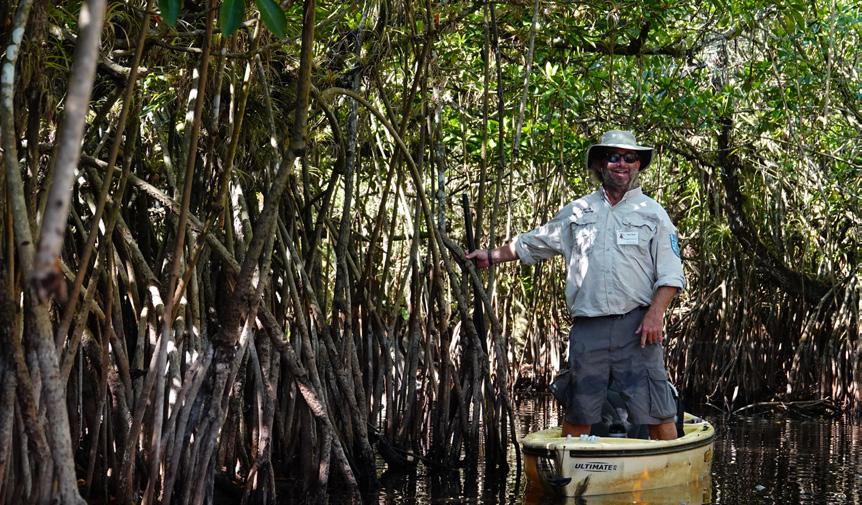

unproductive ponds with no commercial value. There are now numerous successful cases of natural mangrove regeneration facilitated by community-led ecological restoration of unproductive aquaculture ponds, but greater efforts are needed. There is also a need to consider opportunities to move new aquaculture away from mangrove areas. In parallel, some communities are exploring methods of partial restoration by incorporating mangrove planting into degraded ponds to establish lower impact aquaculture systems that revive some ecosystem services.
Another key component to successful mangrove management is to enhance livelihood opportunities. There are already considerable livelihood options around mangrove fisheries, salt production, and timber harvesting, while new industries, like ecotourism in healthy mangrove ecosystems, can help diversify opportunities and income.
Saving mangroves
Living with mangroves: a focus on food
Mangroves are among the world’s most productive ecosystems. They support all aspects of food security, and provide income, employment, and resources, such as livestock fodder, fiber, and fuelwood, for coastal communities. Equally important, they enable a secure, year-round stability in this provisioning.
Fish and invertebrates from the mangroves are critical protein sources for humans and are also rich in other essential nutrients. Non-aquatic food resources include honey, as well as leaves and fruits from many trees. Mangrove species are also widely used in traditional medicine. Mangrove timber and fuelwood (both firewood and charcoal) have a long history which, if well managed, can be sustainable.
In contrast, the clearance of mangroves has often been driven by other forms of food production, including crops, pasture, and aquaculture, with insufficient consideration given to the direct impacts that such clearance may have on coastal communities.
A new model presented here has estimated the density of 37 commercially important fishery species, showing that mangroves support nearly 800 billion young fish, prawns, bivalves, and crabs annually. While the data provides only a partial picture, the study underscores the immense value of mangroves in sustaining global fish populations and invertebrate productivity.
The development of modern industrial shrimp aquaculture has driven mangrove loss on massive scales. Such conversion has slowed, but still continues in many places, despite vast and growing areas of abandoned or
Globally, 40% of the world’s remaining mangrove forests are in protected areas. For many countries, such as Brazil, Mexico, and Bangladesh, over 75% are protected. But for others, including Malaysia, Papua New Guinea, and Myanmar, less than 5% are covered. The GMA has set a target of doubling protection by 2030, but reaching 80% protection globally represents a huge challenge. In part, this will require a significant increase in the application of Other Effective Area-based Conservation Measures (OECMs). Such areas may not have conservation as a primary aim, but can still achieve secure and long-term biodiversity benefits. OECMs have the added advantage of enabling the integration of biodiversity into development sectors, like food and water security.
Effective monitoring is a vital component of reducing mangrove losses and the Global Mangrove Watch loss
alerts now provide monthly updates of loss hotspots for 50% of the world’s mangroves. The alerts allow mangrove guardians to respond quickly when loss is discovered, providing the best chance for interventions to halt ongoing impacts and encourage rapid restoration.
Restoration efforts and opportunities, highlighted in previous reports, continue to grow, and the GMA has played a pivotal role in determining best practices that consider local ecological conditions, community involvement, and long-term sustainability. The six guiding principles for successful mangrove restoration provide a comprehensive framework for restoration projects. Community-based Ecological Mangrove Restoration, spearheaded by the Mangrove Action Project, is one proven method of restoration that adheres to the guiding principles.
The way ahead
Securing financing for mangrove conservation remains a challenge. Innovative financial mechanisms are essential to support on-the-ground actions, such as those outlined in the Mangrove Breakthrough Financial Roadmap and explored through the Blue Carbon Positive Business Model Activator (BC+). These mechanisms include sustainable financing models, carbon credits, mangrove insurance, and investment in communitybased conservation projects.
Policy frameworks like the Kunming-Montreal Global Biodiversity Framework and the UAE Consensus also help to drive change. Mangroves are increasingly recognized at international conventions for their powerful climate adaptation and mitigation benefits, and ability to support multiple Sustainable Development Goals. The Mangrove Breakthrough has placed mangroves center stage, gaining support from 50 governments, with a goal of mobilizing US$4 Billion to ensure the future of 15 million hectares of mangroves.
A great blue heron taking flight at Big Cypress National Preserve in Florida. © Lammert Hilarides, Wetlands International.
The Global Mangrove Alliance (GMA)
The GMA is the preeminent alliance driving conservation and restoration for the world’s mangroves. Its 100+ member organizations are based across 30 countries and operate in many more. The GMA’s goals to halt loss, double protection, and restore half of the world’s mangroves by 2030 are deeply ambitious. But its aims resonate, while its roles in driving progress are many and multifarious. These roles include supporting science and tracking change; driving policy; supporting financial initiatives; training practitioners; and, through its many members, undertaking practical and effective conservation and restoration projects across the globe.
Success hinges on partnership and sharing, and throughout this report there are photo stories and case studies which, alongside the core texts, are all linked to this spirit of collaboration. The continued commitment to mangrove conservation will shape a brighter, more equitable, and sustainable future for all.
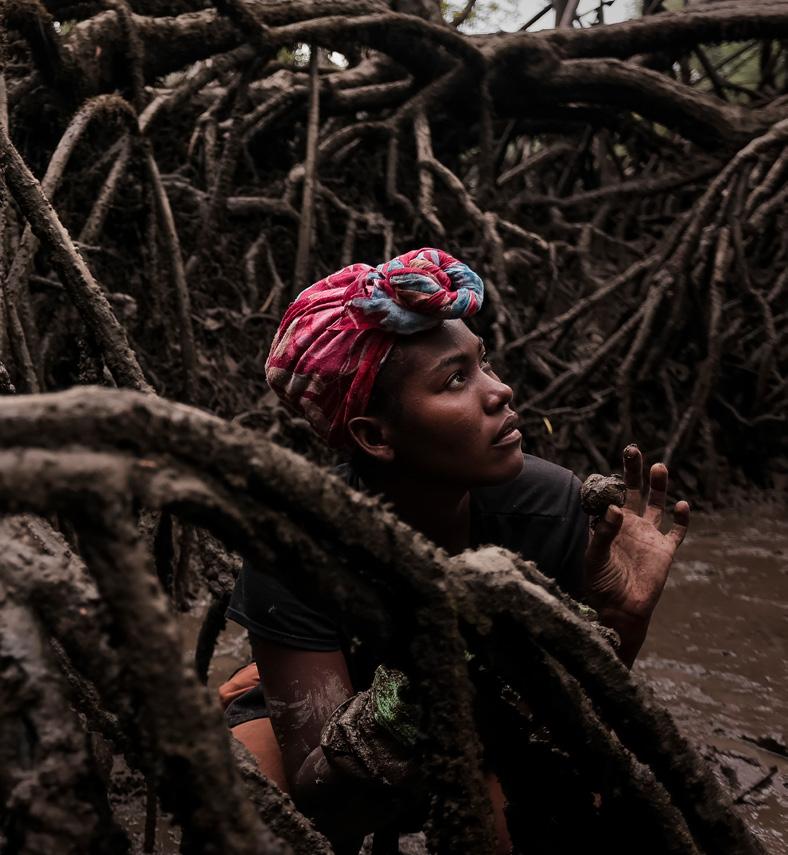
1.3 Setting the scene
The role and contributions of the Global Mangrove Alliance (GMA)
The Global Mangrove Alliance Steering Committee
Mangroves stand as nature’s unsung heroes, quietly yet significantly contributing to the health of our planet. They provide invaluable benefits, like food security, coastal protection, climate regulation, biodiversity enhancement, and livelihood support for coastal communities. Despite their importance, mangroves face continuing threats from human activities, including deforestation, pollution, and climate change.
Motivated by the urgency of conserving and restoring mangroves, the GMA grew out of the realization that more needs to be done, and faster, by learning from each other. Founded on the principles of collaboration and collective action, the GMA unites diverse stakeholders from government, academia, non-profit organizations, and industry to tackle challenges facing mangrove ecosystems.
The GMA’s central role is to coordinate partnerships, mobilize science-based resources and tools, and develop ambitious strategies to create the critical conditions needed to ensure the success of mangrove conservation efforts.
The GMA is working globally, nationally, and locally to enact its ambitious plan to turn the tables on the world’s mangroves. The plan contains three critical goals to be achieved by 2030:
The GMA grew out of the realization that more needs to be done, and faster, by learning from each other.
1. Halt mangrove loss. Reduce net mangrove losses due to human actions to zero, thus protecting approximately 16,800 hectares of mangroves.
2. Restore half of the world’s lost mangroves. Use science-based restoration to recover half of all restorable mangroves lost since 1996, approximately 408,300 hectares.
3. Double mangrove protection. Increase areas under conservation measures from 40% to 80%, safeguarding approximately 6.1 million additional hectares of mangroves.
More information about the GMA’s goals and how they were calculated can be found in The State of the World’s Mangroves 2022
Figure 1: The main report sections. These icons and headings can be found on the top left of each double page spread, and can be used to navigate to those sections.
Gabriela, a local woman from Bahía Málaga, Colombia, collecting cockles or “piangua” as a vital food-source, a livelihood and a deep tradition binding local people to their mangroves. © Daniel Alvarez, Mangrove Photography Awards 2024, Revista puntos.
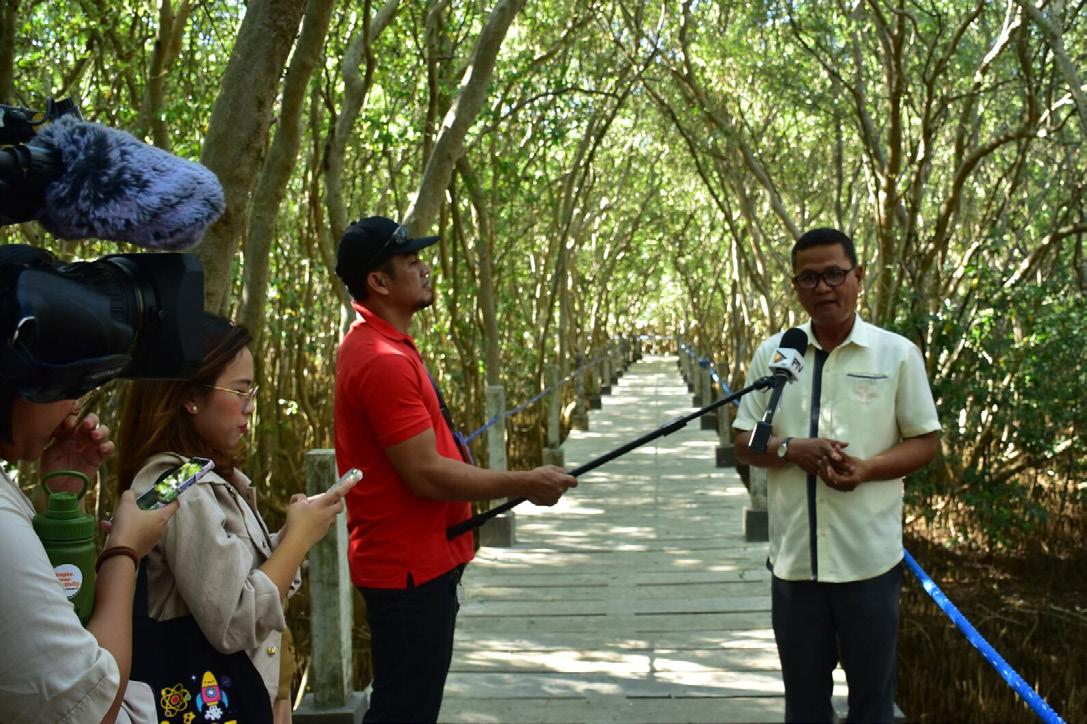
Central to the GMA’s approach is a commitment to working at scale, epitomized by our partnership with the Mangrove Breakthrough (see Section 7.3). The Mangrove Breakthrough represents a transformative initiative at the intersection of conservation, science, finance, and policy. It leverages research and fosters collaboration among stakeholders to unlock mangroves’ full potential as a climate solution. The Financial Roadmap (see Section 7.1) outlines innovative financial mechanisms that have the potential to support tangible action on the ground and empower communities in protecting and restoring mangroves while driving sustainable economic development. With the latest Red List of Mangrove Ecosystems assessment raising alarms about the future of mangroves in some regions (see Section 2.3), collective action at scale has never been more urgent.
In this 2024 edition of the State of the World’s Mangroves, you will learn about advances that have produced openly accessible, high-resolution mangrove maps. You will see examples of the Global Mangrove Watch loss alerts which currently monitor half of the world’s mangroves for real-time change. You’ll learn where mangroves are making a comeback, but also where they are highly threatened. New data cements the value of mangroves for coastal protection and fisheries. And you’ll read case studies and photo stories from GMA members and partners that illustrate the science through experiences on the ground. Let’s begin…
Steering Committee members
Since its inception in 2018, the GMA has experienced remarkable growth. Stemming from an idea among colleagues from five like-minded organizations, it has developed into an influential alliance of over 100 members globally, underscoring the recognition of mangrove conservation as a pressing environmental priority. This recent and ongoing expansion has enriched the diversity of voices within the GMA leadership, fostering broader representation, equity, and inclusivity in decision-making processes.
Moreover, the establishment of national chapters—10 existing and over five more in development—reflects the grassroots momentum driving mangrove conservation at local levels. National chapters form the GMA’s driving force, supported by local partners. While linked to global efforts through the international GMA team, national chapters are tailored to local needs, and incorporate local ecological knowledge, community input, and equity considerations.
The GMA employs a multifaceted approach that encompasses advocacy, science, capacity-building, and new methodologies. From global research, to stocktakes that assess progress and identify gaps, the GMA is actively shaping the future of mangrove conservation. By harnessing science to fill knowledge gaps and inform decision-making, the GMA provides stakeholders with insights and tools to drive meaningful change. The ‘State of the World’s Mangroves’ reports, powered by data from the Global Mangrove Watch platform and by leading researchers, and interwoven with knowledge and insights from practitioners and mangrove stewards in the field, bridge the gap between big-picture discussions and on-the-ground realities.
Guided by a shared vision of a world where mangroves thrive and communities prosper, the GMA remains steadfast in its commitment to safeguarding these vital ecosystems for future generations. Through true collaboration, innovation, and perseverance, the GMA makes meaningful progress towards its goal of protecting and restoring the world’s mangroves. Together, we can shape a brighter, more sustainable future for all.







When it comes to advancing mangrove restoration efforts in the Balanga Wetland and Nature Park in the Philippines, the media is a crucial channel for disseminating information about their importance and the proper techniques required to guarantee successful outcomes. © Wetlands International Philippines.
Jayati Chourey, Executive Director, SaciWATERs
Anete Berzina-Rodrigo, Project Manager, Ocean Team, International Union for Conservation of Nature
Julio Montes de Oca, Director of Coastal Resilience, Audubon Americas
Pieter van Eijk, Programme Head Deltas and Coasts, Wetlands International
Karen Douthwaite, Director of Oceans Conservation, WWF-US
Jennifer Howard, Vice President, Blue Carbon Program, Conservation International
Emily Landis, Global Climate & Ocean Director, The Nature Conservancy
2. The state of mangroves
2.1 The world of mangroves
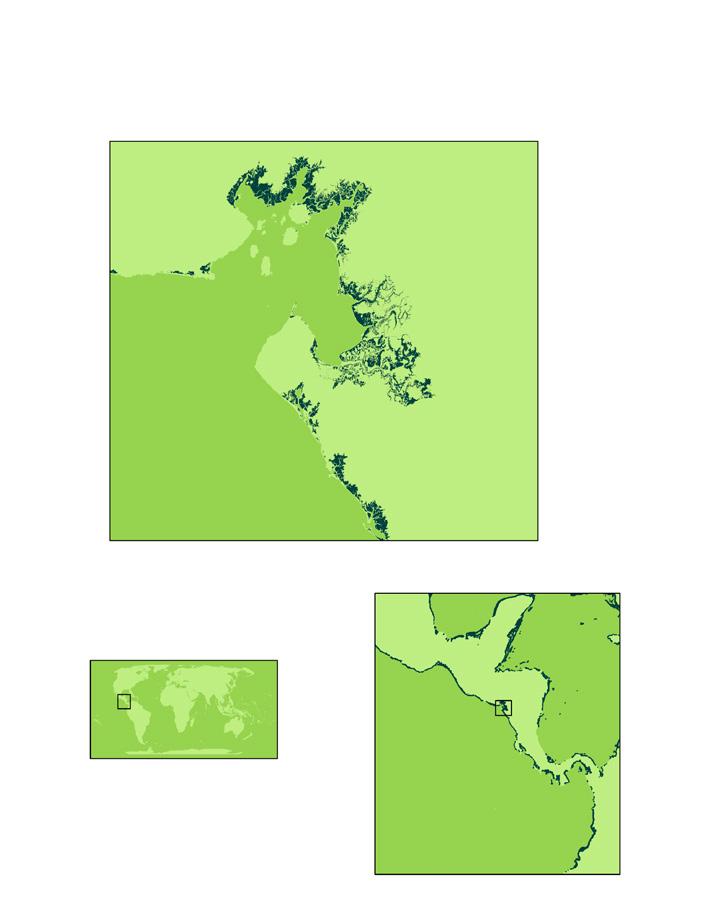
The global picture of mangrove extent is now better than ever thanks to the latest Global Mangrove Watch dataset which offers a sixfold increase in mapping resolution.
Pete Bunting (Aberystwyth University), Ake Rosenqvist (soloEO), Lammert Hilarides (Wetlands International)




Figure 2: The global extent of mangroves, 2020 (GMW v4.0).
Data on the location and spatial extent of mangroves is crucial for the protection and conservation of mangrove forests. The first global maps of mangrove forests were generated in 1997, and again in 2010 and 20111. These were one-off maps that have not been updated. Since 2018, the Global Mangrove Watch (GMW) has provided a time series of global mangrove extent maps from 1996 to 20202. The GMW mangrove extent dataset is now in its fourth iteration, with the GMW v4.0 released in 2024. A key element of the GMW approach has been the use of both optical and radar satellite data, and the iterative improvement of the extent maps through the incorporation of user feedback.
While providing useful global insight, lower resolution global datasets can often be of limited use at the local scale. At the same time, during GMW training events in mangrove countries, it has become increasingly apparent that many countries lack good quality national maps. This provided the motivation for a step-change in resolution to produce global datasets that are locally relevant. The new 2020 GMW v4.0 baseline has a spatial resolution of 10 x 10 meters (m).
Development of the GMW v4.0
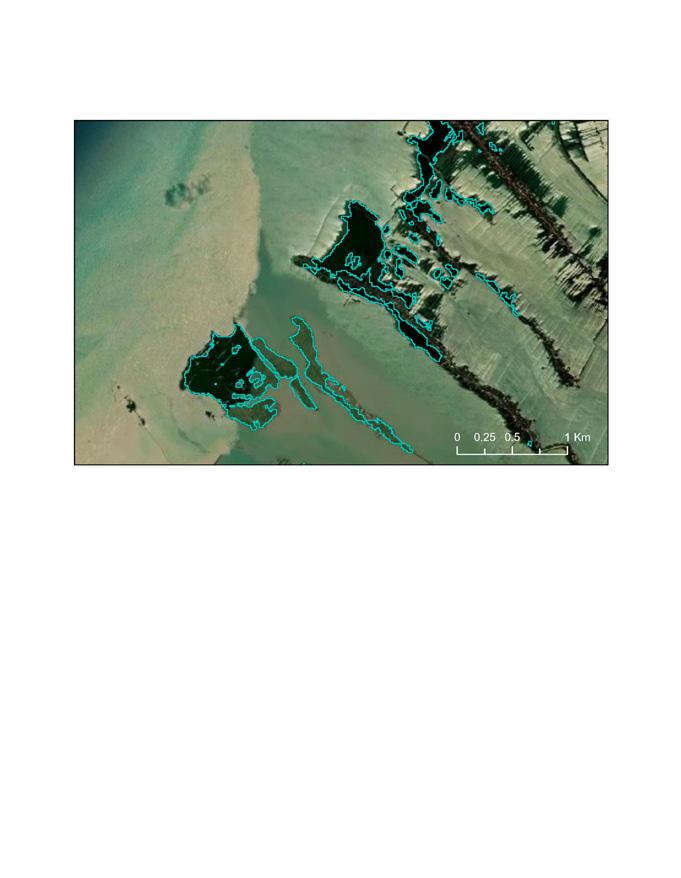
To improve the resolution and local relevance of the baseline for 2020, Copernicus Sentinel-2 satellite imagery were used, processed to a pixel resolution of 10 m. This represents a more than sixfold increase in the spatial resolution of the mapping, previously 25 m, and allows for much finer features to be mapped (Figure 3).
The feedback and visual assessment of the mangrove regions was used first to refine the GMW mangrove habitat mask2 and, secondly, to refine and improve the reference pixels used to train the classifier that was used to produce the map. The mangrove habitat mask defines the regions where mangroves can be expected to occur and hence constrains the classification
The overall accuracy of the GMW v4.0 map was estimated at 95.3%, a considerable improvement on GMW v3.05.

the
for
process on the assumption that this mask contains all mangrove pixels across the globe. The updates to the GMW habitat mask have resulted in a significant number of new areas of mangroves being identified within the GMW v4.0 baseline.
Pre-processed Sentinel-2 data, as used for the ESA WorldCover 2020 map3 were used to train over 30,000 machine learning models to classify mangroves using over 5 million reference points for mangrove and nonmangrove classes. The reference points were generated using the existing CoastTrain reference dataset4, sampling from the GMW v3.0 mangrove extent layers, user feedback, and extensive quality assurance and refinement during the production of the classification.
Outcomes
of the GMW v4.0 mapping
The GMW v4.0 2020 mangrove extent mapped 147,256 km2 of mangroves globally (Figure 2). This total extent is very similar to that mapped in GMW v3.0, but includes more notable changes at higher resolutions. The overall accuracy of the GMW v4.0 map was estimated at 95.3%, a considerable improvement on GMW v3.05. The enhanced accuracy can be attributed to a number of factors, including the improvements in the GMW mangrove habitat mask, better satellite imagery at higher spatial resolution, better and more accurate training data, and improvements in the machine learning approach to the classification.
1 Spalding, M. D., Blasco, F. and Field. C. D. (1997). World Mangrove Atlas. International Society for Mangrove Ecosystems, Okinawa, Japan. Spalding, M. D., Kainuma, M. Collins. L. (2010). World Atlas of Mangroves. Routledge, London. Giri, C., Ochieng, E., Tieszen, L.L., Zhu, Z., Singh, A., Loveland, T., Masek, J., Duke, N., (2011). Status and distribution of mangrove forests of the world using earth observation satellite data Global Ecology and Biogeography 20, 154 159.
2 Bunting, P., Rosenqvist, A., Lucas, R., Rebelo, L.-M., Hilarides, L., Thomas, N., Hardy, A., Itoh, T., Shimada, M., Finlayson, C., (2018). The Global Mangrove Watch—A New 2010 Global Baseline of Mangrove Extent Remote Sensing 10, 1669.
Bunting, P., Rosenqvist, A., Hilarides, L., Lucas, R.M., Thomas, N., (2022). Global Mangrove Watch: Updated 2010 Mangrove Forest Extent (v2.5). Remote Sensing 14 (4) 1034.
Bunting, P., Rosenqvist, A., Hilarides, L., Lucas, R.M., Thomas, N., Tadono, T., Worthington, T.A., Spalding, M., Murray, N.J., Rebelo, L.-M., (2022) Global Mangrove Extent Change 1996–2020: Global Mangrove Watch Version 3.0. Remote Sensing 14 (15), 3657.
3 Zanaga, D., Van De Kerchove, R., De Keersmaecker, W., Souverijns, N., Brockmann, C., Quast, R., Wevers, J., Grosu, A., et al (2021). ESA WorldCover 10 m 2020 v100.
4 Murray, N.J., Bunting, P., Canto, R.F., Hilarides, L., Kennedy, E.V., Lucas, R.M., Lyons, M.B., Navarro, A., et al (2022). coastTrain: A Global Reference Library for Coastal Ecosystems. Remote Sensing 14, 5766.
5 (94.8 – 95.7% 95th confidence interval). GMW v3.0 2020 had an estimated accuracy of 81.4% (80.4 – 82.2% 95th confidence interval). The accuracy assessment was conducted within the habitat mask used for the GMW v4.0 map using 49,600 reference points across 45 0.1 x 0.1 degree randomly selected regions.
Figure 3. Example of fringe mangroves near Demak, North Java, which were not detected in GMW v3.0.
Mangroves in
Chagos Archipelago, Indian Ocean, mapped in GMW v4.0
the first time. © Mark Spalding.
Figure 4 provides a regional breakdown of mangrove extent. Southeast Asia has almost 50,000 km2 of mangrove cover, or about one third of all mangroves globally (Indonesia alone has 21% of the world’s mangroves). This region is followed by West and Central Africa and then the two regions of the Americas.
Future work with GMW v4.0 will include a re-mapping of the historical time series, enabling a more reliable assessment of change over time.
The GMW v4.0 map has identified mangroves in 128 countries and territories, six more than in the previous GMW v3.0 map.
Additional mangrove countries
The GMW v4.0 map has identified mangroves in 128 countries and territories, six more than in the previous GMW v3.0 map (Table 1). While these extra countries and territories have small extents of mangroves that are often isolated, these patches are often especially important for conservation. They connect to adjacent ecosystems, such as coral reefs, and are of potential biogeographic interest where they lie in remote or edge-of-range locations6
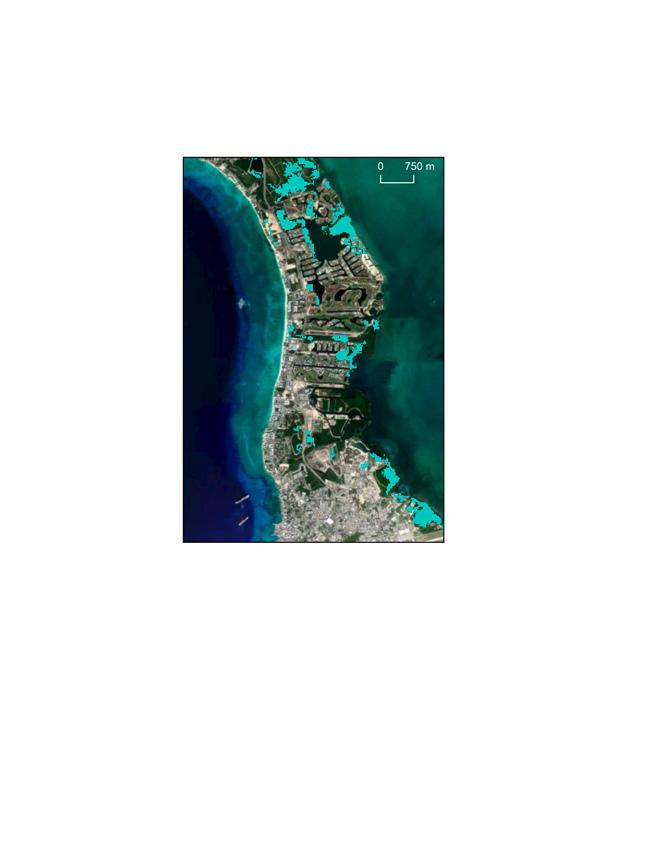

Figure 5 illustrates an example from Grand Cayman, where the GMW v3.0 2020 map had mapped the majority of the larger mangrove patches but missed the finer detail. The GMW v4.0 2020 map captured much more of the fine detail to produce a more complete map. For the Cayman Islands, these mapping improvements have resulted in the mapped mangrove area increasing from 4,489 hectares (ha) to 6,455 ha. Improvements in the fine detail and classification quality have been applied throughout the Caribbean, but also for islands in the Pacific and Indian Oceans. These changes can be particularly significant for small island nations, where both the average patch size and total area of mangroves are often small. It is expected that the new GMW v4.0 2020 10 m baseline will be a significant improvement for those working in these regions.

6 Curnick, D.J., Pettorelli, N., Amir, A.A., Balke, T., Barbier, E.B., Crooks, S., Dahdouh-Guebas, F., Duncan, C., et al. (2019). The value of small mangrove patches. Science 363, 239 239.
Figure 4. Distribution of mangroves within different regions of the globe.
Mangrove Extent
Example from the Cayman Islands where the fine detail has been significantly improved between the GMW v3.0 (left) and GMW
GMW v3.0
Country / Territory Mangrove area (hectares)
Chagos Archipelago 4.61


Through user and expert feedback, both latitude extremes of mangroves have been revised within GMW v4.0. The most northerly identified mangroves are located in Shizuoka, Japan, at latitude North
. This small stand of mangroves in MinamiIzu was first planted in 1959 and has survived over 60 years beyond its natural range and is sometimes
. Among naturally occurring mangroves, St. George’s Island in Bermuda still boasts the northern record at latitude 32.36°, as mapped in GMW v3.0. The most southerly mangroves identified are in Victoria, Australia, in Corner Inlet Bay at the southern tip of the continent. Mangroves were also identified here in GMW v3.0, but thanks to user feedback, the extent has been adjusted in the current update to include mangroves another 5 km to the south, along the southern rim of Corner Inlet Bay at The Philippines provide an example of an area that has received extensive updates influenced by user feedback. For example, users identified oil palm plantations incorrectly mapped as mangroves in the GMW v3.0 maps. Similar errors were also identified in parts of Indonesia. The reference data used to train the classification algorithm was specifically revised to address this issue and confusion between oil palm and mangroves has consequently been significantly reduced in the GMW v4.0 mapping. Additional extensive areas were also identified, such as in the northern part of Davao Gulf on Mindanao Island (Figure 7), which was further helped by the revision of the GMW mangrove habitat mask.





Okada, S. (2024). ManGlobal NPO (in Japanese) Shigey (2003). Mangroves in Minami-Izu (in Japanese)
An example from Mindanao Island in the Philippines where large areas of mangroves overlooked in the GMW v3.0 mapping (left) were
GMW 4.0
GMW 3.0
mangroves within the updated GMW v4.0 mangrove extent map.
34.63°
38.90°
Snow in the northerly mangroves of Kagoshima Prefecture, Japan, in 2016. © Seiichiro Okada, ManGlobal.
In arid regions such as the Saloum Delta, Senegal, mangroves are highly visible and easily distinguished with remote sensing. © Lammert Hilarides, Wetlands International.
The authors acknowledge the valuable contributions made by Richard Lucas, Daniele Zanaga, Ruben Van De Kerchove, Seiichiro Okada and Paula Castro Brandao Vaz dos Santos to the development of GMW v4.0.
2.2 Drivers of change to the world’s mangroves: 2000–2020
Aquaculture remains the key driver of mangrove loss, but the toll of climate change is growing.
Chiara Patriarca, Kenichi Shono, Adolfo Kindgard, and Valeria Contessa, (The Food and Agriculture Organization of the United Nations (FAO))
The Food and Agriculture Organization of the United Nations (FAO) recently conducted an extensive study on the global status of mangroves, which revealed valuable information on the drivers of mangrove loss over the past two decades9.
This study utilized a novel methodology that integrated remote sensing technology with local knowledge to analyze mangrove area changes. FAO collaborated with a team of 48 image interpreters worldwide to collect and analyze 20,900 samples at tropical and subtropical latitudes using the online platform Collect Earth Online (CEO). All image interpreters possessed local field knowledge of their study areas.
The status of land use in 2020 was assessed based on multispectral Sentinel-2 satellite imagery. Land use changes in 2010 and 2020 were assessed using Landsat imagery. Very high-resolution images from Bing Maps, DigitalGlobe, and MapBox supported image
The conversion of mangroves for aquaculture, oil palm plantations and rice cultivation accounted for 43.3% of global mangrove loss between 2000 and 2020.
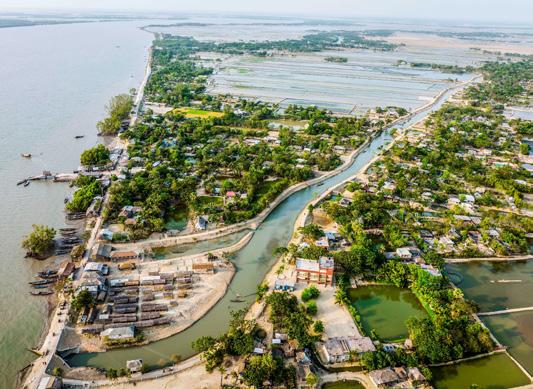
interpretation. Specific drivers of loss and gain were identified for any mangrove sample plots that had undergone changes in land use.
Using a sample-based approach, the study estimated 147,771 km2 of mangroves in 202010. Around half the total loss of mangrove area between 2000 and 2020 (6,769 km2) was offset by expansion of mangroves (totaling 3,930 km2) in areas where they were not present in 2000, resulting in a net decline of 2,839 km2. The rate of net mangrove loss decreased by 44% between the two 10
decades, falling from 1,815 km2 per year in 2000–2010 to 1,024 km2 per year in 2010–2020.
The conversion of mangroves for aquaculture, oil palm plantations and rice cultivation accounted for 43.3% of global mangrove loss between 2000 and 2020. The study also shows the importance of “natural retraction”, a term used to cover changes or losses of mangroves that are driven by movements in riverbeds, sediment inputs, or sea levels. Natural retraction accounted for 26% of the total loss over the 20-year period (Figure 8).
9 FAO (2023) The world’s mangroves 2000–2020 Rome.
and Landsat images for 2020. The global samples were chosen following a stratified random sampling design. The global mangrove population from which the samples were chosen followed the broad spatial footprint of GMW dataset (Section 2.1)
Figure 8. Global drivers of mangrove loss, 2000–2020 (Source: FAO (2023) The world’s mangroves 2000–2020. Rome).
Mangrove clearance in Satkhira, Gabura, Bangladesh, adjacent to the Sundarbans. © FAO-GMB Akash.
The global drivers of mangrove loss underwent significant change between the two periods (2000–2010 and 2010–2020). Aquaculture remained a key driver, but its significance diminished, causing about 31% of loss in 2000–2010, compared to 21% in 2010–2020. On the other hand, conversion to oil palm plantations became a substantially bigger driver (causing about 4% loss in 2000–2010, but 14% in 2010–2020). The significance of rice cultivation and direct settlement (conversion to buildings and infrastructure) as drivers of mangrove loss declined markedly. The proportion of mangrove loss due to natural retraction increased during 2010–2020. This is likely to be, at least partly, due to the intensifying impacts of climate change (Figure 9).
The relative importance of loss drivers differed markedly among the regions. Aquaculture was the most prevalent driver in South and Southeast Asia, where it accounted for 35% of loss, and was followed by natural retraction at 17%. In this region, conversion for rice cultivation and oil palm plantations was also significant, each contributing 13% to overall mangrove loss.
In North and Central America, the leading driver was natural retraction, accounting for 28% of mangrove loss. This was followed by aquaculture at 19% and wood extraction at 16%.
In Africa, the primary driver was classified as “other”, which included conversion for various other agricultural activities and accounts for 36% of loss. In West and Central Africa, however, direct settlement was the dominant driver of loss (38%).
In Oceania, mangrove loss was attributed to just two factors: predominantly natural retraction, which accounted for 90% of loss, and direct settlement, which was responsible for the remaining 10% of loss.
In South America, the main driver of mangrove loss over the two decades was natural retraction, accounting for about 80% of gross loss, followed by aquaculture at 9% and “other” at 7% (Figure 10).
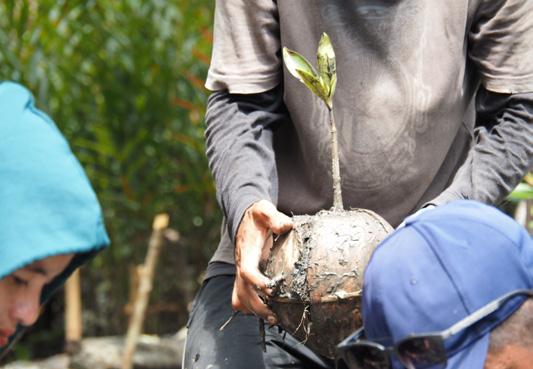
To reduce the effects of plastic pollution, locals from Bataraza and Balabac, Palawan, the Philippines, used materials abundant in the area, such as buri (palm leaf) and coconut husks to build eco-friendly nursery bags. © WWF-Philippines
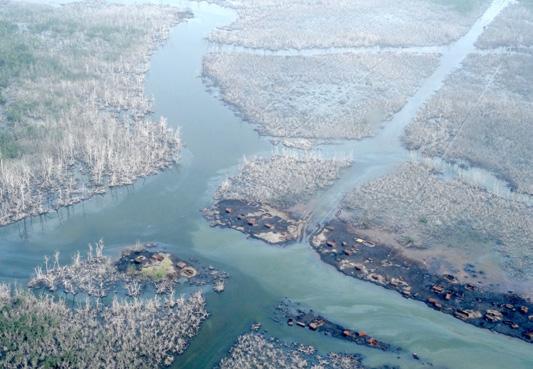
Mangroves in the Niger Delta are among the most severely affected in the world by major oil spills. Multiple impacts are observed across the massive deltaic area, and recovery is slow, if there is any recovery at all. The network of aging pipelines is the source of re-occurring leakages and is repeatedly sabotaged. © Norman C. Duke.
Figure 9. Global relative importance of drivers of mangrove loss, 2000–2010 and 2010–2020. (Source: FAO (2023) The world’s mangroves 2000–2020. Rome).
Oceania
Figure 10. Composition of drivers of mangrove loss, by region, 2000–2020. (Source: FAO (2023) The world’s mangroves 2000–2020. Rome).

Only patches of mangroves remain in Capalonga, the Philippines, due to intense flooding and mangrove cutting for charcoal. Wovoka, supported by Fair Carbon, is working with the Capalonga community to restore the mangroves. © Denise Janer and Khris Quinton.
Restoration efforts accounted for 25% and 33% of mangrove expansion in South and Southeast Asia and Africa.

Taking a broader categorization, natural causes predominate in South America and Oceania, while human-induced drivers are overwhelmingly dominant in Africa and Asia (Figure 11).
Natural expansion comprised 82% of all gains globally. Nonetheless, restoration efforts were also recorded and accounted for 25% and 33% of mangrove expansion in South and Southeast Asia and Africa, respectively.
INVEMAR
Sebastian Herrera-Fajardo (INVEMAR), Juan Pablo Caicedo García (INVEMAR)
Rome).
Given the increasing impacts of climate change, it might be expected that natural retraction would outpace natural expansion, but the study found the opposite. Natural expansion greatly exceeded mangrove loss due to natural retraction. While it is not possible to explain this phenomenon, it perhaps illustrates the difficulty of predicting the effects of climate change on mangrove communities given the complex interplay between local biophysical conditions and the consequences of global warming. It also highlights the resilience of mangroves in responding to environmental changes and in colonizing suitable habitats.
Mangroves provide important services to communities on islands, especially coastal protection from hurricanes. Two strong hurricanes, Iota (2020) and Julia (2022), caused significant damage to the infrastructure and livelihoods of the communities on the Archipelago of San Andrés, Providencia and Santa Catalina (Colombia). The mangrove forests of these islands also suffered disastrous consequences. The Marine and Coastal Research Institute, INVEMAR, has monitored the loss of mangrove structure of these islands following the hurricanes and highlighted, hand in hand with the communities, the importance of protecting and restoring this ecosystem.
Photo: © INVEMAR
2.3 The Red List of Mangrove Ecosystems
The Red List can guide future national assessments and actions to mitigate further mangrove loss.
Marcos Valderrábano and Ena Suárez (International Union for Conservation of Nature (IUCN)), Donald Macintosh (Asian Institute of Technology, Thailand)
Mangroves have long been exposed to multiple threats from human activities (see Section 2.2). Today such impacts are being exacerbated by climate change, especially sea-level rise and more severe and frequent
To answer these questions, the International Union for Conservation of Nature (IUCN) has led a global study involving more than 250 scientists from 44 countries entitled the Global Red List of Mangrove Ecosystems11
Following a broad consultation with mangrove experts in 2021-2022, the study started by classifying the world’s mangrove ecosystems in 36 provinces, and piloted The Red List of Ecosystems (RLE) methodology in the Southeast Asia region. This same approach was then applied in the first global assessment of mangroves


geographic distribution (B1/B2)
Illegal logging has degraded mangroves on Bengkalis Island, Indonesia. Facilitating natural regeneration has proven successful in this area, with intervention consisting of patrolling, installing warning prohibition boards, and monitoring.
© Dhika Rino (YKAN)

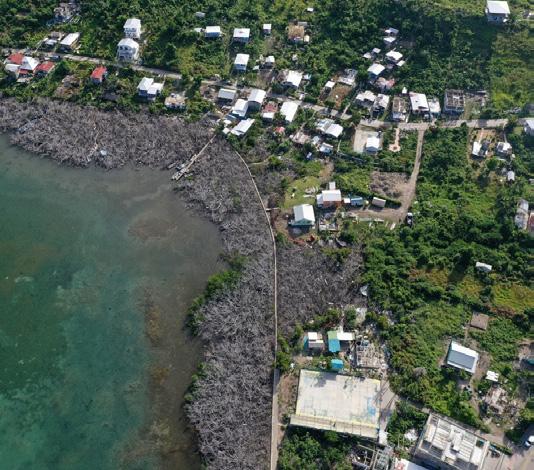
Figure 12: Overview of the criteria A-D
Avicennia marina subsp. australasica in a tidal inlet, Rawene, New Zealand. The formerly forested hills that now support extensive sheep and beef farming provide the elevated sediment levels supporting mangrove expansion. © Jeffrey McNeill.
In Jones Point Town, Colombia, a tropical northwestern Atlantic mangrove ecosystem mitigated Hurricane Iota’s impacts, but many mangroves were damaged or lost in the process. © Cristian Montes-Chaura.
More than half of the world’s mangrove provinces are at risk
The results show that 18 mangrove provinces are threatened, representing ~50% of the world’s mangrove area. Eight of these provinces are severely threatened and are assessed as either Endangered (EN) or Critically Endangered (CR).
The effects of climate change are a growing threat to mangrove ecosystems, especially more frequent and severe cyclonic storms, and sea-level rise. These two factors threaten one third (~30%, figure 12 criteria C2) of the mangrove provinces assessed (containing 37% of the world’s mangrove area).
Past losses have driven 28% of mangrove provinces into risk (38% of the global mangrove area, Figure 12 criteria A1 or A3). The trend of mangrove conversion is generally slowing down in many countries of South and Southeast Asia, although it is still accelerating in other areas, including the Gulf of Guinea South province.
The study revealed further significant regional and national differences in conservation status, for example:
New Zealand. The mangrove extent of New Zealand was 296 km2 in 2020, representing 0.2% of the global mangrove area. Situated near the southernmost global limit of distribution for mangroves, New Zealand’s mangrove ecosystems differ significantly from tropical ones in terms of their lower biodiversity. The mangrove trees also face unique drivers of change, leading to an expansion in their range. As a result, management is geared towards controlling mangrove expansion to
prevent the loss of nearby salt-marsh ecosystems. This province’s mangrove ecosystem is assessed as Least Concern (LC).
Tropical Northwest Atlantic. The mangrove extent in this region12 (the tropical Caribbean) was 17,407 km2 in 2020, representing 11.8% of the global mangrove area. While sediment supplies may be low in carbonatedominated parts of the region, urban mangroves were found to be unexpectedly accumulating sediments and nutrients at faster rates, potentially enhancing resilience to rising sea levels. Sea-level rise poses a multifaceted threat, from inundation and displacement of mangroves, to elevated storm surge impacts on the mangroves themselves. This province’s mangrove ecosystem is assessed as Vulnerable (VU).
The Gulf of Guinea (South). Mangrove extent in this region was 12,956 km2 in 2020, representing 8.7% of the global mangrove area. This is 33% less than our estimation for 1970. The main threats to mangroves in this province are pollution from oil and gas exploration and production, coastal development, mineral mining, and agriculture. This province’s mangrove ecosystem is assessed as Vulnerable (VU).
Future perspectives
This RLE global study can help guide future national assessments and actions to mitigate further mangrove loss. However, to inform decision-making it is recommended that countries should always use reliable national or other lower scale assessment results, whenever these are available.13
12 IUCN Red List of Ecosystems, Mangroves of the Tropical Northwestern Atlantic (ecoevorxiv.org).
13 These offer data at finer resolutions and also enable the subdivision of mangroves into subtypes, with certain sub-types being more threatened than others. National and sub-national assessments have been undertaken for the following territories: Mozambique, Abu Dhabi (EAD), Tonga, Mayotte (French Overseas), Sundarbans (Bangladesh, India), Moreton Bay (Australia), Philippines, Colombia, Myanmar.
Future mangrove management strategies should assist mangroves to adapt to climate change.

Nutrient pollution
The results of this study can also be used to help restoration and adaptation plans14 Future mangrove management strategies should assist mangroves to adapt to climate change, e.g. by minimizing local threats and enabling both vertical and landward migration.
Management strategies aimed at achieving global commitments, such as the Mangrove Breakthrough (see Section 7.3) which aims to secure the future of 150,000 km2, should account for the risk of collapse, including from climate change impacts. The Global Red List of Mangrove Ecosystems study is a contribution towards achieving the global goals for mangroves.
Anthropogenically driven pollutants are becoming a fastgrowing threat to mangrove ecosystems. Estuarine mangroves that receive high volumes of freshwater inflow are commonly vulnerable to high nutrient pollution. Nitrogen, a necessary macronutrient, that sustains mangrove productivity by aiding plant growth and microbial survival, is also the primary cause of eutrophication in these ecosystems. The rapidly growing pressures of agriculture and aquaculture in and around mangrove ecosystems, and along the banks of the upstream riverine systems, result in pockets of nitrogen-enriched water being released directly into mangrove patches. Indian Sundarbans currently report dissolved inorganic nitrogen pools as high as >50µM, enough to stall the productivity of resident aquatic microbial communities in these ecosystems15.
The Sundarbans is fed by freshwater from the GangesBrahmaputra-Meghna Delta, which brings down high concentrations of riverine pollutants. Long-term data from the Ganga Ecological Time Series indicates numerous point sources of nitrogen pollution into the River Ganga.
14 Bland, L. M., Nicholson, E., Miller, R.M., Andrade, A., Carré, A., Etter, A., Ferrer-Paris, J.R., Herrera, B., et al (2019). Impacts of the IUCN Red List of Ecosystems on conservation policy and practice Conservation Letters 12:e12666.
Valderrábano, M., Nelson, C., Nicholson, E., Etter, A., Carwardine, J., Hallett, J.G., McBreen, J., Botts. E. (2021). Using ecosystem risk assessment science in ecosystem restoration: A guide to applying the Red List of Ecosystems to ecosystem restoration. IUCN, Gland, Switzerland.
15 Ghosh, A. Woodward, E.M.S., Saha, R., Nelson, C.E., and Bhadury, P. (2022) Nitrogen driven niche differentiation in bacterioplankton communities of northeast coastal Bay of Bengal. Environmental Research Communications. 4 035006.
Anwesha Ghosh (Indian Institute of Science Education and Research Kolkata)
Photo: © Yash

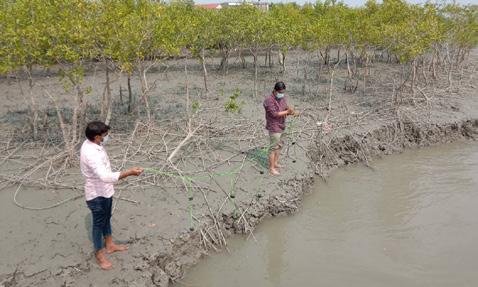
Pollution and microbes
Punyasloke Bhadury (Indian Institute of Science Education and Research Kolkata)
Freshwater inflow from upstream regions has resulted in the accumulation of antimicrobial agents (e.g. antibiotics) and heavy metals within mangrove ecosystems. River and agricultural runoff commonly carry antibiotics, antifungal agents, pesticides, and chemical manures deep into pristine mangrove ecosystems, owing to water mixing and tidal inflow. Animal husbandry, poultry farming, and the use of cosmetic products by human populations living near mangrove ecosystems are also a source of antibiotics. The presence of these antimicrobial agents is acting as a ‘stress’ to the resident microbial populations, possibly triggering the evolution and expression of antimicrobial resistance in opportunistic pathogens. The emergence of environmental pathogens could cause havoc within the natural populations by giving rise to unknown diseases16.
Photo: Ongoing sample collection for fine-scale monitoring of microbial communities in the Indian Sundarbans. © Anwesha Ghosh.
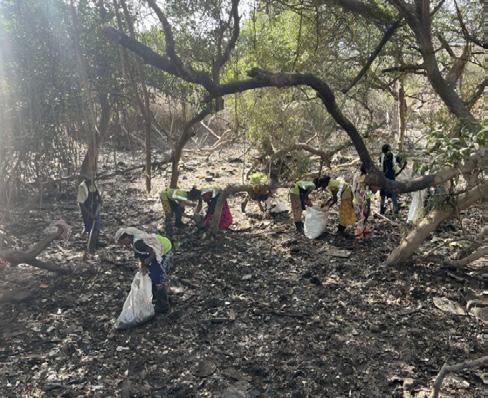
2.4 The diversity of mangroves
Towards an authoritative list of the world’s mangrove plants.
Norman C. Duke (James Cook University and IUCN Mangrove Specialist Group) and Shing Yip Lee (The Chinese University of Hong Kong and IUCN Mangrove Specialist Group)
16 Ghosh, A., Saha, R., Bhadury, P. (2022). Metagenomic insights into surface water microbial communities of a South Asian mangrove ecosystem PeerJ 10:e13169.

Mangrove plants are a range of species from multiple unrelated taxa that typically grow between mean sea and highest astronomical tide levels on tropical and subtropical shorelines worldwide17. Generally, these plants have well-recognized features with highly specialized morphological and physiological adaptations for living in the harsh conditions of marine coastal environments. But, because of the variability amongst these characteristics, the current world list of mangrovespecific plants (see Table 2) is, to some degree, still subjective and incomplete. There is a great need for an updated, authoritative list of the world’s mangrove plants, but producing such a list presents at least four major challenges.
Firstly, there are no unequivocable criteria for defining a plant as a mangrove. The plants are united by their dominance and natural occurrence in the tidal wetland niche. Even here, opinions vary, and there are questions surrounding habitat-specificity. Is the plant specific to the mangrove niche, or is it an associate plant with greater presence elsewhere?
Secondly, there are co-inhabitants of this tidal niche. Although shorter in stature, tidal marsh plants are found alongside mangroves in tropical and subtropical locations (see Section 2.5), and come to dominate this niche in temperate latitudes. So, there are questions surrounding the distinction between mangroves and tidal marsh species.
Thirdly, there are newly described species and sub-specific forms18, showing that our phytobiogeographical knowledge is still incomplete, even in populated locations.
17 Duke, N.C. (2017). Mangrove floristics and biogeography revisited: further deductions from biodiversity hot spots, ancestral discontinuities, and common evolutionary processes. In: Mangrove Ecosystems: A Global Biogeographic Perspective. Structure, Function, and Services. V. H. Rivera-Monroy, S.Y. Lee, E. Kristensen and R.R.Twilley, Springer. 2: 17-53.
18 Duke, N.C. (2020). A systematic revision of the vulnerable mangrove genus Pelliciera (Tetrameristaceae) in equatorial America Blumea 65: 107120.
Duke, N.C. and H. Kudo. (2018). Bruguiera × dungarra, a new hybrid between mangrove species B. exaristata and B. gymnorhiza (Rhizophoraceae) recently discovered in north-east Australia. Blumea 63: 279-285.
Over the last half century, 11 severe tropical cyclones damaged mangrove forests along Australia’s northeastern coast. The severity and the frequency of severe cyclones has increased appreciably in the last decade. © Norman C. Duke.
United Way Mumbai has engaged 70 laborers to clean mangrove areas in Mumbai Metropolitan Region, India. Since 2022, it has cleared 346 metric tons of non-biodegradable waste from mangrove areas which was sent for recycling and co-processing. © United Way Mumbai.



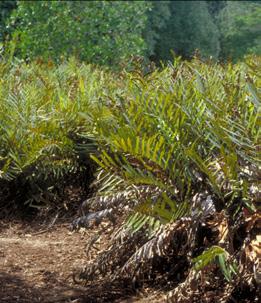
A
plant is a
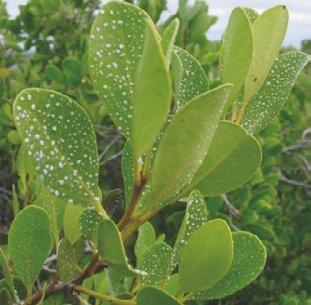

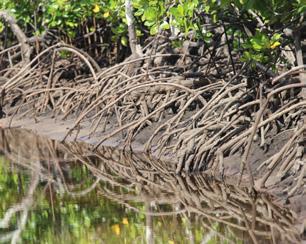
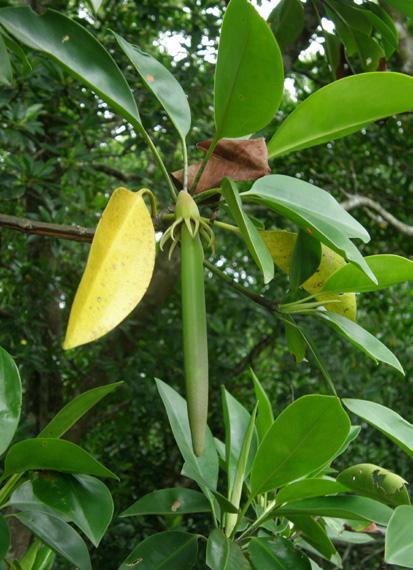
Finally, further taxonomic questions arise around intermediate species within three genera. These have been referred to as hybrids, but in many cases this determination remains unproven18, or the classification of hybrid status had not been recognized19. This is significant since the categorization of ‘hybrid’ in the IUCN Red Listing process means that these commonly recognizable entities are passed over. Given that so-called hybrid entities dominate numerous mangrove stands, overlooking them could have a considerable impact on the new process for the Red Listing of Mangrove Ecosystems.
The international group focused on resolving these issues is the IUCN Mangrove Specialist Group (MSG). The MSG, with its collective expertise in mangrove plant biogeography and taxonomy, will act as the authority and arbiter of the agreed list of mangrove species. The list shown in Table 2 can be viewed as the precursor18,20 Meanwhile, a working group within the MSG has been convened to generate an agreed list, which will undoubtedly have considerable overlaps with the precursor list, but may also lead to some additions or removals. The IUCN MSG website will be updated as this work proceeds.
19 Cooper, W.E., Kudo, H. and Duke, N.C. (2016). Bruguiera hainesii C.G.Rogers (Rhizophoraceae), an endangered species recently discovered in Australia Austrobaileya 9(4): 481-488.
20 Duke, N.C., Virly, S. and Tracey. D. (2023). New Caledonian mangroves. A treasure to protect. Currumbin, Queensland Australia, James Cook University & MangroveWatch Publications, 210 pages. ISBN: 9780992365929
Some of the distinctive attributes associated with many mangrove species include: exposed above -ground breathing roots; extra trunk support structures; salt-excreting leaves; low water potentials and high intracellular salt concentrations for maintaining favourable water relations in saline environments; and viviparous, water-dispersed propagules grown while attached to the parent plant. Several of these features are illustrated in the photos, above.

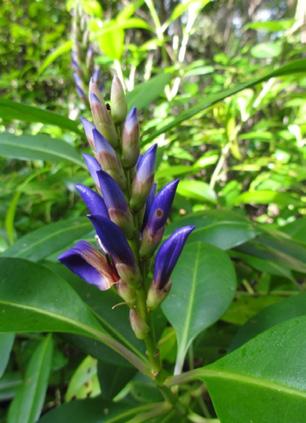
Left: Salt-excreting leaves of Aegiceras.© Norman C. Duke.
Top middle: Pencillike breathing roots or pneumatophores of Sonneratia.
Bottom middle: Sprawling prop roots of Rhizophora.
Right: Naked vivipary in Bruguiera. © Mark Spalding, TNC.
mangrove
tree, shrub, palm or ground fern, generally exceeding half a meter in height, that normally grows above mean sea level in the intertidal zone of marine coastal environments and estuarine margins. © Mark Spalding, TNC.
The striking difference in flower color between subspecies of Acanthus ebracteatus, subsp. ebracteatus (left) and subsp. ebarbatus (right), warrants further characterisation. It is possible these entities are two different species. © Norman C. Duke.
Table 2. The 2024 authoritative list of all mangrove taxa in the world (updated from Duke (201717), Duke (2020); Duke & Kudo (2018); Duke et al. (2023)18,20), including species and nominal hybrids, for the two global subregions. The Indo West Pacific (IWP) stretches from east Africa and the Middle East to the central Pacific Ocean, while the Atlantic East Pacific (AEP) includes all coasts of the Americas and west and central Africa. Notes: 1) current sub-specific taxa are inset; and 2) regions with introduced taxa are marked with an asterisk. See also Table 3 for a summation of taxonomic rankings by subregion.
e
1 Acanthus ebracteatus Species Acanthaceae IWP
Acanthus ebracteatus subsp. ebracteatus Subspecies Acanthaceae IWP
Acanthus ebracteatus subsp. ebarbatus Subspecies Acanthaceae IWP
2 Acanthus ilicifolius Species Acanthaceae IWP
3 Acrostichum aureum Species Pteridaceae IWP/ AEP
4 Acrostichum danaeifolium Species Pteridaceae AEP
5 Acrostichum speciosum Species Pteridaceae IWP
6 Aegialitis annulata Species Plumbaginaceae IWP
7 Aegialitis rotundifolia Species Plumbaginaceae IWP
8 Aegiceras corniculatum Species Primulaceae IWP
9 Aegiceras floridum Species Primulaceae IWP
10 Avicennia alba Species Acanthacaeae IWP
11 Avicennia bicolor Species Acanthacaeae IWP
12 Avicennia germinans Species Acanthacaeae IWP
13 Avicennia integra Species Acanthacaeae IWP
14 Avicennia marina Species Acanthacaeae IWP/AEP*
Avicennia marina var marina Variety Acanthacaeae IWP
Avicennia marina var. australasica Variety Acanthacaeae IWP/AEP*
Avicennia marina var. eucalyptifolia Variety Acanthacaeae IWP
15 Avicennia officinalis Species Acanthacaeae IWP
16 Avicennia rumphiana Species Acanthacaeae IWP
17 Avicennia schaueriana Species Acanthacaeae IWP
18 Barringtonia racemosa Species Lecythidaceae IWP
19 Brownlowia tersa Species Malvaceae IWP
20 Bruguiera cylindrica Species Rhizophoraceae IWP
21 Bruguiera dungarra Hybrid Rhizophoraceae IWP
22 Bruguiera exaristata Species Rhizophoraceae IWP
23 Bruguiera gymnorhiza Species Rhizophoraceae IWP
24 Bruguiera hainesii Hybrid Rhizophoraceae IWP
25 Bruguiera parviflora Species Rhizophoraceae IWP
26 Bruguiera rhynchopetala Hybrid Rhizophoraceae IWP
27 Bruguiera sexangula Species Rhizophoraceae IWP
28 Camptostemon philippinense Species Malvaceae IWP
29 Camptostemon schultzii Species Malvaceae IWP
30 Ceriops australis Species Rhizophoraceae IWP
31 Ceriops decandra Species Rhizophoraceae IWP
32 Ceriops pseudodecandra Species Rhizophoraceae IWP
33 Ceriops tagal Species Rhizophoraceae IWP
34 Ceriops zippeliana Species Rhizophoraceae IWP
35 Conocarpus erectus Species Combretaceae IWP*/AEP
36 Crenea patentinervis Species Lythraceae AEP
37 Cynometra iripa Species Fabaceae IWP
38 Diospyros littorea Species Ebenaceae IWP
39 Dolichandrone spathacea Species Bignoniaceae IWP
40 Excoecaria agallocha Species Euphorbiaceae IWP
Excoecaria agallocha subsp. agallocha Subspecies Euphorbiaceae IWP
Excoecaria agallocha subsp. ovalis Subspecies Euphorbiaceae IWP
41 Heritiera fomes Species Malvaceae IWP Spp.no.
42 Heritiera littoralis Species Malvaceae IWP 43 Kandelia candel Species Rhizophoraceae IWP
Kandelia obovata Species Rhizophoraceae IWP 45 Laguncularia racemosa Species Combretaceae AEP 46 Lumnitzera littorea Species Combretaceae IWP
Lumnitzera racemosa Species Combretaceae IWP 48 Lumnitzera rosea
AEP
62 Rhizophora lamarckii Hybrid Rhizophoraceae IWP
63 Rhizophora mangle Species Rhizophoraceae IWP*/AEP
64 Rhizophora mucronata Species Rhizophoraceae IWP
65 Rhizophora racemosa Species Rhizophoraceae AEP
66 Rhizophora samoensis Species Rhizophoraceae IWP/ AEP Rhizophora samoensis var. neocaledonica Back-cross hybrid Rhizophoraceae IWP
67 Rhizophora selala Hybrid Rhizophoraceae IWP
68 Rhizophora stylosa Species Rhizophoraceae IWP
69 Rhizophora tomlinsonii Hybrid Rhizophoraceae IWP
70 Scyphiphora hydrophylacea Species Rubiaceae IWP
71 Sonneratia alba Species Lythraceae IWP
72 Sonneratia apetala Species Lythraceae IWP
73 Sonneratia caseolaris Species Lythraceae IWP
74 Sonneratia griffithii Species Lythraceae IWP
75 Sonneratia gulngai Hybrid Lythraceae IWP
76 Sonneratia hainanensis Hybrid Lythraceae IWP
77 Sonneratia lanceolata Species Lythraceae IWP
78 Sonneratia ovata Species Lythraceae IWP
79 Sonneratia urama Hybrid Lythraceae IWP
80 Tabebuia palustris Species Bignoniaceae AEP
81 Xylocarpus granatum Species Meliaceae IWP
82 Xylocarpus moluccensis Species Meliaceae IWP
Table 3. Broad numbers of taxa for families, genera, species, and nominal hybrids in the two global subregion hotspots of the world, the Indo West Pacific (IWP) and the Atlantic East Pacific (AEP). Taxa are listed in Table 2.
2.5 Adjacent ecosystems
A more powerful case for more effective conservation can be made through a richer understanding of the links between mangroves and other ecosystems.
Lindsey S. Smart, (The Nature Conservancy (TNC)), Thomas A. Worthington (University of Cambridge)

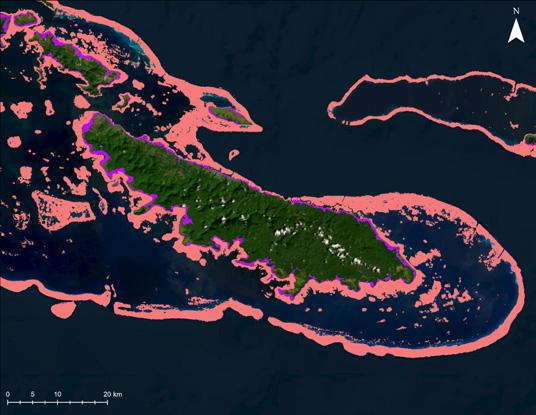
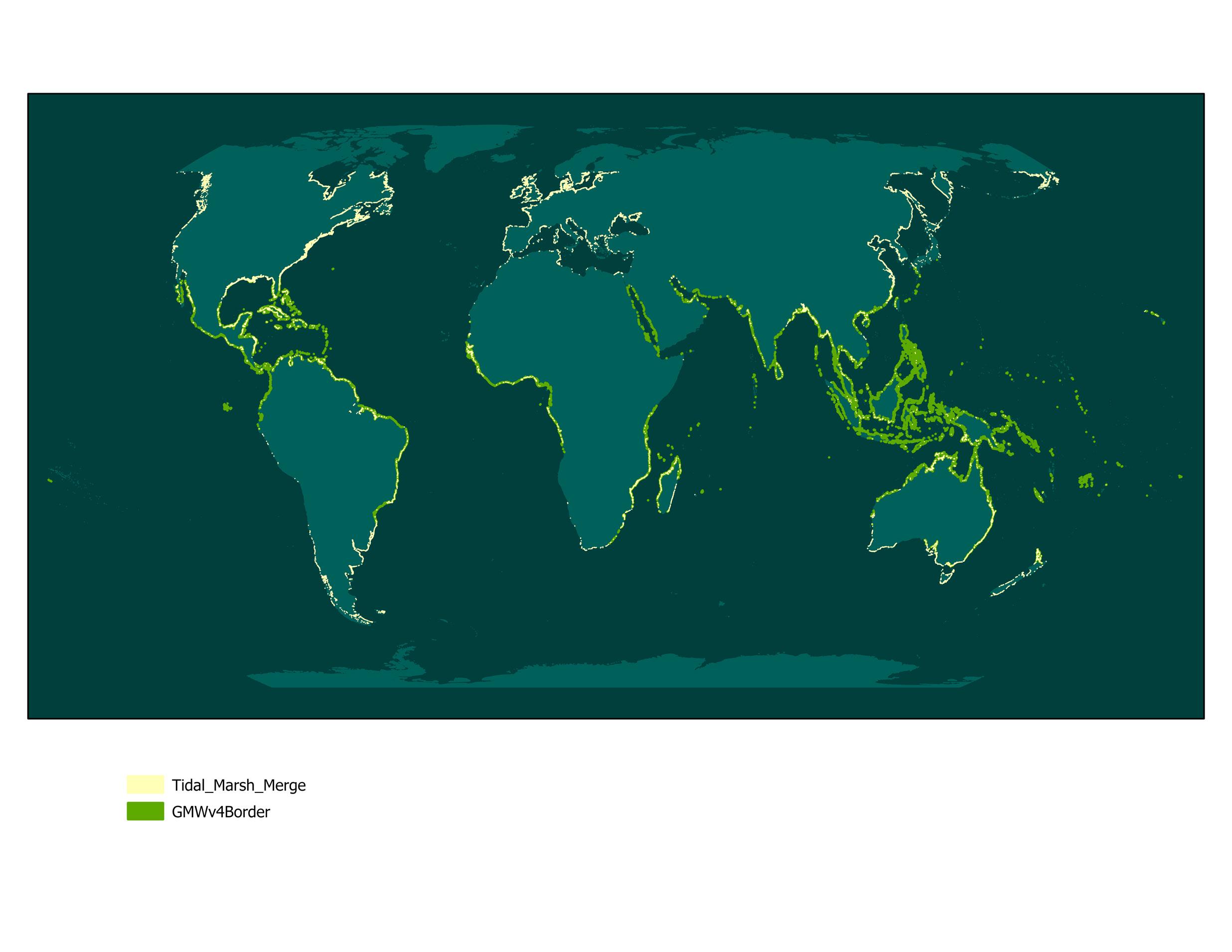
Tidal Marsh Extent
Mangrove Extent
Tidal marsh
Seagrass (Sparse)
Seagrass (Dense) Mangrove Coral reef
Tidal Marsh
Seagrass
Mangroves
Florida Coral Reef PNG Coral Reef
Links to map layers
South Florida Tagula Island (Papua New Guinea)
Figure 14 : Global map of tidal marshes.
The state of mangroves

low-latitude tidal marshes.
Seagrass
Seagrasses are marine flowering plants that extend from the lower intertidal into fully submerged waters. Despite the challenges of identifying submerged features from remote sensing, our knowledge of seagrass extent is rapidly improving as data becomes more accessible and as new technologies for underwater mapping develop. Even so, most mapping efforts to date are at local or regional scales, leaving significant uncertainty around the global extent of seagrass and limiting our ability to understand the magnitude of their benefits for humans and climate change mitigation.
One such regional effort currently underway is the Caribbean Carbon Accounting in Seagrass (CariCAS) network, a collaborative team of non-governmental organizations, universities, and local partners. With the
Within the coastal zone, mangroves form a complex mosaic with adjacent ecosystems, such as tidal marshes, seagrass meadows, tidal flats, and coral reefs. As such, it is often difficult to fully determine where one ecosystem starts and another ends. Both the definition, and the mapping, of these ecotones can be particularly challenging. The spatial configuration of these different ecosystems has an important effect on ecosystem functioning, impacting how nutrients and species move across the seascape. For example, the presence of mangroves influences the community structure of fishes on nearby coral reefs, with connectivity doubling the biomass of some commercially important species21. It follows that impacts to one ecosystem will likewise drive wider changes.
While there has been considerable research effort in large-scale mapping and modeling of different aspects of mangrove ecosystems, including extent and change, structure, and ecosystem service delivery, our knowledge of equivalent global-scale patterns for many of the other coastal ecosystems is more limited. However, this is changing with the availability of extensive open-access libraries of remote sensing imagery and more powerful computing platforms.
Tidal marshes
The first globally consistent tidal marsh distribution map was released in 202322. Based on 10-meter (m) resolution radar and optical imagery from the European
21 Mumby, P. J., Edwards, A.J. , Arias-González, J.E., Lindeman, K.C. , Blackwell, P.G., Gall, A. ,. Gorczynska, M.L., Harborne, A.R. et al. (2004). Mangroves enhance the biomass of coral reef fish communities in the Caribbean. Nature 427:533-536.
22 Worthington, T. A., Spalding, M., Landis, E., Maxwell, T. L., Navarro, A., Smart, L.S. and Murray. N.J. (2024). The distribution of global tidal marshes from Earth observation data Global Ecology and Biogeography: e13852.
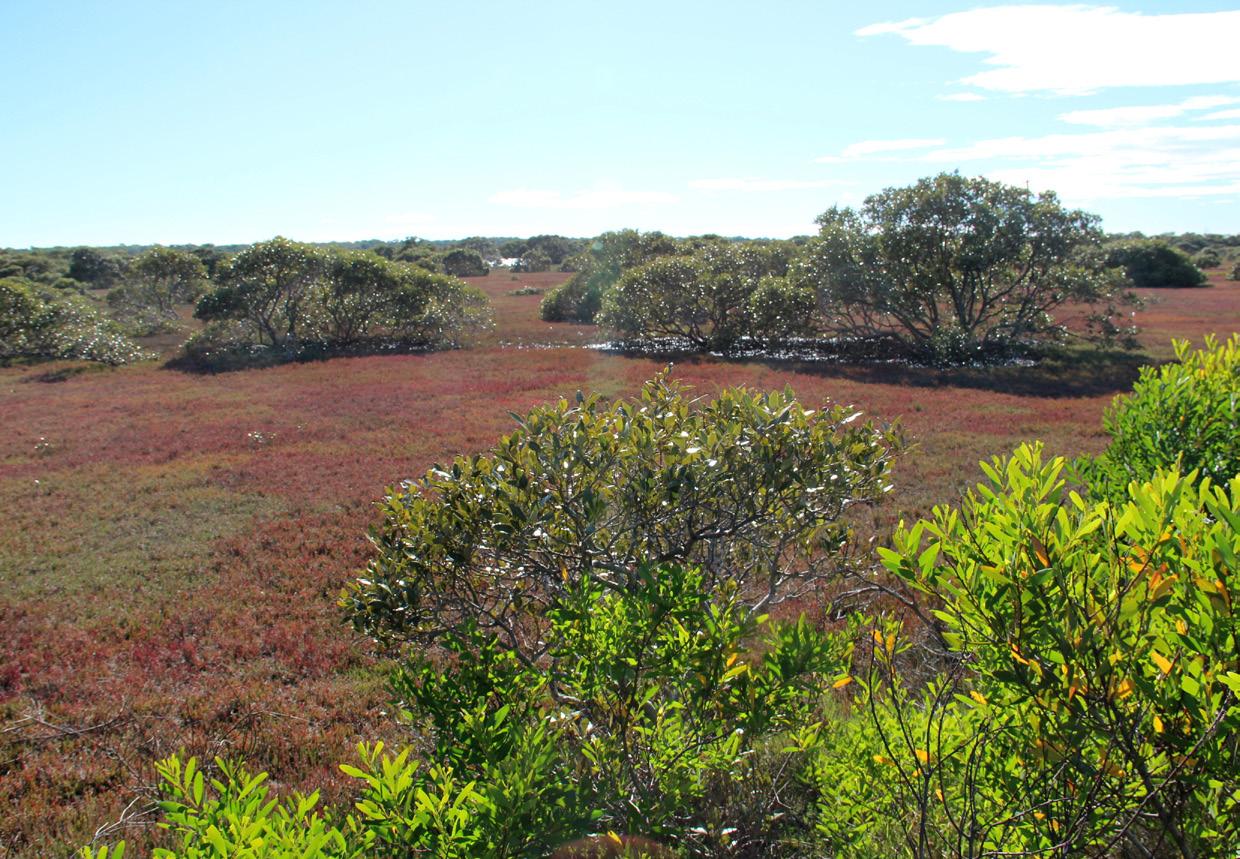
and tidal marsh plants growing together in Towra Point Nature Reserve, near Sydney, Australia. © Mark Spalding, TNC.
The tight ecological connections between seagrass and mangroves are clearly illustrated by the movements of young fish between these ecosystems. Photo © Mark Spalding, TNC.
Mangroves
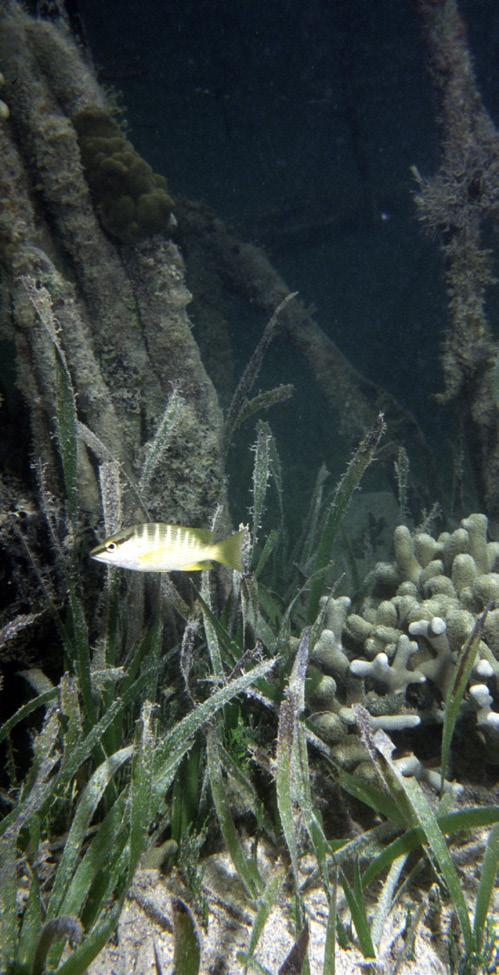
intention to better understand the importance and distribution of blue carbon, the network supports field data collection on seagrass carbon stocks, catalyzes further seagrass research, and is helping to develop a regional map of seagrass extent and carbon stocks across the Caribbean.
The network has engaged 26 different organizations across 20 countries and has doubled the known data on seagrass carbon stock data in the region. Preliminary analyses from these new datasets suggest that Caribbean seagrasses typically store more organic carbon than the global average23.
By simultaneously mapping the habitat and using this data in the development of spatially explicit seagrass carbon stock maps, a more powerful case for conservation can be made. This may be critical given the alarming rates of decline in seagrass systems24, and the urgency of actions to mitigate climate change.
Other ecosystems
Coral reefs are distributed throughout the tropics and, in many countries, can be found near mangroves. The Allen Coral Atlas provides an updated understanding of the extent of coral reefs globally. Developed from high-resolution (3.7 m) Planet Dove data, in addition to mapping reef extent, The Allen Coral Atlas also provides information on the benthic habitats and geomorphic zones that make up the reef area, as well as threats to coral reefs, such as bleaching or turbidity.
Tidal flats typically are unvegetated ecosystems that lie lower in the tidal frame than coastal wetlands (both mangroves and tidal marshes) and data on the
23 Kennedy, H., Pagès, J. F., Lagomasino, D., Arias-Ortiz, A., Colarusso, P. Fourqurean, J. W. Githaiga, M.N., Howard, J.L. (2022). Species Traits and Geomorphic Setting as Drivers of Global Soil Carbon Stocks in Seagrass Meadows Global Biogeochemical Cycles 36:e2022GB007481.
24 Dunic, J.C., Brown, C.J., Connolly, R.M., Turschwell, M.P., and Côté. I.M. (2021). Long-term declines and recovery of meadow area across the world’s seagrass bioregions. Global Change Biology 27:4096-4109.
Many efforts at mangrove restoration have been misguidedly placed in some of these adjacent ecosystems.
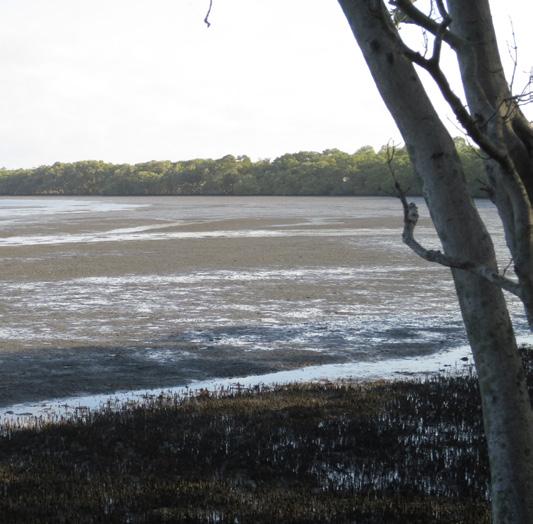
distribution and change in tidal flats has also been updated, with the latest data available through to 201925. They are extensively distributed across the world’s coastlines but have undergone significant loss, degradation, and fragmentation due to human activities. Tidal flats provide significant benefits, such as carbon storage and storm protection, and are critical habitats for many globally threatened shorebirds.
Many efforts at mangrove restoration have been misguidedly placed in some of these adjacent ecosystems, notably on tidal flats and shallow seagrass systems, where tidal flooding prevents the natural
establishment of mangrove trees. Such efforts are often unsuccessful with low survival rates of seedlings, and they can also damage these valuable adjacent ecosystems. Mangrove conservation and restoration activities need to ensure that ecosystems adjacent to mangroves are incorporated into projects. This will require thinking more holistically about conserving multiple ecosystems and their connectivity across the seascape.
25 Murray, N.J., Phinn, S.P., Fuller, R.A. DeWitt, M., Ferrari, R., Johnston, R., Clinton, N., & Lyons., M.B. (2022). High-resolution global maps of tidal flat ecosystems from 1984 to 2019 Scientific Data 9, 542.
Coral, seagrass and mangrove growing together on the barrier reef system of Jardines de la Reina, Cuba.
Photo © Mark Spalding, TNC.
Tidal flats are widespread in lower tidal areas below mangroves and tidal marsh, as seen here on the edges of Moreton Bay Marine Park, Brisbane, Australia. © Mark Spalding, TNC.
3. Connecting to local
3.1 Engaging with Local Ecological Knowledge (LEK) in research and practice
Engaging ethically with LEK may seem a challenge, but thorough guidance is available for researchers and practitioners.
The need to engage with LEK
Local ecological knowledge (LEK)1 can provide vital information to develop mangrove conservation and restoration efforts with greater potential for longterm outcomes. Recently, the Global Mangrove Alliance (GMA) published The LEK Best-Practice Guide which detailed how researchers have examined or incorporated LEK, projects demonstrating numerous ways that LEK improves conservation, and guidance to engage ethically with LEK holders. Despite growing interest in LEK, little guidance existed before this publication to assist researchers and practitioners in engaging with this knowledge ethically and holistically.
The guide aimed to encourage wider inclusion of LEK in mangrove research and projects by:
1. Raising awareness of the variety and scope of LEK about mangrove ecosystems.

2. Highlighting the value that LEK can bring to mangrove conservation and restoration.
3. Encouraging increased engagement of LEK in projects.
4. Emphasizing the importance of equitable collaboration.
The vast scope of LEK
Projects and research that have studied or included LEK illustrate the wealth of knowledge to be learned from LEK holders if they wish to share it (e.g., historical mangrove
Scientific information blended with the traditional knowledge of Indigenous groups is crucial in communicating and implementing long-term ecosystem restoration plans. © WWF-Philippines.
extent, the drivers of loss, and tenure laws (Figure 15)). Although LEK holders have sometimes been included in research, researchers have more often simply asked them to share their knowledge, typically of benefits and threats to mangroves. Such approaches only scratch the surface of vast local knowledge available, which includes many other issues, such as climatic and seasonal changes (Figure 15).
Kerry E. Grimm (Human-Environment Connections), Camilo Andres Arrieta Giron (Leibniz Centre for Tropical Marine Research (ZMT) GmbH), Jaona Ravelonjatovo and Cicelin Rakotomahazo (Blue Ventures), Levis Sirikwa (Ceriops), Giovanny Diaz (Community Leader Montecristo Island), Bruna Martins (Rare and Green July), Nilson Cardoso (Assuremas), Mailton Santos (Aurem cm-g), Renilde Piedade (Auremoca)
1 LEK is here defined as: “knowledge, practices, and beliefs gained through extensive personal observation of, and interaction with, local ecosystems, and shared among local resource users” based on; Charnley, S., Fischer, A.P., Jones, E.T. (2008) Traditional and Local Ecological Knowledge About Forest Biodiversity in the Pacific Northwest. Technical Report. U.S. Department of Agriculture, Forest Service, Pacific Northwest Research Station. 52 p.
2 Grimm, K., Spalding, M., Leal, M., Kincaid, K., Aigrette, L., Amoah-Quiminee, P., et al. (2024) Including Local Ecological Knowledge (LEK) in Mangrove Conservation and Restoration: A Best-Practice Guide for Practitioners and Researchers. Global Mangrove Alliance.
LEK has also informed on-the-ground projects (Figure 16). Some of these have benefitted considerably from LEK holders who have shared information on topics ranging from hydrological conditions and changes, which have informed planning for building channels, to traditional calendars that timed restoration activities.
How to engage with LEK?
Knowing how to engage ethically with LEK can be daunting. Here is some initial guidance (Figure 17), which is more thoroughly covered in the LEK BestPractice Guide, as well as suggestions from those who have engaged with LEK.
• Throughout all project stages, respect cultural norms and collaborate and share information with knowledge holders.
• In pre-project planning, learn who is “local,” including those outside immediate areas or who may be typically excluded.
• Identify the diversity of LEK that can inform projects.
• Conduct work ethically (e.g., with consent) and inclusively by exploring ways to co-produce work.
• During implementation, engage LEK holders frequently and incorporate feedback and insights.
• Validate analyses with LEK holders.
• Monitor work and processes, adapting when necessary.
• Acknowledge local partners as owners of the knowledge.
• Ensure the work can continue, serve as a model, and empower the community.
• Avoid “parachute” science3, where information and results are not shared back with LEK holders, and where contributors receive few benefits from sharing their knowledge.
The Guide implemented best practices as it was developed. Case studies required local contributors. The guide was co-revised to ensure knowledge was accurately represented. Over 100 people involved were co-authors.
Scientists, practitioners, and LEK holders who have engaged with or shared LEK are vital sources of guidance (See Case Study boxes 1-5). These contributors to the Guide said that consistent communication, flexibility, mutual trust-building, and community engagement in all phases are the keys to successfully addressing challenges and strengthening projects. LEK holders appreciated recognition of their knowledge, and emphasized that projects should work with local entities, promote projects for future generations, and invest in connections to community knowledge and practices.
3 Stefanoudis, P.V., Licuanan, W.Y., Morrison, T.H., Talma, S., Veitayaki, J., & Woodall, L.C. (2021) Turning the tide of parachute science. Current Biology 31:161–185.
Opening our eyes to the vast world of LEK
Some groups remain disproportionately underrepresented in LEK research and initiatives. Women often have a close connection to mangroves, collecting coastal species or observing family health changes from decreased water quality4. This knowledge is too often overlooked, with fishers or those in positions of authority, often men, given more focus.
LEK can also extend beyond “ecological” knowledge to include local information vital for successful, inclusive projects. Insights into local communities can identify
underrepresented groups who would make valuable partners. A better understanding of communities’ needs can shape projects to produce increased benefits5 .
Inclusion and recognition of LEK are crucial and can mean much to those involved. One local contributor from Brazil was grateful to share their story in the Guide and was surprised by the international attention it received. We need to go beyond an interest in LEK – and make it the norm for mangrove work.
LEK experiences of
a researcher and project developer
Jaona Ravelonjatovo, Cicelin Rakotomahazo (Blue Ventures)
Inclusion of LEK:
We work with coastal communities to rebuild fisheries and restore ocean life. One of our core values is “Community first,” which contributes to our vision of “Thriving fishers, thriving oceans.” Engaging with LEK in research offers a unique opportunity to tap into empirical wisdom and insights from local communities’ long-standing relationships with their environment. It provides a historical and deep understanding of complex processes that influence mangroves and traditional resource use. Local perceptions can inform adaptive restoration strategies.
Challenges:
Communication and language barriers can exist between the local stakeholders and the researchers and project developers.
Successes:
Mangroves and associated resources in Madagascar’s Baie des Assassins are recovering as part of a Blue Ventures project. LEK helped inform the development of the project at all stages. It increased the effectiveness and efficiency of conservation and restoration initiatives in the area, contributed to securing management rights, and reduced exploitation. Including cultural aspects, such as rituals, fostered support, ownership, and participation of diverse groups led to overall management success.
Advice:
Incorporating LEK, including through participative research, can help address conservation and restoration challenges. Building trust and fostering mutual partnerships with local communities are key steps in research projects.
LEK experiences of a researcher
Camilo
Inclusion of LEK:
Our sea4soCiety project explores how a mangrove reestablishment strategy in Baru, Colombia, could integrate community-driven insights for a potential ecosystem co-design project. Locals shared their needs, expectations, challenges, and knowledge about, but not limited to, mangrove species, uses, health, and replanting efforts.
Challenges:
4 de la Torre-Castro, M. Fröcklin, S. Börjesson, S., Okupnik, J., Jiddawi, N.S. (2017) Gender analysis for better coastal management – Increasing our understanding of social-ecological seascapes Marine Policy 83 (2017) 62–74.
5 Grimm, K.E., Archibald, J.L, Axelsson, E.P, & Grady, K.C. (In review) Moving Social-Ecological Restoration Forward: How mangrove project managers’ perceptions of social monitoring and community engagement serve as a model for broader restoration efforts. Restoration Ecology
Challenges included overcoming distrust and research fatigue due to previous experiences of unrealistic promises and expectations, where science provided no clear benefit. Socioeconomic characteristics led to partial non-participation due to unclear incentives for their time. Responses often focused more on interests and expectations than actual needs.
Successes:
Research (ZMT) GmbH)
Success was achieved by ensuring that all voices were heard equally within a multi-stakeholder approach. This built trust and allowed for networking and improved communication between individuals who rarely interact.
Advice:
It is crucial to prioritize early and consistent communication, remain flexible to adjust strategies based on local feedback, and set clear expectations and engagement goals. Building a foundation of mutual trust is essential to empowering key stakeholders who can effectively address challenges that arise when engaging with LEK.
Figure 17. Ways to engage ethically with local ecological knowledge and knowledge holders throughout a project or research.
Andres Arrieta Giron (Leibniz Centre for Tropical Marine
LEK experiences of a practitioner
Levis Sirikwa (Ceriops)
Inclusion of LEK:
Mangroves have been integral to Kenyan Indigenous coastal livelihoods for generations, playing diverse and significant roles that are deeply ingrained in local culture. In our restoration projects, LEK informed us about degradation drivers, flooding dynamics, and which species to plant.
Challenges:
Challenges include a lack of authentication, subjective approaches to knowledge sharing, and inadequate information management systems. Practitioners should compare LEK with other information and success stories, prioritizing knowledge that aligns with natural systems in a localized context.
Successes:
2,000 mangrove seedlings planted in a degraded area at Mwakirunge have achieved a >97% success rate. LEK was fundamental to the restoration practices, especially for site matching, selecting species, and timing the planting.
Advice:
Practitioners should consult resources, such as GMA’s LEK Best-Practice Guide, to learn from case studies that demonstrate successful applications of LEK in various geographical contexts. Integrating LEK into mangrove restoration requires a balanced approach that respects traditional knowledge, ensures alignment with local ecological realities, and fosters collaboration with nature.
LEK experiences of community members
Bruna Martins (Rare and Green July), Nilson Cardoso (Assuremas), Mailton Santos (Aurem cm-g), Renilde Piedade (Auremoca)
Green July is a grassroots campaign, supported by Rare, that celebrates mangroves along Brazil’s Amazon Coast. Rare incorporated LEK into the initiative.
LEK contributors said they experienced a sense of appreciation for their practices and knowledge, and a sense of belonging to the territory. Nilson Cardoso (65), fisher and community leader, explained: “When I have the opportunity to show my knowledge, I feel flattered, proud. I am proud that my classroom has been the mangrove, the streams. Everything I know was observed from nature, and that has value.”
This feeling generates a pulling force that drives the engagement and effective participation of campaign members in defending their territory, the Amazonian mangroves.
According to leader Mailton (26): “I feel extremely like a protagonist in our history and motivated to defend the mangroves.”
Extractivist6 Renilde Piedade (42) states that much investment is needed to “connect and articulate the knowledge and practices of communities. Together, we are stronger, and we need more resources to continue our mission.” The valorization of local knowledge is essential to strengthen community engagement and contribute to the preservation of mangroves.
LEK experiences of
community members
Giovanny Diaz (Community Leader Isla Montecristo)
On El Salvador’s Isla Montecristo, the Mangrove Forest Restoration project (REM) has seen success after many attempts to save the forest.
Local knowledge has been, and will continue to be, necessary and strategic in ecosystem recovery, since the community best knows our island’s history and the experiences passed down through our leaders from one generation to the next. The community holds the memories of the mangrove forest conditions. This information is key to intervene in problems that affect the forest without causing secondary harm.
Being part of this project fills us with joy, because of the value placed on the efforts and dedication of Isla Montecristo families to protect the area’s resources. It is satisfying and important to know that people who have academic training in the subject still take into account the opinion of the locals, which commits us to continuing our efforts.
When we first heard about REM it was a weird thing to us; breaking the mold is the most difficult thing that exists in a society. Going from harvesting and sowing candelilla to desilting canals was a sharp turn! Throughout the process, getting the entire community involved was a complex task. The workplan was the biggest challenge because we had to adapt to new skills and the use of tools such as boats with motors, chainsaws, and ropes.
We have accomplished much, but more work on maintenance and securing resources remains. I also recommend raising awareness of efforts in schools to promote the continuation of projects within future generations, and to link with other entities involved with local development.

Invasive oysters
Marília Cunha-Lignon and members of the Brazilian IAS network*1
The oyster Saccostrea cucullata, from the Indo-Pacific, was first recorded in Brazil in 2014. This invasive alien species (IAS) is increasing its distribution, competing with the native mangrove oyster Crassostrea brasiliana, and causing social-ecological impacts. We formed a multi-stakeholder network as a strategy to combat IAS in mangrove areas. It is the first Brazilian IAS network involving local communities, researchers, and state and federal institutions. Supported by public conservation policies, together we diagnose, monitor, and control S. cucullata, suggesting interventions in a collaborative process guided by local knowledge, social-ecological demand, science, and citizenship.
Invasive oysters Saccostrea cucullata competing for space with native mangrove oysters Crassostrea brasiliana in Rhizophora mangle.
© Marília Cunha-Lignon
6 Extractivist is a Portuguese term for a political social movement in Brazil that many of the community members in the RESEX areas identify as. In this case, Renilde is also a traditional community leader.
* Marília Cunha-Lignon, Beatriz Eiko Kitagami; Caio Tancredi Zmyslowski; Andréa Pimenta Ambrozevicius, Marcela Bergo Davanso, Laís Coutinho Zayas Jimenez, Guilherme Casoni da Rocha, Dariane Beatriz Schoffen Enke, João Roberto Gonçalves Leal, Francisco de Sales Coutinho Mandira, Sidnei Coutinho, Vânia Cristina Rodrigues Maia, Eliel Pereira de Souza, Francisco José Reyes Sánchez
Photo:
3.2 Connecting across scales
Field data not only improves the accuracy of models at the local scale, but at the global level too.
Suvarna Punalekar and Steven Canty (Smithsonian Institution)
One of the most important steps in refining global analyses is to strengthen the role of field-based inputs.
Global models and datasets have been critical in understanding the dynamics of mangrove ecosystems, from mangrove cover and fisheries production, to carbon stocks. In turn, these global products are key toolsets in driving international policies, strategies and targets, for example, under the Sustainable Development Goals, the Paris Agreement, the Convention on Biological Diversity, as well as the protection and restoration strategies of the GMA.
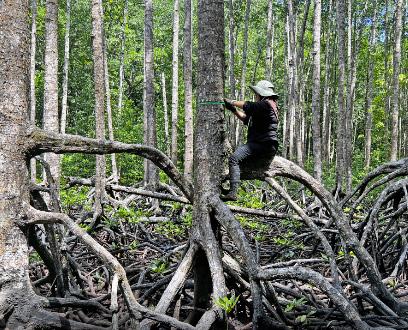
In fact, many countries without national models rely heavily on global products for monitoring progress towards various targets. Acknowledging the crucial role that global-level analyses play or can play across global, regional, and national levels, it is important to evaluate their quality and applicability across a wide range of geographies, environmental gradients, and socioeconomic scenarios.
All global analyses draw on some knowledge of the actual situation on the ground in particular places, and one of the most important steps in refining global analyses is to strengthen the role of field-based inputs. Field datasets can be as simple as GPS locations that confirm the presence/absence of mangroves. They may extend to species composition, or a detailed quantification of specific attributes, such as carbon stocks or fish abundance.
Every field observation has the capacity to influence the global models and datasets, and more field data from any area implies better model accuracy, not only in that area, but also globally. Field datasets also help in evaluating the existing products from national and regional perspectives. Finally, and most importantly, they support the development of standard terminologies that are consistent across ground-based and modelbased interpretations.
Such standardization (e.g., of mangrove cover) is crucial for achieving uniformity and comparability in nationally reported statistics for mangrove extent, carbon stocks, fisheries production, as well as biodiversity indicators. Similarly, using locally derived field data in evaluations of global products would help countries to understand uncertainties and support more informed national strategies for mangrove protection and restoration.
The pathways for integrating field data into large-scale models can simultaneously increase engagement as local researchers and stakeholders can be part of the upscaling process that makes models and datasets relevant across multiple scales. Collective networks involving data scientists and local stakeholders can identify limitations of the existing global products and encourage targeted efforts for nationally specific improvements. For example, improved national-scale mangrove extent maps can not only provide better area estimates but also support better simulations for carbonand/or fish-stock models, and hence provide better benchmarks for policymakers and local stakeholders to be used in specific management actions.
Coastal Carbon Network
By Steven Canty and Jaxine Wolfe (Smithsonian Institution)
The Coastal Carbon Network (CCN) is a consortium of coastal wetland scientists and practitioners, guided by the Smithsonian Institution. The CCN seeks to catalyze scientific discovery, advance science-informed policy, and improve coastal ecosystem management. It accomplishes this goal by growing iteratively with community feedback, facilitating the sharing of open data and analysis products, offering training in data management and analytics, and quantifying coastal greenhouse gas emissions and storage.
Underpinning the CCN are the data library and the coastal carbon atlas, an open access data repository and interactive web application developed to promote the exploration, query, and download of carbon data from around the world. At present, it has 14,972 data points from 70 countries, with more than 300 researchers and practitioners providing their data. More data is regularly added, with updates occurring quarterly. The continued addition of data increases the ability to improve the quantification of carbon stocks using country-specific data, which informs national inventories and global carbon budgets.
Konservasi Indonesia and the National Research and Innovation Agency (BRIN) conducted mangrove surveys in Berau Bay Coastal Park and adjacent areas. They surveyed 29 mangrove species, and most scored “good” and “moderate” on the Mangrove Health Index. © Hanggar Prasetyo, Konservasi Indonesia.

Members of Hô-üt association in Touho, New Caledonia, in March 2024, testing a new mangrove monitoring protocol, MANRAM, based on a Rapid Assessment Method. This protocol will be available in the “ROM mangroves” app and tested in all French Overseas territories. © Anne Caillaud, IUCN French National Committee.

Mangrove sediment coring in Panama. The data collected will support the country’s Nationally Determined Contribution and be stored within the Coastal Carbon Atlas. Left: Rosa Castillero (University of Panama CCIMBIO-Coiba); middle: Tania Romero (Smithsonian Tropical Research Institute), and right: Stacy Baez (Pew Charitable Trusts). © Jaxine Wolfe (Smithsonian Environmental Research Center).
Identifying their importance, some platforms have already been developed for collecting field datasets. For example, an online tool, coastTrain, is used to source verified mangrove cover locations used in the training and validation of Global Mangrove Watch cover maps. For ecosystem services, the Coastal Carbon Network (see box on previous page) is an excellent example of a multinational network wherein 300 researchers and practitioners from across 70 countries freely share carbon datasets through an open-source platform. This site-level data can be used to not only inform national carbon stocks, but also underpin global mangrove carbon models through the integration of 5,208 data points from across 48 countries.
The potential of citizen science initiatives has proven to be revolutionary in areas of biodiversity monitoring (e.g. iNaturalist).
These existing platforms can further be strengthened by increased participation and knowledge exchange workshops. The potential of citizen science initiatives has proven to be revolutionary in areas of biodiversity monitoring (e.g., iNaturalist). At the other end of the spectrum, more comprehensive data sharing is being encouraged through the Mangrove Restoration Tracker Tool (see Section 6.3).
Field datasets and associated local participation can provide the much-needed feedback mechanism to ensure continual improvements of these products at various scales. Combined with continuing improvements in the resolution and detail of global information sources, notably from remote sensing, this increased connection across scales will ensure that the global products can go beyond their use for estimating global/national statistics and make them useful even for real-time monitoring and management actions.
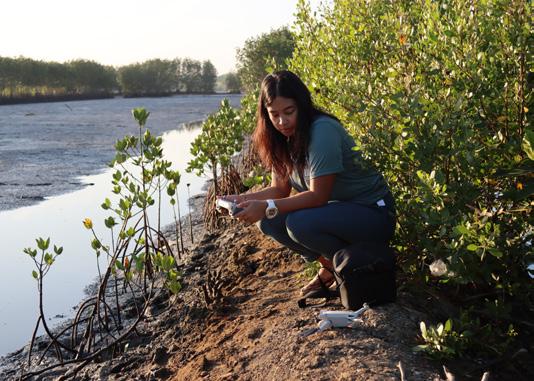
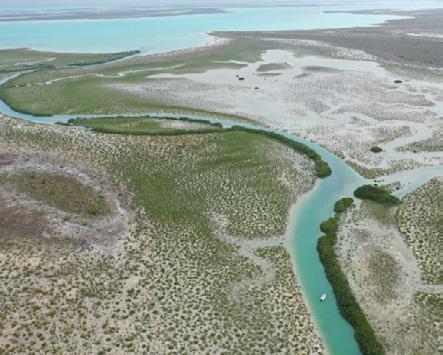
Blue Carbon Explorer
Conservancy (TNC))
TNC launched the Blue Carbon Explorer in April 2023, with support from Planet Labs and the Food and Agriculture Organization of the United Nations (FAO). In the Caribbean, TNC is developing refined maps of mangroves and seagrass using satellite imagery and extensive field data collection. The tool analyzes NDVI (Normalized Difference Vegetation Index, a metric that uses spectral information to assess vegetation condition) information to identify degraded mangroves in need of restoration, and healthy or recovering mangroves in need of protection.
The tool integrates canopy height with NDVI to identify areas of mangrove that are unlikely to recover naturally. This analysis was used to support the development of a mangrove restoration plan for the northern Bahamas in response to the devastation caused by Hurricane Dorian in 2019.
Valerie Pietsch McNulty, Steve Schill (The Nature
Photo: Drone image of the team surveying mangroves in Andros, The Bahamas, in May 2022. © Steve Schill, TNC
Camille Rivera, co-founder and CEO of Oceanus Conservation, using a small drone for monitoring a restoration project in Aringay, La Union, The Philippines. Drones have become valued tools for high-level detail in global and local projects alike.
© Oceanus Conservation & Blue Marine Foundation
4. Benefits of mangroves
4.1 Mangrove blue carbon

A revised model and map provide the latest picture of mangrove soil carbon across the globe.
The rich carbon supplies held in mangrove soils and in their living biomass have already received considerable attention from the global community. If lost, mangroves will likely be a significant source of carbon emissions. But reducing mangrove losses can mitigate emissions, and, unlike most other ecosystems, they will continue to sequester carbon into their dense waterlogged soils.
With support from the Global Mangrove Alliance (GMA), a new global model and map of mangrove soil carbon was released in 20231. As with previous soil maps2, it
relies on field data. However, the new model builds on nearly double the previous information, with over 10,331 samples from 3,299 locations across a much greater geographic spread. The model lowers the total global estimate of mangrove soil carbon across the same map (GMW v3.0).
This new soil map has been combined with the above and below ground carbon biomass estimates from Simard et al.3, as used in the State of the World’s Mangroves 2022. Using the combined map, it can now be
Pete Bunting (Aberystwyth University), Tania Maxwell (University of Cambridge), Tomislav Hengl (Envirometrix), Marc Simard (National Aeronautics and Space Administration (NASA))
1 Maxwell, T.L., Hengl, T., Parente, L.L., Minarik, R., Worthington, T.A., Bunting, P., Smart, L.S., Spalding, M.D., Landis, E. (2023). Global mangrove soil organic carbon stocks dataset at 30 m resolution for the year 2020 based on spatiotemporal predictive machine learning. Data in Brief 109621.
2 Sanderman, J., Hengl, T., Fiske, G., Solvik, K., Adame, M.F., Benson, L., Bukoski, J.J., Carnell, P., (2018). A global map of mangrove forest soil carbon at 30 m spatial resolution. Environmental Research Letters 13, 055002.
3 Simard, M., Fatoyinbo, L., Smetanka, C., Rivera-Monroy, V.H., Castañeda-Moya, E., Thomas, N., Stocken, T.V. der, (2019). Mangrove canopy height globally related to precipitation, temperature and cyclone frequency Nature Geoscience 12, 40 45.
The Marine and Coastal Research Institute (INVEMAR), with Conservation International, Corporación Autónoma Regional del Atlántico (CRA), Grupo Argos, and the communities of Las Flores and Playa conducted blue carbon sampling in Ciénaga de Mallorquín (Colombia) generating recommendations for national statistics. © Sonia Pardo Spiess, INVEMAR.
estimated that approximately 78% of that carbon is associated with the top 1 meter of the soil, 15% with the aboveground biomass of the mangrove forests, and 7% from the belowground biomass. In total, it is estimated that there were 5.89 (2.53 – 6.78) petagrams (Pg) of mangrove carbon in 2020 (4.6 Pg in soil, 0.87 Pg in aboveground biomass and 0.42 in belowground biomass).
As shown in Figure 18, mangroves in southeast Asia (e.g., in Sumatra and Borneo, Indonesia, Malaysia, and Myanmar) have the largest stocks of blue carbon. However, significant stocks were also found within west Africa (e.g., in Nigeria and Guinea-Bissau), Central and South America (e.g., in Mexico, Venezuela, and Colombia) and the Caribbean (e.g., in Cuba).
These global statistics show that mangroves store an average of 394 tonnes of carbon per hectare. Of this figure, 319 tonnes are in soil, 54 tons are in aboveground biomass, and 21 tonnes are in belowground biomass. In
Mangroves store an average of 394 tonnes of carbon per hectare.
Tonnes of Carbon
reality there is considerable regional variation in such carbon storage as illustrated in Figure 19. Regions with the highest mangrove carbon densities are in southeast Asia, and in the Philippines, in particular. The Philippines were found to have regions with carbon densities above 650 tonnes per hectare, while the Middle East was found to have the lowest carbon density with less than 100 tonnes per hectare.
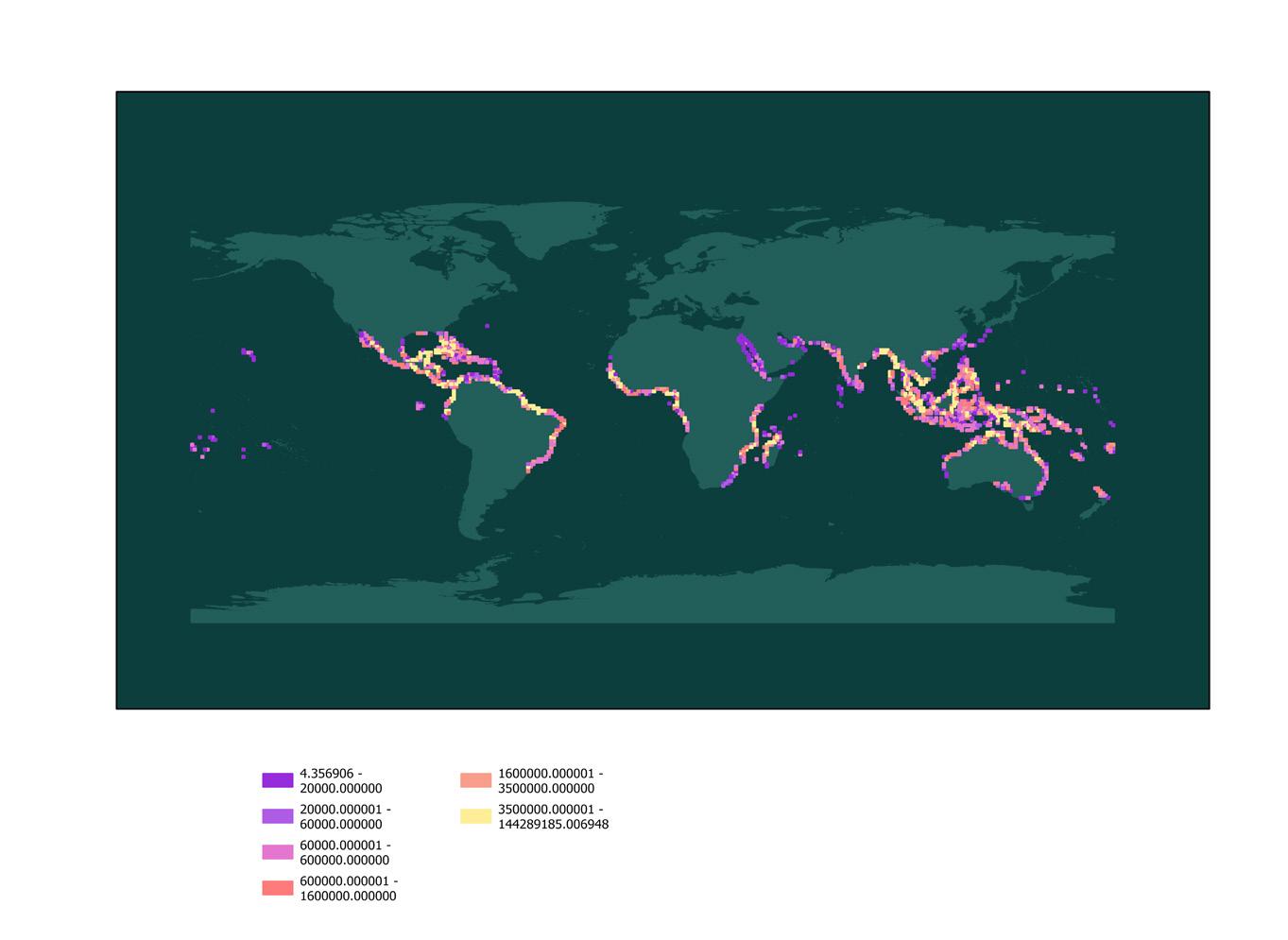


These updated estimates of mangrove blue carbon further solidify mangroves’ role as a nature-based solution for climate mitigation. (See the case study ‘Unlocking Potential’ to read how this climate mitigation benefit can lead to sustainable financing to protect and restore mangrove ecosystems).
Tonnes of Carbon per hectare
In WeForest and Oceanium’s restoration project in Sine-Saloum, Senegal, two flux towers are measuring carbon exchange between growing seedlings and the atmosphere, helping to better understand the ecological benefits of restoring mangroves. © N. Van Ingen.
Figure 18. The spatial distribution of mangrove blue carbon. Bar charts show the sum of total mangrove carbon by latitude (y axis) and longitude (x axis) in millions of tonnes, or megatonnes (Mt).
Figure 19. The average blue carbon in tonnes per hectare. Bar charts show the average carbon density by latitude (y axis) and longitude (x axis).
4.2 Biodiversity in global mangrove ecosystems
The breadth of biodiversity in mangroves remains astonishing, but we need more data at the local and regional scale.
K. Kathiresan (Annamalai University)
Mangrove ecosystems are biologically diverse, due to the diversity of conditions and niches they contain, including forest structures, litter-dominated forest floors, mudflats, and water bodies. Located between land and sea, mangrove ecosystems support both terrestrial and aquatic organisms. They serve as the nursery, feeding, and breeding grounds for crabs, prawns, mollusks, finfish, birds, reptiles, and mammals. Mangroves also possess a variety of microorganisms, making the habitat nutrient-rich and productive.
Tree trunks and complex aerial roots of mangrove forests support oysters, snails, barnacles, crabs, and other invertebrates for shelter and protection from predators.
More than 3,000 insect species have been recorded in Singapore’s mangroves alone5.
In addition, terrestrial fauna, such as insects, amphibians, reptiles, and mammals, take refuge in the mangrove habitats, which also provide them with food4. Insect diversity in mangroves has been shown to be particularly high even when plant diversity is low. More than 3,000 insect species have been recorded in Singapore’s mangroves alone5.
Commercial fisheries in mangrove regions are often highly dependent on both the abundance and the diversity of species that are closely linked with mangroves. One study estimates that approximately one third of all wild fish landings in southeast Asia are mangrove-dependent species6
4 Kathiresan, K., and Bingham. B. L. (2001). Biology of mangroves and mangrove ecosystems. Advances in Marine Biology 40:81-251.
5 Yeo, D., Srivathsan, A., Puniamoorthy, J., Maosheng, F., Grootaert, P. , Chan, L., B. Guénard, Damken, C. (2021). Mangroves are an overlooked hotspot of insect diversity despite low plant diversity. BMC Biology 19:202.
6 Naylor, R.L., Goldburg, R.J., Primavera, J.H., Kautsky, N., Beveridge, M.C.M., Clay, J., Folke, C., Lubchenco, J., Moony, H., Troell, M., (2000). Effect of aquaculture on world fish supplies. Nature 405, 1017–1024.



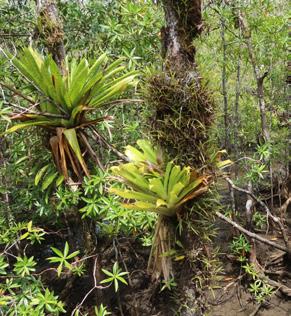
Biodiversity in mangroves
to terrestrial,
and

and orchids.
Monkey, crab and alligator © Lammert Hilarides, Wetlands International. Snapper and plants © Mark Spalding, TNC.
Despite their importance, however, the actual species richness of different mangrove regions in the world remains poorly documented due to the lack of systematic and extensive field surveys.
Little is known about the effects of mangrove loss on biodiversity at local or regional scales. The current IUCN Red List of Threatened Ecosystems describes eleven of the 70 mangrove species (16%) as being at an elevated threat of extinction, especially those on the Atlantic
Among the many characteristic species found in the forest are proboscis monkeys in Borneo, sailfin lizards in the Philippines, and pygmy three-toed sloths in Panama. Mangrove waters are home to various species of critically
7 Polidoro B.A., Carpenter K.E., Collins L., Duke N.C., Ellison A.M., Ellison J.C., Farnsworth E.J., Fernando E.S., et al. (2010) The loss of species: Mangrove extinction risk and geographic areas of global concern PLOS ONE 5(4): 1-10.
8 Luther, O.A and Greenberg R. (2009). Mangroves: a global prospective and evolution and conservation of their terrestrial vertebrates. Bioscience 59(7):602-612. and Pacific coasts of Central America7. Worldwide, a significant number of species are endemic to mangroves, including 48 birds, 14 reptiles, one amphibian, and six mammals, mostly in Asia and Australia. Some 40% of these are threatened with extinction8
links
freshwater
marine biomes. Left: green monkey. Middle (top to bottom): alligator, fiddler crab, and Juvenile snapper. Right: Epiphytic bromeliads
endangered sawfish, and are important refuges for dugongs, manatees, and some coastal cetaceans. The Sundarbans in India and Bangladesh provide a “home”
for globally threatened species including tigers, fishing cats, Gangetic dolphins, estuarine crocodiles, horseshoe crabs, water monitor lizards, and river terrapins.
Groups
Floral groups: Mangroves 43
Mangrove associate plants 86
Seagrass vegetation 11
Marine algae (phytoplankton and seaweeds) 557
Bacteria 69
Fungi 103
Actinomycetes 23
Lichens 32
Total floral species 924
Faunal groups: Protozoa (Protista) 349
Cnidaria 73
Rotifera 53
Nematoda (free living) 125
Polychaeta
Oligochaeta 21
Arachnida 309
Crustacea 624
Insecta (Insects) 1422
Mollusks 173
Other minor groups 84
Tunicata (Urochordata) 6
Pisces (Finfish) 659
Amphibians 14
Reptilia (Reptiles) 57
Aves (Birds) 523
Mammals 86
Total faunal species 4822
All groups: Total number of species 5746
Biodiversity in the mangrove ecosystems of India
Mangrove ecosystems of India have perhaps the highest record of biodiversity of any country, with a total of 5,746 species. Of these, 4,822 species (84%) are animals. They include most of the major taxonomic groups of animals, with 21 recorded phyla, and make up 4.76% of Indian fauna9,10.
Twelve species groups dominate the numbers. These include mangrove plants and their associates, marine algae (phytoplankton and seaweeds), fungi, protozoa, nematodes, polychaetes, arachnids, crustaceans, mollusks, insects, birds, and finfish6,7 (Table 3).


Mangroves in the Galápagos Islands
Nicolas Moity (Charles Darwin Foundation (CDF))
9 Kailash, C., Raghunathan, C., Kathiresan, K., Gopi K.C., and Mishra. S.S. (2019). Faunal diversity of mangrove ecosystem in India-An overview. In: Faunal Diversity of Mangrove Ecosystem in India (Ed. Chandra et al.), ZSI, Kolkata. 1-36.
10 Kathiresan, K. (2019). Floral diversity. In: Faunal Diversity of Mangrove Ecosystem in India (Ed. K. Chandran, K.C. Gopi, S.S. Mishra and C. Raghunathan). Zoological Survey of India, Kolkata, pp. 37-59.
The Galápagos Islands are famous for inspiring the theory of evolution and for their world-renowned conservation status and unique species. Less well known is that the Galápagos is home to mangrove forests that grow along the rugged volcanic coastline. Perhaps even more surprisingly, the mangroves here provide environmental services to penguins! This is the only place in the world where penguins feed in mangrove bays. Mangroves in the Galápagos provide a wealth of ecosystem services, supporting local artisanal fisheries and tourism, as well as sequestering and storing carbon and supporting unique biodiversity. Since 2015, CDF has been leading research on Galápagos mangroves.
Photo: Endemic Galápagos penguin chasing fish in a mangrove bay. © Nicolas Moity, CDF
Table 3: Total numbers of floral and faunal species reported to exist in mangrove ecosystems of India.
Snail kites are raptors that feed primarily on molluscs in freshwater wetlands, but also venture into mangroves. Here in the Bigi Pan Multiple Use Management Area in Suriname. © Lammert Hilarides, Wetlands International.
4.3 Coastal protection: assessing the flood-risk reduction value of mangroves
The unprecedented resolution of a new 2D modeling approach greatly improves our understanding of how mangroves reduce flood risk.
Vincent van Zelst, Bregje van Wesenbeeck and Arjen Luijendijk (Delft University of Technology (TU Delft), Deltares), Timothy Tiggeloven (The Institute of Environmental Studies (IVM) Amsterdam)
Storm surge reduction by coastal wetlands
Flood depth reduction in the region of Yucatan, Quintana Roo, Belize, and Honduras and then right hand inset: Zoom in of Belize City corresponding to a 1-in-100-year storm in the current climate.
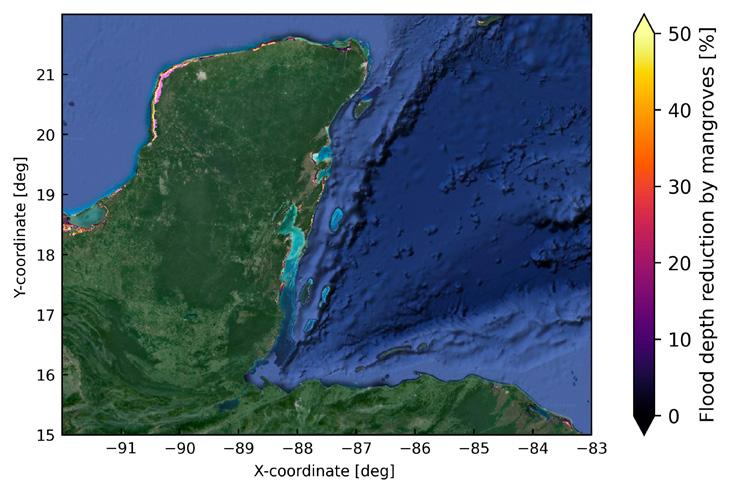

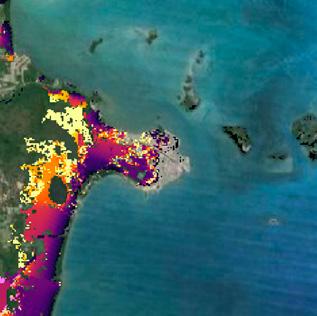
Figure 21: The relative levels of storm surge protection provided by mangroves and tidal marshes, with mangroves having the dominant influence where they co-occur.
Figure 20:
Mangroves’ interaction with incoming coastal stormwaters
Flooding is the most frequently occurring natural disaster. According to the results of global studies, approximately 1.3% of the global population live in areas that are exposed to 1-in-100-year coastal flood events11 This number is expected to increase due to population growth, climate change, and subsidence.
Coastal flood events are caused by high tides, storm surges, and waves that submerge low-lying coastal land in seawater. Globally, coastal flooding is predominantly determined by storm surges that are largely driven by the strong winds of a cyclonic storm. Flood levels due to storm surges can be locally aggravated by the local wave set-up, especially in areas with rapid transitions in bed level.
Mangroves affect patterns of coastal flooding by slowing down and redirecting storm surges and attenuating wind and swell waves. Mangroves cannot completely block high water levels that are generated during a storm surge, but they do lower propagation speeds, inundation depths and overall flood extents.
The effectiveness of mangroves’ capacity to mitigate coastal flooding depends on various factors. For example:
• The forest’s characteristics (width and vegetation density).
• Coastal topography.
• Storm conditions (e.g. storm surge height, storm duration).
Coastal vegetation can substantially reduce flood depths in the current climate, especially in regions where continuous mangrove belts are still present.

Scientific literature indicates that extensive mangrove green belts (on the kilometer scale between sea and inland areas) are typically required to achieve considerable reductions in coastal flood impacts. Although smaller mangrove patches are unlikely to fully prevent flooding, they may still lower flood depths in adjacent areas, and will reduce the impact of waves.
Mapping the global flood risk reduction value of mangroves
Computer models can be used to simulate the effects of mangroves on the impact of storm surges. These models use theoretical formulations, calibrated using field and lab observations. In such models, mangroves represent a rough surface. Although permeable, they generate friction that slows and alters water flow.
Currently available global studies have used a transect approach, which models water movements across thousands of parallel transects perpendicular to the shore. Such an approach may work well for open and uniform coastlines, but does not reflect reality for more complex coastal settings, such as estuaries, deltas, and lagoons, where most mangroves occur. Here it is important to model lateral water flow and 2D effects, such as funneling and redirection of high waters, which are extremely important during storm surges.
The Nature Conservancy (TNC) and the University of Cambridge are collaborating with Delft University of Technology, Deltares, and the Institute of Environmental Studies (IVM) Amsterdam in a global study of the role of mangroves and tidal marshes in reducing flood risk that is induced
by a combination of storm surges and tides. The researchers are disentangling more complex surge and wave processes in interaction with realistic coastal geographical representation in a 2D global numerical modeling approach and aim to resolve the interaction between vegetation, topography, and incoming flood waters.
To date, 2D modeling approaches are typically applied in local and regional studies. To the research team’s knowledge, the current global 2D approach with a resolution of 100 x 100 m is unprecedented and is expected to greatly improve our understanding of the role of mangroves in reducing global flood risk.
11 Muis, S., Verlaan, M., Winsemius, H. C., . Aerts, J. C. J. H and Ward. P. J. (2016). A global reanalysis of storm surges and extreme sea levels. Nature Communications 7:11969.
Marching towards building resilience, members of the Green Brigade in the Indian Sundarbans stride forth amidst mangroves, their mission clear: to restore the mangroves and strengthen the natural barrier against cyclones. © NEWS Archive.
Global 2D model set-up
Using an automated approach, numerical computer models have been generated in all coastal mangrove and tidal marsh areas across the globe. The seaward edges of the model domains are situated a few kilometers out from the coast and are aligned with the Global Tide and Surge Model, which is a global 2D flow model developed by Deltares and IVM Amsterdam12.
The model is forced with a time-varying storm surge level for tropical and extratropical storms. Thus, the rising and falling of the storm is included, which is essential for estimating the degree to which coastal wetlands are slowing down the storm propagation speed.
Inundation is modeled using a process-based model that is using a state-of-the-art map of ground elevation or Digital Terrain Model (DTM). This new Delta DTM corrects the earlier CopernicusDEM with space-borne LiDAR from
ICESat-2 and GEDI missions, correcting the elevation bias that has hampered previous predictions of coastal flood risk without locally generated elevation models.
Flooding or inundation maps are generated with coastal wetlands, and in a hypothetical situation without them. The difference between these determines the influence of mangroves and tidal marshes on reducing flood extent and flood depth. These maps of reduced or avoided flooding are then used to calculate avoided damages and the reduction in the numbers of people exposed. Model simulations are run for multiple return periods and various sea-level rise scenarios to provide a well-founded overview of the capacity of these ecosystems to reduce global coastal flood risk.
Initial results
The global modeling study confirms that coastal vegetation can substantially reduce flood depths in the current climate, especially in regions where continuous mangrove belts are still present. On the contrary, the effect of mangroves is far less pronounced in areas that are heavily channelized.
The results show that mangroves typically lower flood depths by 15-20% with maxima exceeding 70% for storms with a return period of 100 years in the current climate. The effect on overall flood extent is more limited however: in this storm scenario they reduce the flood extent by more than 50% in just 1.5% of the studied regions.
Mangroves typically lower flood depths by 15-20% with maxima exceeding 70% for storms with a return period of 100 years in the current climate.
The location and extent of mangroves on longer temporal scales (50-100 years) is difficult to project given many feedback loops and wide ranges in sea-level rise scenarios. The study shows that if the current extent of mangroves is maintained there will be increasing floodrisk reduction benefits of mangroves with higher water levels, but the exact value heavily depends on the ability of mangrove ecosystems to keep up with sea-level rise.
12 Muis, S., M. I. Apecechea, J. Dullaart, J. de Lima
K. S. Madsen, J. Su, K. Yan, and M. Verlaan. 2020. A High-Resolution Global Dataset of Extreme Sea Levels, Tides, and Storm Surges, Including Future Projections. Frontiers in Marine Science 7.
Rego,
surge reduction by mangroves
Figure 22. Modeling framework for estimating storm-surge reduction by mangroves.
5. Living with mangroves: a focus on food
5.1 Food security and mangroves
Mangroves support multiple aspects of food security.
Kenichi Shono and Maria Nuutinen (The Food and Agriculture Organization of the United Nations (FAO))
“Food security exists when all people, at all times, have physical and economic access to sufficient, safe, and nutritious food that meets their dietary needs and food preferences for an active and healthy life” (World Food Summit, 1996).
Food security encompasses four dimensions: food availability; economic and physical access to food; food utilization; and stability over time. For food security objectives to be realized, all these dimensions must be fulfilled simultaneously.
Mangroves are among the world’s most productive ecosystems, their high productivity sustaining a rich food web, providing food, fiber, and fuels alongside cultural services that help maintain human wellbeing. They support all four dimensions of food security (Figure 23).
Mangroves are among the world’s most productive ecosystems, their high productivity sustaining a rich food web, providing food, fiber, and fuels.
provide fish, seafood, non-aquatic foods, livestock fodder and medicine.
Availability
Food Security exists when all people, at all times, have physical and economic access to sufficient, safe and nutritious food that meets their dietary needs and food preferences for an active and healthy life.
Mangroves
Mangroves help maintain stable environments necessary for food production and enhance coastal resilience.
Sale of fish and other mangrove products generate income, providing economic access to food and other services.
Mangroves are used as fuelwood for cooking, sanitizing water and smoking fish.
Figure 23. The many ways in which mangroves contribute to the four dimensions of food security.
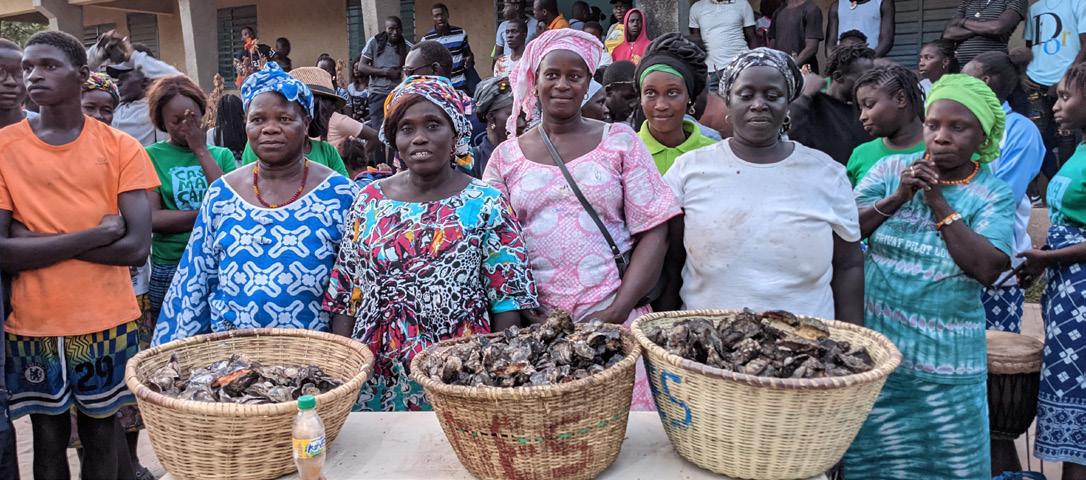
Mangrove fisheries
Fish and seafood sourced from mangrove ecosystems are often rich in essential nutrients, such as protein, omega-3 fatty acids, vitamins (e.g., vitamins D and B12), and minerals (e.g., iron, zinc).
Mangroves serve as nurseries and habitats for many fish, crustaceans, and shellfish, including commercially important species (see Section 5.2). This enhances coastal fisheries and supports the livelihoods of millions of people who depend on fishing, as well as the harvesting of crabs and mollusks, for food and income.
Fish and seafood sourced from mangrove ecosystems are often rich in essential nutrients, such as protein, omega-3 fatty acids, vitamins (e.g., vitamins D and B12), and minerals (e.g., iron, zinc). These are vital for maintaining overall health and wellbeing, and preventing malnutrition and other health issues. For coastal communities, such fish and seafood are locally available and accessible, year-round and at low cost.
Furthermore, mangroves provide many of the materials needed for fishing, including poles for making fish traps, tannins for treating fishing nets, timber for traditional boat construction, and aerial roots used as floaters for fishing nets. Barks of some mangroves are suitable for making ropes, and saps of certain mangrove species are used as fish poison.
On the other hand, the clearance of mangroves for food production stands as a significant driver of mangrove depletion. While such conversion can yield short-term economic benefits and enhance certain aspects of food security within particular communities, it is imperative to recognize the wider range of services provided by mangroves and to assess the environmental sustainability of these changes in order to fully comprehend the implications of converting mangroves for other forms of food production.
Non-aquatic foods
Mangrove ecosystems also offer a variety of nonaquatic food resources. For example, leaves of some mangroves and herbs found in mangrove habitats are collected and consumed as vegetables. Mangrove fruits are used in traditional diets, particularly in south and southeast Asia. The sap of nipa palm is used to produce sugar and fermented into various products. In addition, mangroves support bee populations, enabling the production of highly prized mangrove honey.
Alongside their nutritional value, many mangrove species contain bioactive compounds that possess therapeutic properties. Various parts of mangroves have been used in traditional medicine since time immemorial. Indeed, the most common direct use of mangroves in many coastal areas is medicinal, and there is a prospect for further utilization and exploration of mangroves as not only a food source, but also a source of pharmaceutical ingredients.
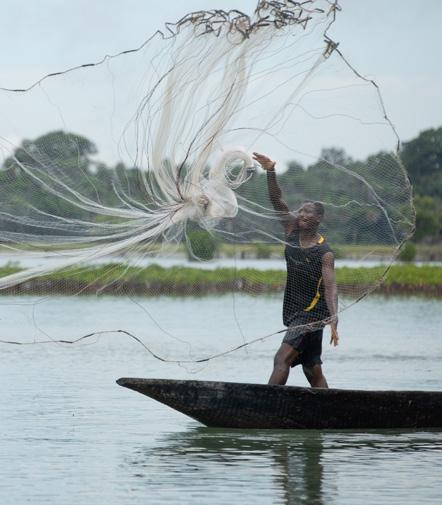
Sustainable mangrove-friendly livelihoods
Ntab (Eclosio)
Senegal’s Casamance and Sine-Saloum deltas and rivers are home to an abundance of mangroves. Villages here rely on them for protection from storms and to support fishing and shellfish harvesting. In the 1970s, when the area was blighted by drought, people started using the mangroves for firewood. This fed a vicious cycle of deforestation and poverty.
WeForest and Oceanium’s project is restoring over 10,000 hectares. With NGO Eclosio, the project also addresses the root cause of the mangrove loss by supporting the communities in taking up mangrovefriendly, income-generating activities that allow the restored areas to regenerate and grow.
Vienna Leigh (WeForest), Madicke Seck (Oceanium) and Simon
Photo: © N. Van Ingen
Women competing in the oyster festival in Essaout village, Senegal. The festival was supported by WeForest and Oceanium’s mangrove restoration project in the Casamance delta. © Germaine Neyra, WeForest.

Sustainable livestock grazing
In south Asia, grazing livestock in mangroves is not uncommon, but overgrazing can lead to vegetation loss, soil compaction, erosion, depletion of nutrients, and disruption in seed dispersal. To mitigate such impacts, it is essential to implement measures such as controlled and rotational grazing regimes and fenced off sensitive areas, and to promote community-based mangrove protection efforts. Raising awareness of the ecological importance of mangroves and the consequences of overgrazing can help build support for conservation measures.
Mangroves play a crucial role in food security, offering not only tangible products, but also essential services that sustain human wellbeing and livelihoods in coastal areas.


Mangroves as fodder for livestock
Mangroves are directly consumed, not only by humans but also by livestock. Mangrove leaves serve as fodder for livestock, such as goats, sheep, cows, and camels, particularly in drier regions where fodder availability is seasonally limited. In some places, however, uncontrolled grazing of livestock in mangroves has been identified as a degradation driver and a barrier to mangrove regeneration.
Fuelwood and charcoal
Mangroves are a source of fuelwood that is used by coastal communities for cooking, sanitizing water, and smoking fish. The dense wood of mangroves also yields excellent charcoal. Such utilization, if sustainable, constitutes an important component of food security.
A source of income
The sale of products derived from mangrove ecosystems, including fish and other aquatic species, timber, charcoal, honey, fruits, vegetables, and other non-wood forest products, also helps to confer economic stability for coastal communities (see Section 5.4). Further sustainable livelihood options may be derived from mangrove-based ecotourism, including recreational game fishing in mangrove areas. The generation of sustainable incomes from mangroves provides additional security for communities, enhancing their means of accessing food and other services, while further incentivizing mangrove protection.
Stability and resilience
Finally, mangroves provide other critical ecosystem services that underpin food production and provide stability over time. Mangroves are one of the most carbon-rich ecosystems on earth. By mitigating climate change, they help maintain the stable environmental
conditions that are necessary for food production and security (see Section 4.1). They also help to protect coastal areas from erosion, storm surges, and tidal waves (see Section 4.3), enhancing the resilience of coastal communities and helping them adapt to changes and uncertainties. When climate change exposes coastal areas to either slow-onset changes, such as the slow rise of sea levels, or sudden shocks, mangroves help absorb these changes and increase the adaptive capacity of people and ecosystems around them.
Mangroves as an essential strategy in ensuring coastal food security
Mangroves play a crucial role in food security, offering not only tangible products, but also essential services that sustain human wellbeing and livelihoods in coastal areas, often alongside traditional cultural practices. Conservation and sustainable management, including responsible fishing practices in mangrove ecosystems, are vital for the resilience and sustainability of food systems in coastal regions worldwide.
Samadrita Roy (One Tree Planted)
Photo: © KM Reyes
A woman unloading mangrove logs that will be used for charcoal production in Thailand. © J. Koelen, FAO
Women from Patimburak village, Fakfak, West Papua looking for shellfish in the mangrove forest. © Orlina Ozora Yowei, Konservasi Indonesia.
5.2 Mangroves and fisheries
New maps model the abundance of key commercially important fish species that use mangroves.
Thomas A. Worthington (University of Cambridge), Philine S.E. zu Ermgassen (University of Edinburgh), Ivan Nagelkerken (University of Adelaide), Gustavo A. Castellanos-Galindo (Leibniz Institute of Freshwater Ecology and Inland Fisheries), Nibedita Mukherjee (Brunel University London), Ronald Baker (University of South Alabama)
filter-feeding species, such as mussels and clams, and a critical nursery and feeding grounds for many species.
Despite this body of knowledge, until recently we lacked a global estimate of the fish and invertebrate productivity associated with the presence of mangrove forests.
Across the world, billions of people rely on the protein and micronutrients provided by marine and coastal fisheries. As well as providing nutritional benefits, these fisheries also support livelihoods for millions of people, particularly from communities in the Global South1. The long-term sustainability of these fisheries depends on maintaining the ecological integrity of our marine and coastal environment.
A significant amount of research has highlighted the value of mangroves as a critical habitat for many fish and invertebrate species2. The complex physical structure of mangrove trees and roots provides areas of shelter from wave energy and predators, a surface for attachment for
To address this, a global group of nearly 50 mangrove fisheries scientists have developed a model to estimate the density and abundance of commercially important fish and invertebrates that are known to use mangroves extensively3. Field data on the density of 37 species was found from locations around the world, including species of fish, prawns, crabs, and one cockle species. This field data was modeled against spatial information on the biophysical drivers of mangrove fish and invertebrate density. In particular, higher salinity, the length of mangrove edge habitat, and the presence of deltas were determined as important drivers of abundance.
This model was then used to estimate the density of each of the 37 species across their respective ranges in all areas where mangroves occur and to calculate the annual contribution to abundance of each species across
1 zu Ermgassen, P. S. E., Mukherjee, N., Worthington, T. A., Acosta, A., Rocha Araujo, A. R. d., Beitl, C. M., Castellanos-Galindo, G. A., Cunha-Lignon, M. et al (2020). Fishers who rely on mangroves: Modelling and mapping the global intensity of mangrove-associated fisheries Estuarine, Coastal and Shelf Science:106975.
2 Carrasquilla-Henao, M., Juanes. F. (2017). Mangroves enhance local fisheries catches: a global meta-analysis Fish and Fisheries 18:79-93.
3 zu Ermgassen, P., Worthington, T. A. Gair, J. R. Garnett E. E., Mukherjee, N. Longley-Wood K., Nagelkerken, I. Abrantes, K. et al (2024). The global fish and invertebrate abundance value of mangroves bioRxiv.
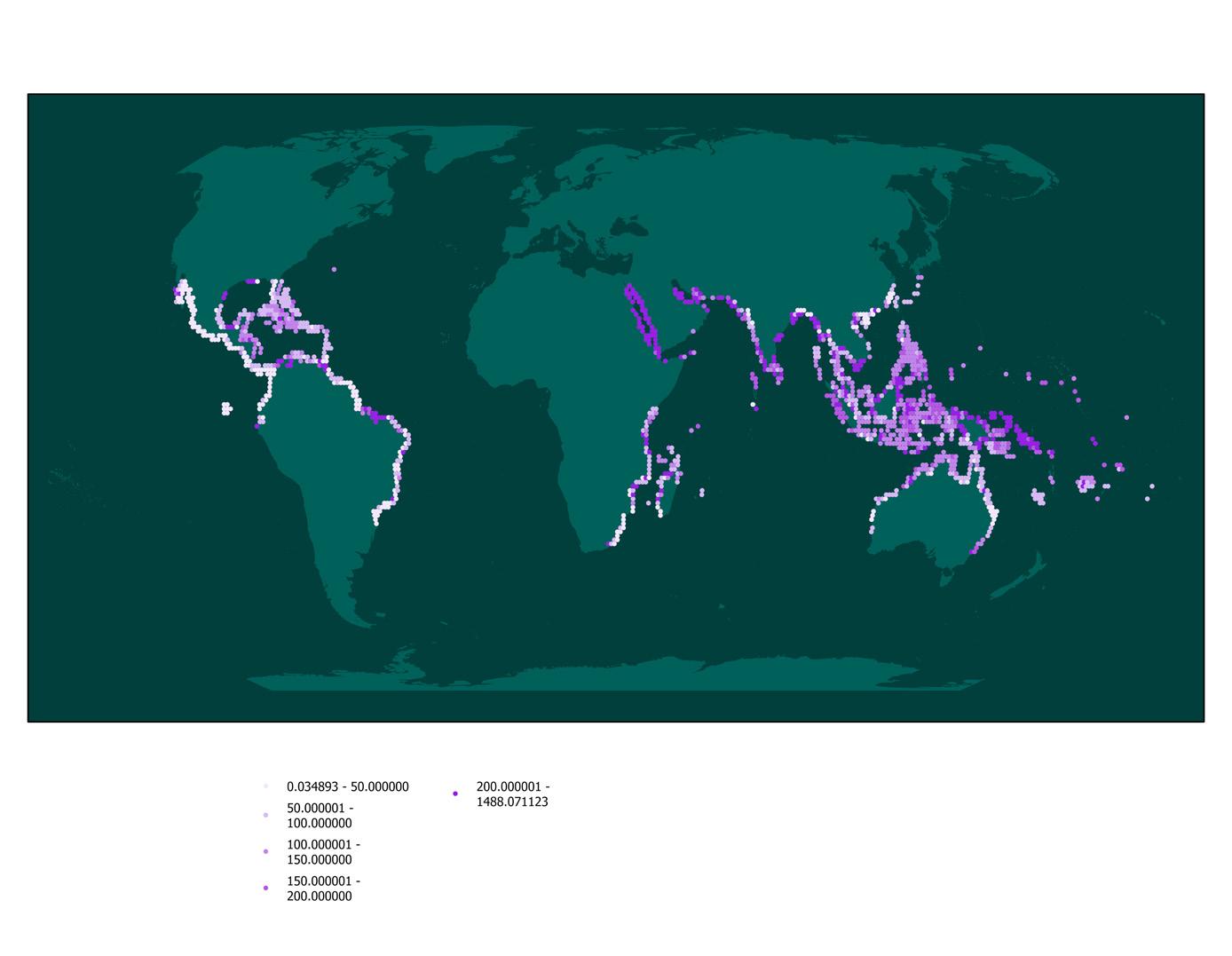

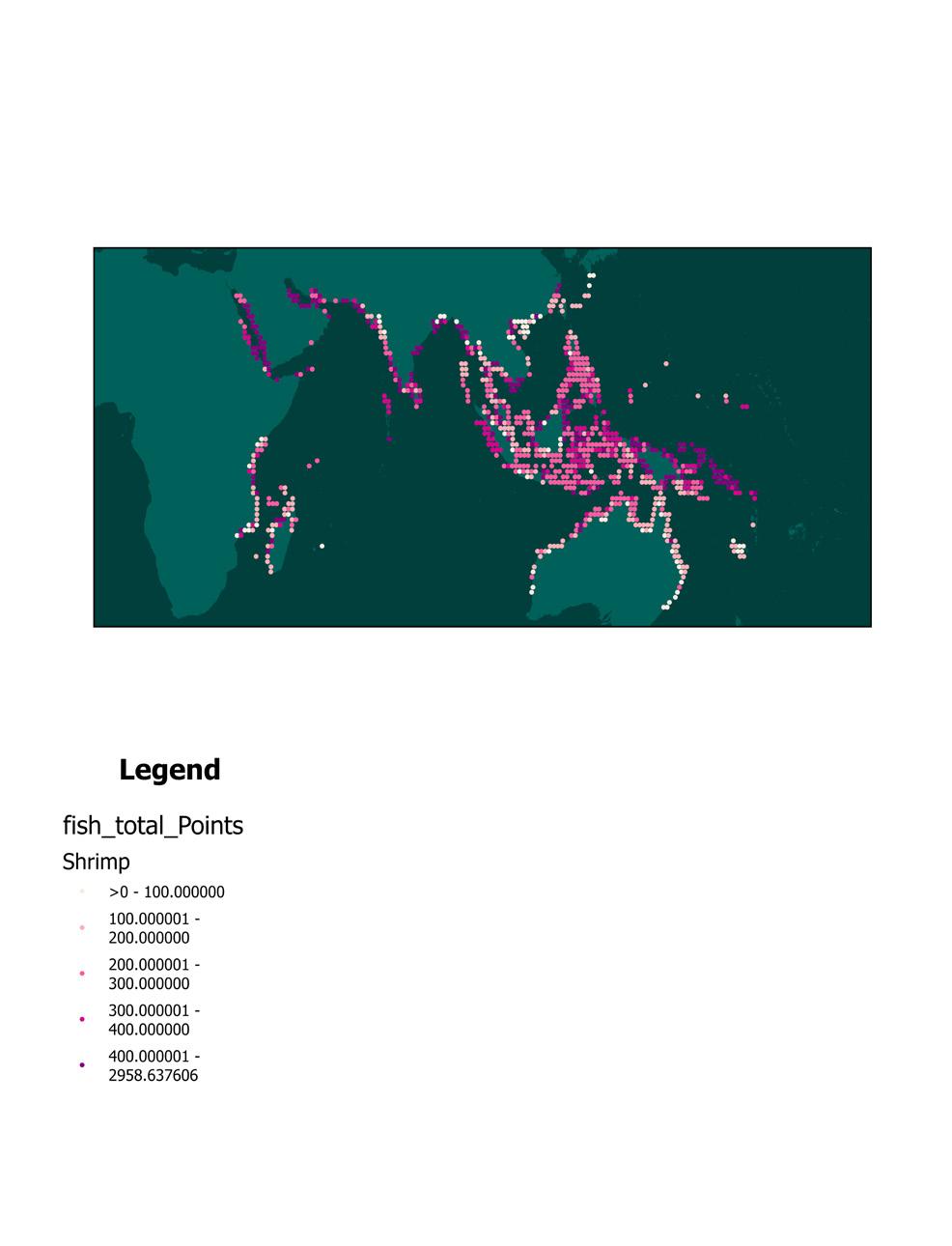
Figure 24: The modelled density of commercial finfish (main map), shrimp (right) and crabs (left) in mangroves.
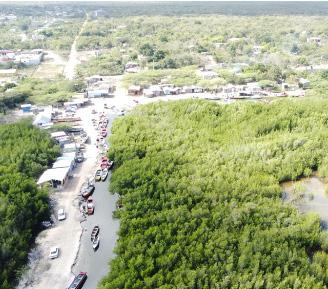
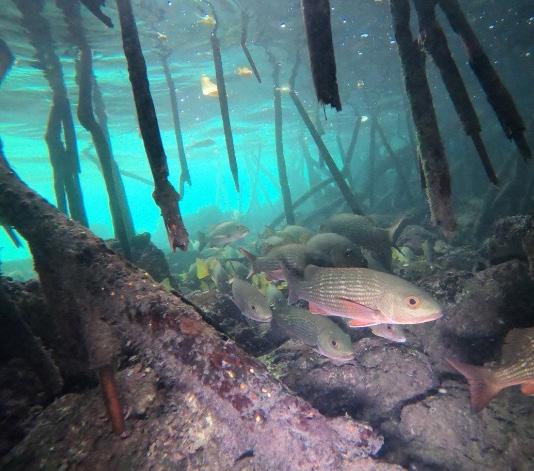
Mangroves are a lifeline for Jamaican fishing villages. They shield the coast from storms and provide shelter for fish and crustaceans. By restoring mangroves, villagers are ensuring a sustainable and healthy future for their communities.
© Andrés E. Fraiz T., Wetlands International.
the world’s mangrove forests. These do not represent all commercially important species, but they are likely to be indicative of wider patterns. West and central Africa were not included as no field data was available for these regions. Also, the coverage was uneven for the different groups, with shrimps only mapped for the Indo-West Pacific, while the only mollusk was an Eastern Pacific species.
The model predicts high densities of fish and invertebrates on the productive deltaic coastlines of the Americas and southeast Asia as well as arid regions of the Middle East. Across the 37 species it is estimated that the presence of mangroves annually supports nearly 800 billion young-of-year fishes, prawns and bivalves, and adult crabs.
The 29 species of fish contribute a third of the total numbers. They range from highly abundant small schooling species, such as the hardyhead silverside (Atherinomorus lacunosus) to lower density, but high value, species such as the mangrove snapper (Lutjanus argentimaculatus).
The three species of prawn mapped across the IndoWest Pacific account for nearly half of the global total numbers in the model, with the mangroves of southeast Asia supplying almost 70% of the prawns. Crabs are an important component of the total numbers in the Americas (the semi-terrestrial crabs Ucides cordatus and U. occidentalis). Given differences in species’ life-history, it is important to note that the abundance estimates do not equate directly to fisheries catches or economic value.


At a national level, Indonesia, with its extensive mangrove coastlines, has the highest total abundance of both prawns and fish, and the particular importance of deltaic mangroves in central and eastern Indonesia clearly stands out. Brazil and Mexico dominate the total numbers in the Americas. In Brazil, deltaic systems, notably those along the northeast coast, dominate the overall numbers.
This work provides a first estimate of the fish production of mangroves. The results should be viewed in the context of limited data, covering only some of the commercially important species, and with variation in coverage between regions (and notably the absence of data for West Africa). As such, the actual numbers represent a substantial underestimate of the total abundance of commercially important species, but serve to highlight the significant value of mangroves in supporting populations of fishes and invertebrates globally.
Fish
nurseries in the tallest mangroves of the Americas
Gustavo Adolfo Castellanos Galindo, Rodrigo Andrés Baos Estupiñán, and Luis Alonso Zapata Padilla (WWF Colombia)
The Esfuerzo Pescador community council, in the southern Pacific coast of Colombia, harbors one of the tallest mangrove forests of the world. Fish diversity here is high, and WWF Colombia has been working with the council and non-profit and government organizations to make fishing practices more sustainable and adapt fishing gear and trawl designs. A participatory fishing monitoring program has been put in place, identifying non-sustainable practices like bottom trawling. This long-term relationship with the fishing communities has brought attitude changes that could help secure food security and livelihoods.
A young barracuda, one of the 37 species in this study, in the mangroves of Colombia. © Mark Spalding, TNC.
The Galapagos Marine Reserve is a highly protected area where mangroves are crucial for the growth of snappers and endemic groupers that support local artisanal fisheries.
© Nicolas Moity, Charles Darwin Foundation (CDF).
Photo: © G. Castellanos, WWF Colombia
5.3 Aquaculture and mangroves
Understanding the key drivers of mangrove loss – and rehabilitation.
Introduction
The clearance of vast tracts of mangroves for aquaculture is well documented, and the tight links between mangroves and aquaculture (see Section 2.2) deserve particular attention. Some clearance is still ongoing, while the shocking legacy of past clearance includes vast areas of unproductive or abandoned ponds – wastelands that offer no benefits, either from the former mangroves or the failed aquaculture.
It is a core principle of the Global Mangrove Alliance (GMA) that no further losses should occur. Restoration must be accelerated, including in areas previously cleared for aquaculture, but many challenges remain.
Demand for aquaculture products seems set to continue in its inexorable rise, while the desire to restore mangroves, with all their concomitant benefits, is strong.
Here we present two viewpoints which explore the story of aquaculture, the need for conservation and restoration, and the challenges of doing so in the face of increasing global demand for aquaculture products.

The formerly wild Berau Delta, Indonesia, has seen massive mangrove losses to industrial scale shrimp aquaculture in recent years. © Mark Spalding, TNC.
5.3.1 Taking the shrimp farms out of the mangroves
Addressing the social, economic, and political drivers of mangrove loss will prevent its recurrence.
Alfredo
More than any other industry, industrial shrimp aquaculture has been a major driver of mangrove loss. From the 1980s onwards, what had been aptly termed a “slash and burn industry” has wreaked havoc on both mangroves and the traditional coastal communities who depend on the benefits and services they provide. Only in the last decade has the rate of mangrove loss to shrimp farm encroachment noticeably declined (see Section 2.2). In many nations where great loss occurred in earlier years, there is a small but growing proactive movement towards the conservation and restoration of mangroves. Set against this, significant losses are still occurring in Kerala and eastern India; in Indonesia; northeast Brazil; and northwest Mexico, where the industry is still expanding.
The problems with aquaculture for mangroves
Ancient forms of aquaculture have been practiced for over 2,000 years. The gei wais of Hong Kong and the tambaks of Indonesia are traditional forms of aquaculture which still exist today. However, these bear little resemblance to modern industrial aquaculture. Industrial shrimp farming, in particular, has spread especially fast into the mangrove areas of Asia, Africa,
and Latin America with devastating results. Current best estimates of shrimp aquaculture globally are some 3.49 million hectares (ha)4. Problems have arisen, both due to the scale and intensity of operation that comes with industrialization, and due to the siting. Most shrimp farms are constructed within the vital intertidal zones, resulting in the total removal of mangroves.
A significant driver of this industrialization since the 1970s is support from multilateral donors, such as the World Bank, and by governments eager for foreign capital. Aquaculture was promoted in some western countries as a source of cheap protein to enhance world food security, and employment. In reality, the environmental and socioeconomic effects of these initiatives have largely been detrimental both to local communities and coastal ecosystems.
Loss of mangrove areas adversely affects local fishers and food supplies, while most of the shrimp produced are exported to wealthy nations, negating the stated food security benefits. Shrimp farms have often replaced diverse, multiple-use resource bases with large-scale single-use monoculture operations, with just a few, often non-local, owners. Social inequality has, in some cases, been accompanied by human rights abuses and violence.
World Aquaculture Society 53:8-46.
Quarto (Mangrove Action Project) and Amit Thavaraj (writer and film-maker, India)
4 Boyd, C.E., Davis, R.P. and. McNevin. A.A (2022). Perspectives on the mangrove conundrum, land use, and benefits of yield intensification in farmed shrimp production: A review Journal of the
Unresolved
pollution and disease problems have plagued the industry, and many farms are short-lived, then abandoned.
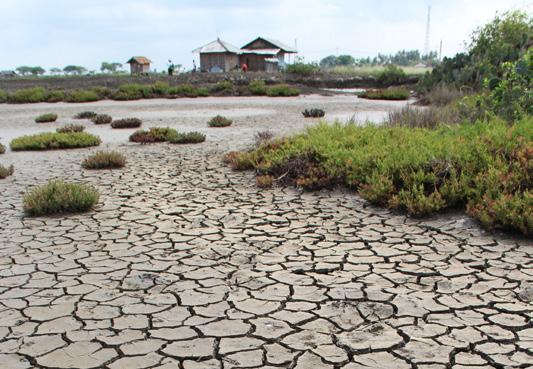

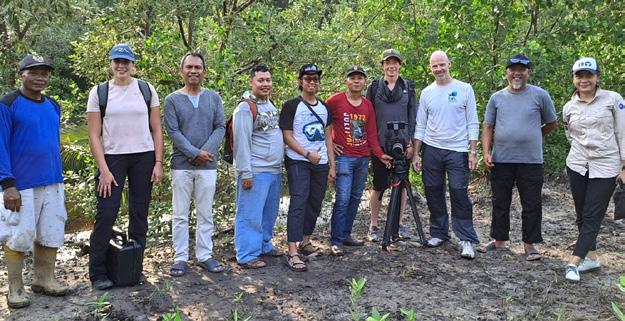
Unresolved pollution and disease problems have plagued the industry, and many farms are short-lived, then abandoned. While global totals are not known, one 2018 study estimated that there are 250,000 ha of abandoned shrimp ponds in Indonesia alone5. Prior to their conversion these and other mangrove areas in Indonesia were estimated to be generating US$15,000 in ecosystem service benefits per hectare per year6. Unless restored, such ponds are totally unproductive. They no longer generate commercial value, but also perform no useful ecological function. Impacts from shrimp farming, including from hydrological modification, pollution, and salt intrusion, are also recorded from adjacent habitats, such as mudflats, seagrass beds, and coral reefs, as well as terrestrial habitats and farmland.
Attempts at solutions
Certification and ecolabeling of shrimp from lowimpact or mangrove-friendly aquaculture are presently promoted as a solution. However, there is little proof that these schemes are solving the persistent problems. Unpublished independent studies conducted in Honduras and Bangladesh found that certification was ineffective and grave problems still persisted with socalled green-labeled shrimp.
The concept of creating employment also needs closer examination. Many of the jobs created—security guards or shrimp processors working in warehouses—are low paid and low skilled. Furthermore, there is limited job security due to the vagaries of international markets, and the vulnerability of farms to disease and pollution.
Meanwhile, traditional livelihoods from fishing and farming can be lost, with traditional skills and local wisdom no longer passed down to future generations. Mangrove conservation and restoration opportunities, developed with local communities, provide a better alternative to shrimp certification or “mangrove-friendly” aquaculture. Putting grassroots, community-based organizations front and center is an imperative too often ignored in internationally supported alliances (see Section 3.1). The challenges of returning shrimp ponds to mangroves can be significant, but groups such as the Mangrove Action Project have developed highly effective approaches (see Section 6.3). In parallel, it remains critically important to address the social, economic, and political drivers of mangrove loss in order to prevent recurrence.
but new approaches to aquaculture may also provide solutions. For example, closed containment Recirculating Aquaculture Systems (RAS) can be located outside the intertidal zones, and can be managed in a manner that prevents the risk of disease spread or the escape of non-native species. It should also be possible to avoid pollution from such systems, through the cleaning and recirculation of production ponds or tank waters.
Mangroves represent much more than their contribution to the environment and economy; they represent those intangible values that define our relationship with the Earth, and our commitment to preserving her wonders.
5 Gusmawati, N., B. Soulard, B., N. Selmaoui-Folcher, N., C. Proisy, C., A. Mustafa, A., R. Le Gendre, R., T. Laugier, T., and H. Lemonnier. H. (2018). Surveying shrimp aquaculture pond activity using multitemporal VHSR satellite images - case study from the Perancak estuary, Bali, Indonesia Marine Pollution Bulletin 131:49-60.
6 The World Bank. 2022. The Economics of Large-scale Mangrove Conservation and Restoration in Indonesia. The World Bank, Washington DC.
While halting further loss, and restoring past loss, remains imperative, the demand for shrimp products will continue to be a significant pressure. Efforts to reduce consumer demand may help to dampen market forces,
Expanses of abandoned aquaculture have become wastelands that cannot be cultivated, but no longer provide the benefits of wild mangroves. © Mark Spalding, TNC.
An abandoned shrimp pond in Quelimane, Mozambique presents challenging conditions for restoration practitioners as they consider how to restore the hydrology of the area. © Mangrove Action Project.
MAP trainers meet with community members from Parit Seghagah in Indonesia. When they realized that their mangroves were being degraded by solid berms excavated through these forests to protect the shrimp ponds behind, the community began fighting to reverse the trend by digging channels and improving local hydrology. © Mangrove Action Project.
5.3.2 Restoring mangroves by growing food?
Integrated mangrove aquaculture offers seafood with greater sustainability.
René Benguerel (Blueyou)
The global expansion of the aquaculture industry has been one of the main drivers for large-scale destruction of mangroves in the past and — to a limited extent— still is today. However, farming seafood in mangrove habitats is rarely a successful strategy in the long term, specifically if it involves raising shrimp or fish by feedbased, intensive farming systems.
The acidic soil properties of mangrove habitats do not support intensive aquaculture, and excessive nutrients brought into the system by feed and fertilizers further accelerate critical conditions for sensitive seafood species to thrive. Today across southeast Asia, large areas of degraded intertidal zones are either abandoned or farmed with limited success, resulting in low yields and limited economic success for smallholder farmers.
Degraded zones offer an opportunity to restore mangroves and establish thriving seafood harvesting systems.
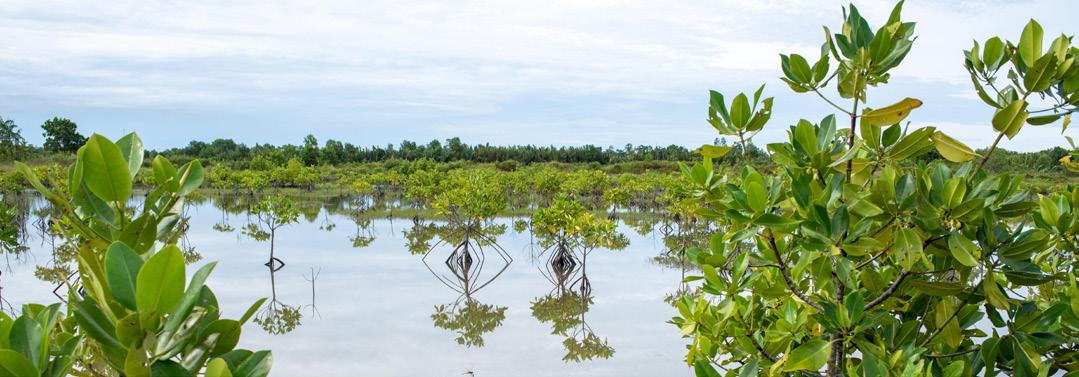
However, such degraded zones offer an opportunity to restore mangroves and establish thriving seafood harvesting systems which do not require any inputs from outside.
Integrated mangrove aquaculture (IMA) involves the restoration of mangroves within ponds and embankments of farms. Once established, the mangroves provide both food and shelter for aquatic species to grow and thrive as part of the natural food web. IMA usually involves a polyculture approach where farmers grow multiple species of shrimp, crab, filter-feeding fish, and bivalve mollusks. In fact, IMA is the aquatic version of agroforestry on land, where food is grown and harvested within a functional ecosystem.
Depending on the site conditions and the overall setup of the ponds and hydraulic dynamics, IMA ideally involves the restoration of at least 50% of the total surface of a given farm with mangroves. The trees become the main driver for productivity, generating seafood for harvesting, while creating economic incentives for farmers to restore and maintain mangroves. Good aquaculture practices are critical


Revitalizing abandoned fishponds with mangroves to improve food
security
Camille Rivera (Oceanus
James Morris (Blue Marine
In the Philippines, Oceanus Conservation is conducting mangrove restoration of abandoned fishponds with the Dulao Community Association in Aringay, La Union. 27,000 seedlings have been cultivated in a nursery, with 4,425 successfully planted on raised mounds to maximize survival rates. Restoration has yielded impressive food production results for the community. The rejuvenated mangroves provide a thriving habitat for marine life, resulting in a harvest of 30 kilograms (kg) of tilapia, alongside 5 kg of crab and shrimp, respectively, in just a few months. This integrated approach not only promotes biodiversity but also highlights the critical connection between healthy mangroves and food security for communities.
Underpinning IMA is the aim to establish over 50% mangrove cover in ponds, which will increase yields considerably. © Rene Benguerel.
Frances
Conservation),
Foundation)
Photo: © Oceanus Conservation
Through a diverse, multi-species harvest, IMA practitioners can broaden their markets while increasing the resilience of their stocks. © Rene Benguerel.

Sustainable Aquaculture in Mangrove Ecosystems (SAIME)
Ajanta Dey, Nimai Bera,
Sabyasachi Chakraborty and Milon Sinha (NEWS)
SAIME, implemented by Nature Environment and Wildlife Society (NEWS) in the Indian Sundarbans, brings community, conservation, livelihoods, and climate change mitigation together into a meaningful program through a multi-stakeholder partnership, engendering coastal resilience in the context of climate change induced sea-level rise. This ecosystem-based and climate-adaptive approach aims to promote mangrove ecosystem restoration in the Sundarbans while also developing sustainable aquaculture using a polyculture method. Black tiger shrimp is integrated as a candidate species with “no use of exogenous feed”. SAIME also aims to develop a community-inclusive value chain, preferably with certification and branding of its products to bring about transformative change.
The debt trap common to many smallscale intensive shrimp farmers...can be avoided. Seafood can be harvested continuously, and the mix of species allows for a diversified market.
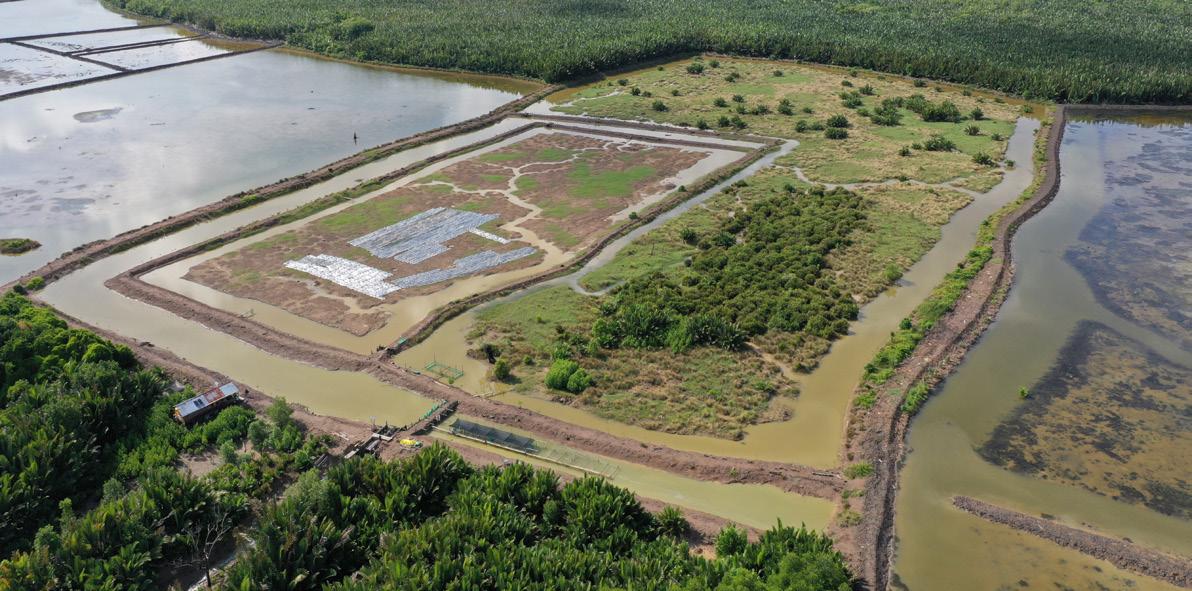
and must be adapted to site-specific conditions and chosen farming systems. Ponds are stocked by the farmers, for example, with juvenile shrimp, mud crab, or milkfish from hatcheries. Such extensive stockingbased aquaculture systems may be accompanied by other naturally occurring species, providing additional opportunities for income or subsistence.
IMA offers robust income opportunities for local communities. After the cost of hatchery-reared juveniles, there are no further expenses. Thus, the debt trap common to many small-scale intensive shrimp farmers, linked to costs for feed, fertilizers, or other chemicals, can be avoided. Seafood can be harvested continuously, and the mix of species allows for a diversified market. Black Tiger prawns can be sold for trade into global markets; mud crabs can generate income from local markets; species such as milkfish provide a valuable source of protein for the local communities. Typically, more than 50% of farmers’ income is generated through local value chains.
For many coastal communities, IMA is an attractive proposition. Where such communities have already established farms within intertidal zones, there may be considerable reluctance to restore the original status of mangroves – a request akin to asking western European farmers to establish oak forests on their land. By contrast, fully established and functional IMA brings back at least 50% of the former mangrove coverage, but also results in significant benefits for local communities and the environment.
Based on data gathered by Blueyou over the past 15 years in Vietnam and Indonesia, fully established IMA with mangrove coverage of more than 50% can produce two-to-three times higher seafood yields and boost farmers’ income, as compared to extensive farming in degraded ponds without mangroves.
Blueyou estimates that in southeast Asia alone, more than 1 million ha of degraded intertidal zones would be suitable for improved IMA interventions, offering
the potential to restore 500,000 ha of mangroves, that sequester 200 million tonnes of carbon and provide an additional 900,000 tonnes of nutritious, organically raised seafood. The income of coastal communities could be boosted by US$1.5 billion per year.
In the face of the many threats arising from global food systems, including pollution, habitat destruction, and greenhouse gas emissions, IMA offers an opportunity to rethink our food systems, restore natural resources and use natural aquatic food webs fueled by sunlight, while generating food and sequestering carbon.
In a manner similar to farming bivalve mollusks or other filter-feeding aquatic species, IMA points towards the true potential of blue food systems. Focusing on organisms without high energy and feed demands, it provides a model of more nature-positive, climate-smart food growing systems that allow us to harvest our future food within the safe zone of the planetary boundaries.
Photo:
Through a Yayasan Konservasi Alam Nusantara (YKAN) initiative, a silvo-fishery technique called SECURE (Shrimp Carbon Aquaculture) was introduced to pond owners in east Kalimantan, Indonesia. Used across 240 hectares, SECURE aims to minimize areas for shrimp aquaculture while maximizing areas for restoration. © Vabian Adriano, YKAN.
5.4 Diversified livelihoods for mangrove communities
From beekeeping to salt production, there is far more to mangrove-based livelihoods than fishing and aquaculture.
Maricé
Leal and Chris Zganjar (The Nature Conservancy (TNC))
Mangroves sustain life—as they have for millions of years. Mangroves not only provide food, store carbon, and act as natural sea defenses, they are also a source of income and employment for millions. Many mangrove-dependent communities utilize mangroves in a sustainable manner. However, growing coastal populations have increased pressures on mangroves and led to widespread deforestation or degradation as too many people try to extract limited resources. Rates of loss are on a downward trend, but in many places disproportionate pressures still remain.
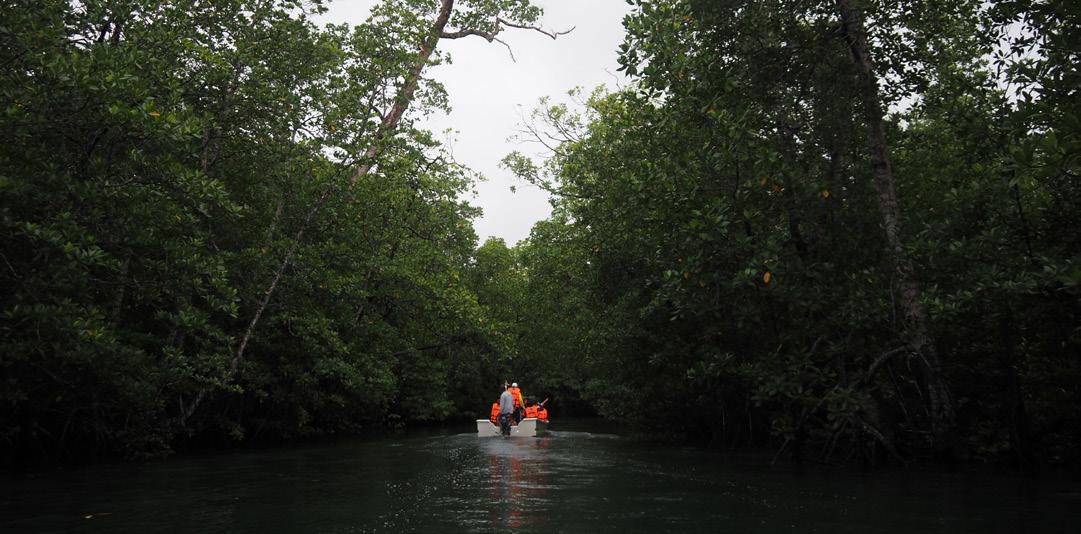
A key component of ongoing mangrove management is the need to ensure local communities can be engaged in a sustainable manner, benefiting from mangroves. In places where growing populations and diminished mangroves coincide, opportunities for increasing the sustainability of traditional or modern practices may be required, as well as new opportunities, within or beyond the mangroves7.
Fisheries
Mangroves can be thought of as ‘fish factories’, generating very large quantities of commercially important species (see Section 5.2). Even so, fisheries can become unsustainable. Matters can be improved by encouraging better practice, for example, by avoiding damage to trees when harvesting oysters or crabs.
There may also be potential in many areas to focus fisheries towards lower-volume, highervalue fisheries. Shellfish, wild-caught shrimp, and mud crabs often have high market values and can even reach export markets. Managing such fisheries towards sustainability is essential and, in many cases, communities are increasingly empowered to manage their mangroves and are employing limits on catch, access, or seasons, or may close areas to act as breeding areas or refuges. Such approaches ensure higher incomes for lower impacts. The job generation of marketbased fisheries can also extend way beyond the fishers, to processing, distribution, and sales.

Mangrove ecotourism
Basir (YKAN)
The power of a village dream: six years ago, residents of Teluk Semanting village in Indonesia dreamed of transforming their community through mangrove ecotourism. Though challenging, they managed to work with local government to pass regulations protecting a 750 ha mangrove area and established their local community group as the mangrove management board, now called Tim Pengelola Mangrove (TPM).
The community and TPM built the first mangrove wood path from reclaimed wood and diligently garnered support from various stakeholder groups. Today, Teluk Semanting is a thriving ecotourism hub in Berau, attracting around 2,000 visitors annually, supporting local businesses, and offering packages like homestays. Fishers have also benefited from increased crab catches, a testament to the sustainable management of the mangroves. The community’s dream has become a reality, enhancing their environment and the local economy.
7 Debrot, A.O., Veldhuizen, A., van den Burg, S.W.K., Klapwijk, C.J., Islam, M.N., Alam, M.I., Ahsan, M.N., Ahmed. M.U. (2020). Non-Timber Forest Product Livelihood-Focused Interventions in Support of Mangrove Restoration: A Call to Action. Forests 11:1224.
Photo: Glamping is one of the unique components of the mangrove ecotourism area in Teluk Semanting Village. © Nurhadi Pratama (YAKOBI)
Nature-based ecotourism is seen as a potential element for inclusive mangrove ecosystem conservation in Southern Palawan, Philippines. © WWF-Philippines.

A Community Kitchen in Ecuador
Xavier Chalén, Raúl Carvajal, Nelson Zambrano (Conservation International)
In the ‘6 de Julio’ community in Ecuador, Patricia and Teresa, women of the mangrove, are receiving support from Conservation International and the GMA. They plan to establish a community kitchen, creating additional income opportunities and in turn restoring the mangroves.
This community kitchen will provide income for the five families who manage it, and serve mangrovesourced meals, highlighting the red crab. The red crab holds a special place in the gastronomic heritage of Ecuador. It is also a keystone species in the mangrove ecosystem and contributes significantly to employment generation and economic income. Despite gender challenges and a lack of government support, these women are determined. Their project could become an exemplar of women empowerment and sustainable development for the community.
Salt production
With the growing awareness of the importance of mangrove forests, we need to encourage the mainstreaming of provisioning techniques that minimize impacts while still supporting livelihoods. Salt production is often undertaken in close proximity to mangrove forests and can have highly negative impacts including the clearance of mangroves to make salt pans or associated infrastructure, but also the unsustainable approach of cutting the mangroves for firewood to crystalize the salt by heating brine over fire. Both of these impacts can be reduced, by restricting salt production to non-mangrove areas, and by halting the use of mangrove firewood. One such example is in Guinea, where 30% of the mangrove salt is now produced by allowing natural evaporation of brine. This is a significant improvement from the status quo. This technique is also being explored in Benin among women salt producers, while bringing awareness of the consequences of mangrove felling8.
Sustainable timber harvesting
The export of mangrove wood has been documented as far back as 1,200 years ago. Mangrove wood is durable, and its resistance to termites makes it an attractive building material. In many communities it is harvested for construction, fuelwood, and extraction of tannins.
Communities that still depend on mangrove wood have developed harvesting techniques that retain the valuable ecosystem services of the forests. An example in the LEK Guide highlights communities in Liberia that prohibit
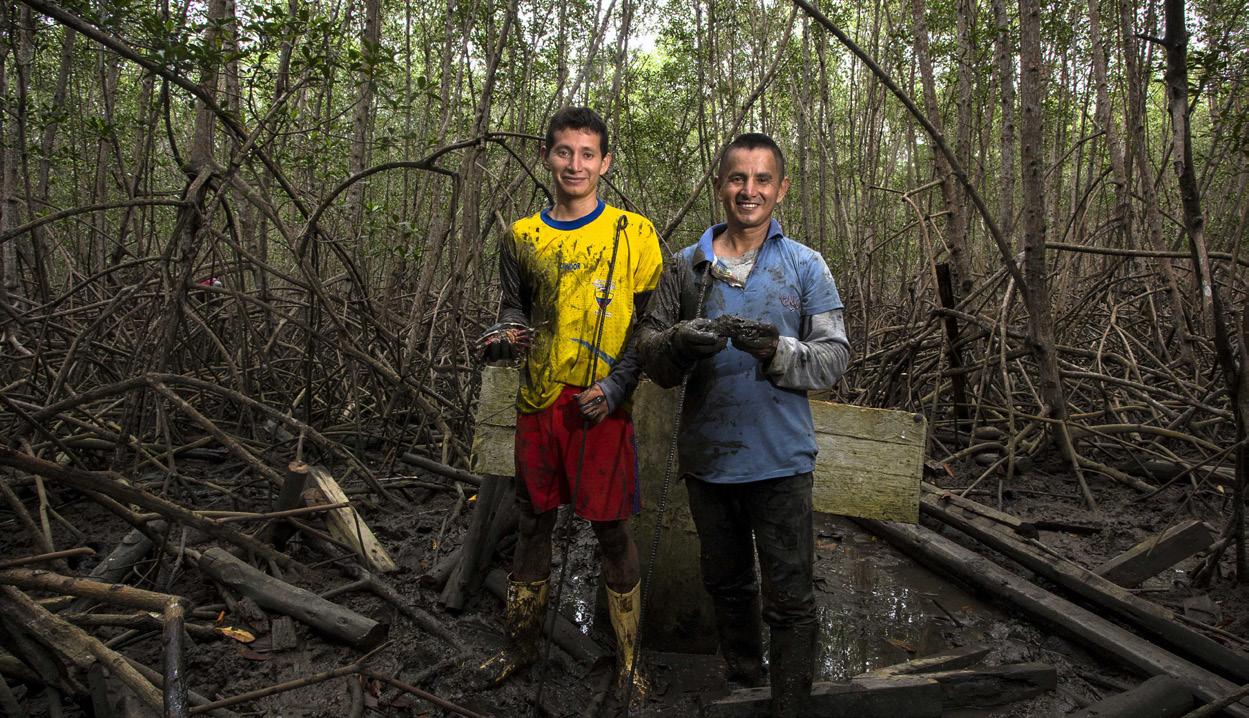
clear-cutting and alternate the sites that they use for fuelwood to avoid depleting any particular area. These same communities will act as guardians of their mangroves, monitoring for illegal logging by outsiders.
In Malaysia’s Matang Mangrove Forest Reserve, 80% of the land is similarly managed under a 30year cutting rotation9. The remaining 20% is fully protected, and the rotation facilitates regeneration. Although these practices are not perfect, they have provided a viable solution to clear-cutting and incentives for guardianship of the mangroves.
Communities that still depend on mangrove wood have developed harvesting techniques that retain the valuable ecosystem services of the forests.
8 Adounkpe, J., Agboton, C., Hounkpatin, W., Kounouhewa, B., Ahouannou, C., & Sinsin, B. (2021). Qualitative Assessment of Table Salt Production Techniques in Southern Benin Republic, and Related Mangrove Destruction and Health Issues. Food and Nutrition Sciences, 12, 759-773.
9 Chen, D., Satyanarayana, B., Wolswijk, G., Abd Rahim, N. H., Amir, A. A., Hugé, J., & Dahdouh-Guebas, F. (2024). Historical ecological monitoring and appraisal for extractive uses and other values in Malaysia unveils consequences of regime shifts in 120 years of mangrove management. Journal for Nature Conservation, 79, 126582.
Photo: © Xavier Chalén, Conservation International
Shellfish harvesting can provide high market value products. Shell and crab collectors, Heart Island, Ecuador © FAO, David Diaz Arcos

Beekeeping
A growing number of communities are diversifying livelihoods to gain more economic stability. In parts of Mexico and South America, the traditional practice of beekeeping is regaining popularity as a way for communities to gain supplemental income and, in turn, they are assisting the survival of native stingless bees that have been severely impacted by invasive Africanized honeybees.
The GMA community is gathering more stories centered around mangrove beekeeping as an alternative livelihood that helps to reduce the pressure on fisheries and other mangrove food products. Beekeeping can also increase biodiversity through bees acting as mangrove pollinators, and it encourages conservation. Modern marketing practices, such as marketing the honey as organic, have allowed communities like the Nai Nang Village in Thailand to support local livelihoods and dedicate a percentage of profits into a local Mangrove Conservation Fund.
Aqua-Farms Organization (AFO), through Fair Carbon’s Pilot Program, is supporting communities in Kunduchi, Tanzania. By providing beekeeping training and equipment, they help locals diversify their livelihoods, reducing dependence on harmful practices and decreasing pressures on their mangroves.
© Javis Bashabula, Aqua-Farms Organization.
Management, restoration, research
Coastal communities are often united through collaborative restoration projects, and these projects can result in additional income. Large restoration projects in many cases provide multiple sources of employment to local community members that may manage the mangrove nurseries, dig channels, install culverts to restore hydrology, assess progress through site visits, and conduct regular monitoring. In Ecuador, community members from the Sabana Grande Association have a mangrove nursery in which they grew seedlings to restore an abandoned shrimp pond. The success of their nursery led to additional income when nearby communities purchased seedlings for their own mangrove restoration events to commemorate the International Day for the Conservation of the Mangrove Ecosystem.
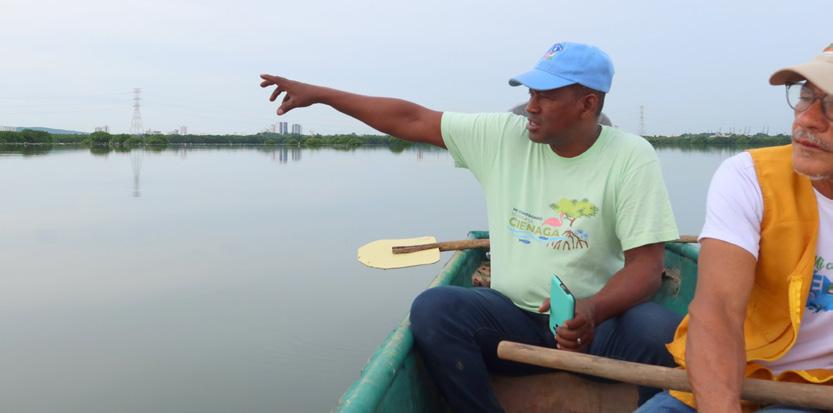
Tourism and recreation
Tourism and recreation activities are widely undertaken within mangroves, both by local communities and visitors. Such activities can help ”build a culture of environmental respect and protection while providing positive experiences to visitors and hosts”10. Importantly, they can also generate an array of livelihood opportunities. Community members may find work as nature guides, providing birding or boat tours, or renting kayaks. Access and interpretation facilities, including boardwalks and information facilities, enhance visitor experiences, while shops can support the wider communities with the sale of local goods.
Recreational fishing, including fly-fishing in mangrove adjacent shallow ”flats”, can be particularly popular. In countries such as the Bahamas, Cuba, and Belize, the best local fishing guides are highly sought-after by international fishers. In Indonesia, the case study
and birdwatching
on page 88 shows how a community transformed their economy through luxury camping (glamping), birdwatching tours, and other ecotourism attractions.
Through case studies presented here and in other reports, the GMA has seen examples of sustainable timber production replacing indiscriminate felling, ecotourism win out over coastal development, and honey production able to supplement fisheries income. It is clear that mangroves are highly valuable, and can keep on giving, when markets are focused on the products that mangroves naturally support, rather than on their exploitation.
10 Das, S. C., Das, S. and Tah. J. (2022). Mangrove Forests and People’s Livelihoods. Pages 153-173 in S. C. Das, Pullaiah, and E. C. Ashton, editors. Mangroves: Biodiversity, Livelihoods and Conservation. Springer Nature Singapore, Singapore.
Eco-tours
are supporting local community initiatives in some of the poorer quarters of Cartagena, Colombia, giving a new income stream and generating a sense of value and pride in the adjacent mangroves.
© Mark Spalding, TNC
6. Saving mangroves
6.1 Protection
Other Effective Area-based Conservation Measures (OECMs) provide an important complement to current protected area systems.
Mark Spalding (The Nature Conservancy (TNC) and Bernal Herrera-Fernández (National University, Costa Rica and IUCN Commission for Ecosystem Management)
Figure 25: Proportion of mangroves protected by country (Source: World Database on Protected Areas).

Urban protected areas give popular access to mangroves in towns and cities, for example in the UAE, Dubai, Singapore, and China.
Given mangroves’ immense value, both to biodiversity and to people, the logic of protecting mangroves is almost unassailable, and hence the call from the Global Mangrove Alliance (GMA) to double protection by 2030. At the same time, this is no small challenge. Some 40% of the world’s remaining mangrove forests are already represented in protected areas. Doubling this to 80%, especially when so many threats remain, will require immense effort.
Existing mangrove protected areas include iconic places such as the Florida Everglades National Park in the U.S.A. and the Daintree National Park in Australia. Urban protected areas give popular access to mangroves in towns and cities, for example in the UAE, Dubai, Singapore, and China. Important and spectacular biodiversity is secured, including Bengal tigers in the Sundarbans World Heritage Site, and over 20,000 flamingos living in the Mexican Biosphere Reserves of Los Petenes and Ría Celestún.
In the current overlay of the World Database on Protected Areas, as can be seen from the map
(Figure 25), the variation in mangrove protection between countries is considerable. Some of the major mangrove nations, such as Brazil, Mexico, and Bangladesh, have already declared over three-quarters of their mangroves as protected. For these countries, doubling protected areas coverage is not possible, although the effectiveness of protection is something that is always important to monitor.
At the other end of the spectrum, many countries still fall below 5% protection, including Malaysia, Papua New Guinea, and Myanmar. Even Indonesia, which still hosts a fifth of the world’s mangroves despite extensive losses, has only placed 15% of what remains within protected areas.
OECMs
Alongside protected areas, there is now widespread recognition that conservation can also be achieved by other means. The abbreviation OECM is used to record such ‘Other Effective Area-based Conservation Measures’. These embrace a host of potential locations and situations outside of protected areas where human impacts or activities may be restricted, or where sustainable uses may be recognized and secured over the long term. They generate effective and secure conservation outcomes equal to, and often complementary to, formally designated protected areas.
Existing guidelines point out that OECMs need to have a clear geographic definition and contain areas of biodiversity interest. They may fall under public, private, or traditional ownership, or a combination of these. As with protected areas, their governance must be equitable and effective1 .
An important element of effectiveness for protected areas and OECMs, which is perhaps particularly important in the case of mangroves, is the need for management to be integrated within the landscape. Given their ecological dynamics, and their close connections to the adjacent watershed and nearby waters, continued ecological integrity often depends on the management of the wider system, beyond the bounds of particular sites.
Many mangrove areas may already be within OECMs. The considerable interdependence between coastal communities and their mangroves means that, partial protection often already exists: local or Indigenous communities may already have ownership, fisheries may already be managed, and rules may already be in place to prevent over-harvest or forest clearance. Such frameworks may already have created OECMs, which simply need to be called out and accounted for. Elsewhere, just a few additional measures may be required to bring new sites into the classification of OECMs.
In a recent review of OECMs in Central America2, two case studies were considered. The Karataska Lagoon System in Honduras is a large, mangrove-fringed lagoon facing the Caribbean Sea that falls under the jurisdiction of Territorial Councils of the Indigenous Miskito people, for whom fishing is a critical livelihood. The Barra de Santiago is an important mangrove and wetland complex on the Pacific coast of El Salvador that supports a large range of local livelihoods, including artisanal fishing and tourism, and has some governance structures in place.

Community tenure in Indonesia
Juan Robalino (Landesa)
In Nagekeo Regency in East Nusa Tenggara Province, Indonesia, Landesa is partnering with the regency to protect mangroves through improved community tenure under its Coastal Livelihoods and Mangroves Project. In 2023, the project conducted a mangrove ecosystem valuation to estimate the value provided by ca. 650 ha of fringing mangroves along the coastline, including from fishing, raw materials, eco-tourism, coastal protection, and carbon sequestration.
Compared with other economic activities that apply pressure for land transformation, Landesa has demonstrated the high dependency on mangrove resources and services by coastal communities, and strengthened the evidence for securing collective tenure rights for mangrove protection.
1
tool for identifying other effective area-based conservation measures (OECMs). IUCN
Photo: © Landesa
IUCN-WCPA Task Force on OECMs. (2019). Recognising and reporting other effective area-based conservation measures. IUCN, International Union for Conservation of Nature and Natural Resources, Gland, Switzerland. Jonas, H. D., MacKinnon, K., Marnewick, D., and Wood. P. (2023). Site-level
2 Herrera Fernández, B., and Courrau Arias, J. (2024). Other Effective Area-based Conservation Measures (OECMs): concept guide and guidelines for their identification and monitoring in Central America. IUCN
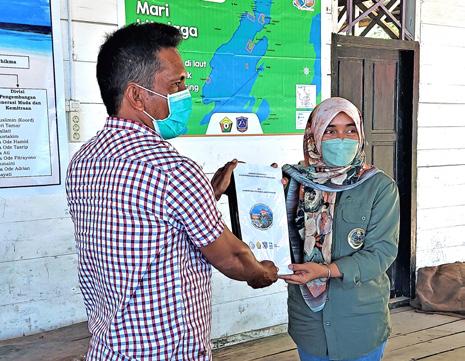
Combining protection and sustainable management in community seas
Hari Kushardanto, (Rare)
In southeast Sulawesi, Indonesia, Rare has helped establish 16 “Managed Access with Reserves (MA+R)” areas, with 17 more in the pipeline. The first approval of such ”managed access’ fishing areas in 2022 was a significant milestone. The government gave coastal fishing communities the legal basis to access and manage their fishing grounds and near-shore waters. Fisher-led fisheries management systems like MA+R are working towards legal designation to become a fishery-based OECM, clearly contributing towards global biodiversity goals like 30x30.
Rare is planning five more MA+Rs across coastal environments in this province, including extensive mangrove ecosystems, which will also serve as a metric for the first-of-its-kind Small-Scale Fisheries (SSF) Impact Bond.
OECMs represent an opportunity
to mainstream biodiversity in other development sectors, such as food security, energy security and water security.
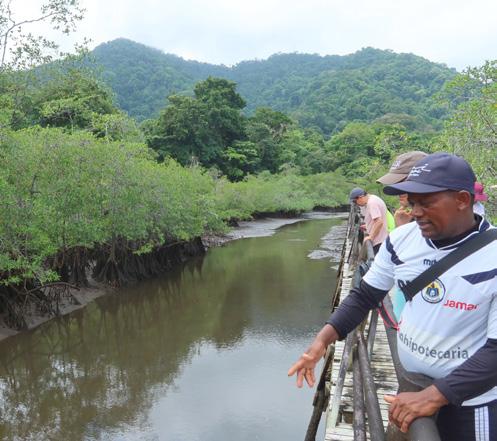

Extractive reserve designation, Brazil
Maura Sousa, (Rare)
In both cases, there is a clear and strong biodiversity case and an existing management structure. However, both also have shortfalls, with existing pressures (Honduras) or concerns of inequity in benefits or potential negative impacts on Indigenous or local communities (El Salvador). Given these concerns, neither site was considered sufficiently protected to qualify as an OECM yet, although both have the structures in place to enable recognition with relatively minor changes.
It was clear, from this study, that the strong linkages between biodiversity, ecosystem services, and livelihoods make a highly positive case of OECMs. They represent an opportunity to mainstream biodiversity in other development sectors, such as food security, energy security, water security, and to apply more comprehensive management, where the narrower conservation focus of protected areas may be less appropriate.
At the same time, there is a risk that if the process of recognition of OECMs is seen as too onerous, it may deter authorities, landowners, or stakeholders from designating sites. Many existing protected areas have their own weaknesses, but they are still counted as “protected” in national and global statistics and there may be an argument for encouraging recognition for a wider array of sites. The recognition of any conserved space, whether protected area or OECM, provides an important baseline and a focal point for continuing efforts to improve conditions and sustainability.
OECMs will provide an important complement to the current protected area systems in the coming years. We need to identify and support them, but also to ensure that they become a more integral part of the framework, more fully incorporated into systematic conservation planning.
In March 2024, the Brazilian government established two new Marine Resex (Filhos do Mangue and Viriandeua) in mangrove-rich areas of Pará State, the culmination of 16 years of pressure from fishing communities.
The Resex, or extractive reserve designation, is a protected areas designation that allows traditional communities, such as fishers, crabbers, oyster gleaners, and other local harvesters, to use the area while protecting vital ecosystems from deforestation and industrial development.
The push for the Resex designation was initiated by local communities in 2007. Rare joined the effort in 2022, acting as a liaison between local communities, the state, and national governments, while also promoting sustainable fishing practices among local fishers.
Photo: Mr. La Ode Muh Sidik Izhan, head of Fisher Group from Pasikolaga, officially hands over the MA+R plan to Ms. Femmy M. Yosman from the Province Office for Fisheries and Marine Affairs. © Rare
Photo: The Paracauari River and mangroves. Resex Soure, Marajó Island, Pará (state), Brazil © Enrico Marone, Rare
A guide on the boardwalk in Utria National Natural Park in Colombia pointing out marine life in the mangrove channels. © Mark Spalding, TNC
6.2 Alerts for action
Half of the world’s mangrove forest area is currently monitored for losses by GMW’s alerts system.
Lammert Hilarides, Susanna Tol, Edmond Kuto (Wetlands International), Pete Bunting (Aberystwyth University), Veerachai Tanpipat and Pasin Maprasom (Ministry of Natural Resources and Environment, Thailand), Paula Castro Brandão Vaz dos Santos (Wageningen University & Research)
Mangrove losses typically occur over short time periods. Yet in annual mangrove extent maps, such as the Global Mangrove Watch (GMW) extent layers, information only changes a year or more after a loss occurs. The recognition that a quicker way of identifying mangrove loss is imperative led to the development of the GMW mangrove loss alerts product3.
The loss alerts provide monthly updates, are fine-tuned to mangrove forests, and complement other existing deforestation monitoring systems, such as the Global Forest Watch’s GLAD and RADD alert systems. The system is well equipped to detect where and when mangroves are lost.
Fifty percent of the world’s mangrove forest area is currently monitored by the loss alerts system, with over 600,000 alerts identified between 2019 and early 2024 (Figure 26). An analysis found that 35% (189,500) of
The GMW mangrove loss alert system was implemented using the Microsoft Planetary Computer, which provides a cloud computing environment for the analysis of satellite imagery. The alerts system makes use of Copernicus Sentinel-2 satellite imagery processed to a resolution of 20 meters. A Sentinel-2 acquisition is typically once a week, but due to cloud cover and multiple observations required to confirm a change, it takes, on average, three months from a change occurring to the system alerting of the change. Details of the method can be found within Bunting et al. (2023)3.
all the alerts were generated in Myanmar (Figure 27), making it the region where mangroves are currently most rapidly deforested.
Work is underway to scale the alerts globally and to further increase the timeliness and accuracy of the alerts by integrating additional earth observation data in the analysis. Although the alerts make it possible for mangrove guardians to respond quickly when loss is discovered, a vital additional component is needed. Information about the causes and pressures of loss behind an alert is difficult to gather through remote sensing alone and, as such, it has not been possible to differentiate between human and natural causes. This is where guardians on the ground are vital to verify and validate alerts, providing further insight into the causes and intervening where feasible to prevent further loss or to restore.
3 Bunting, P., Hilarides, L., Rosenqvist, A., Lucas, R.M., Kuto, E., Gueye, Y., Ndiaye, L. (2023) Global Mangrove Watch: Monthly Alerts of Mangrove Loss for Africa. Remote Sensing., 15, 2050.

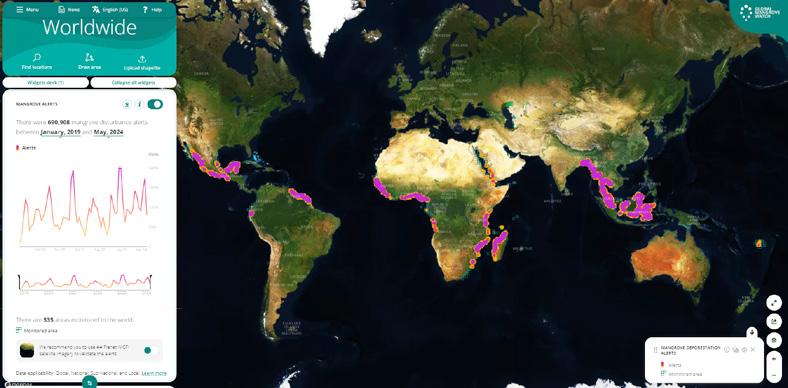
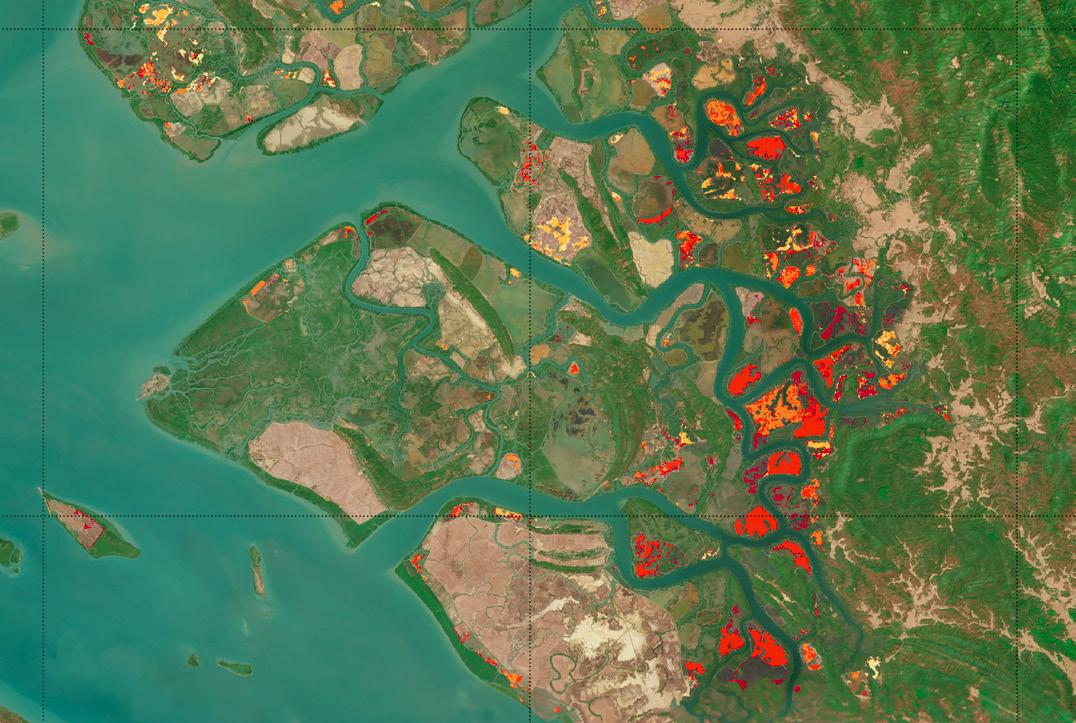
Mangrove loss
Figure 27: Inset: GMW mangrove loss alerts in part of Rakhine State in Myanmar showing intense recent losses on the landwards margins.
Figure 26: Screen shot from the GMW platform showing alerts observed in the past five years (yellow to purple with increasing intensity). Blue squares show the full extent of the alert monitoring in May 2024.

Technology monitors mangrove loss in Thailand
Previously a time and money-consuming activity, the monitoring of Thailand’s mangrove forests is now automated. Historically, cars, motorcycles, boats, and sometimes even helicopters, were used for monitoring but proved resourceintense and imprecise. Instead, the Department of Marine and Coastal Resources currently relies on GMW alerts.
Mangroves in Thailand shield its shores from storm surges and rising sea levels and are vital for sustenance and livelihoods. With mangrove loss data now delivered in near-real time, authorities can redirect resources to the issue, with a focus on ecological mangrove restoration over planting, which has had a high failure rate in the past.
Photo: Lost and degraded mangroves detected through GMW alerts in Satun, Thailand. © Pasin Maprasop

GMW alerts provide relief for patrollers in the Rufiji Delta, Tanzania
Mangrove practitioners in the Rufiji Delta make frequent patrols to monitor mangroves, relying on tip-offs from concerned citizens and fisherfolk. A big challenge has been verifying such tips before site visits, where, sometimes, no substantial disturbances warrant concerns, straining their limited resources.
Wetlands International trained 25 Tanzania Forest Service officers and Village Natural Resource Committee members on using the GMW loss alerts functionality. They received 11 tablet computers to facilitate their patrols and practiced hands-on exercises that used the loss alert datasets in ready-to-use formats with open-source navigation mobile applications. The monitoring teams now feel more confident about site visits to verify disturbances.
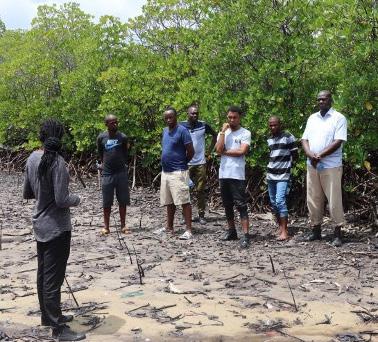
Integrating local and GMW alerts in Lamu, Kenya
A first-of-its-kind Mangrove Alert Centre will soon be established in Lamu to monitor mangrove degradation and loss, and to identify its causes. After GMW alerts training in 2023, the Kenya Forest Service (KFS) and Wetlands International decided to establish the Centre to show how the local KFS alert system and the GMW alerts can complement each other. This Centre will host computers that integrate the alerts, offering enhanced quality and quantity of images, crucial for cloudy days. Forest rangers will soon have comprehensive insights before setting out on fieldwork, optimizing conservation efforts.
Photo: © Wetlands International
Photo: © Wetlands International
6.3 Restoration: a growing momentum
New guidelines give project managers, investors, and policymakers step by-step advice for every phase of the restoration project cycle.
Elena Roddom (Wetlands International), Laura Michie (Mangrove Action Project), Lydia Slobodian (Georgetown University), Justine Bell-James (University of Queensland), Chris Brown (University of Tasmania)
Mangrove restoration is receiving increased attention fueled by national and international targets. From the Bonn Challenge to GMA’s target of restoring just over 4,000 km2 by 2030, ambitious goals are catalyzing collective action across science, policy, and practice. New tools, resources, and training programs are helping to improve mangrove restoration and conservation, and efforts on the ground are increasing worldwide.
Fueled in part by the many examples of restoration failures, the 2022 edition of The State of the World’s Mangroves focused on restoration, and included the promotion of best practices and effective approaches.
Many now advocate for the most successful ecological mangrove restoration approaches, which aim to create the right biophysical conditions for mangroves to grow
The Guidelines act as a one-stopshop, where users can easily find all the information to successfully restore mangroves.
back naturally and to foster the right socioeconomic conditions to incentivize mangroves’ long-term protection (as an example, see Box 7 on Community-
Based Ecological Mangrove Restoration approach (CBEMR)). In other settings, such as eroding coastlines, integrated engineering approaches are also being promoted, as is the case of the innovative UN flagship Indonesia’s Building with Nature.
Restoration requires capacity-building and dedicated efforts to match restoration opportunities with funding and investors. Global tools like the Mangrove Restoration Tracker Tool have been developed to encourage adequate reporting and monitoring, and to facilitate the sharing of experiences and best practices globally4. Investment in additional research to resolve legal barriers around tenure laws and policies is also a priority.
4 Lovelock, C.E., Barbier, E. and Duarte. C.M. (2022). Tackling the mangrove restoration challenge. PLOS Biology 20:e3001836.
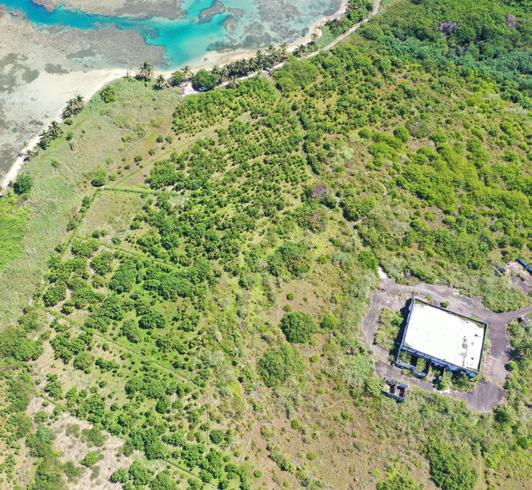
Through a successful methodology involving the construction of canals and direct mangrove planting, this military base in Galeta Island, Panama, has been restored into a thriving mangrove forest © Andrés E. Fraiz T., Wetlands International.

Since 2013, substantial losses of mangroves in Costa Rica’s Gulf of Nicoya have been reversed through hydrological rehabilitation. Channels have been cleared and new channels created to allow tidal flows and natural mangrove regeneration, while enhancing ecosystem services and biodiversity. For further information, see: CATIE (in Spanish) © Danilo Torres Gómez, CATIE.

RE3CO
Valeria López Portillo Purata &
Rodríguez (World Resources Institute (WRI))
Mexico boasts the world’s fourth-largest mangrove area, spanning more than 900,000 hectares. Extensive areas of Mexico’s mangroves have been decimated through the unchecked expansion of tourism, urbanization, and land use changes, particularly for agriculture and cattle grazing.
Through the RE3CO initiative, WRI supports local organizations that are leading restoration efforts on the ground, securing economic independence and numerous social benefits including job opportunities and a reduced gender wage gap. So far, the Mangrove Guardians have restored and conserved more than 6,200 hectares and proven that this nature-based solution can simultaneously reduce greenhouse gas emissions, enhance climate resilience, and generate multiple economic and social benefits for local communities.
Sarai
Photo © WRI
Restoration guidance
In October 2023, the GMA and the Blue Carbon Initiative developed the Best Practice Guidelines for Mangrove Restoration. The Guidelines were developed to provide project managers, investors, and policymakers with a step-by-step approach for every phase of the project cycle, from project design and funding, to implementation. It focuses on inclusive, communitybased approaches which have been shown to enhance restoration success and longevity.
The Guidelines act as a one-stop-shop, where users can easily find all the information to successfully restore mangroves. They point to existing resources and fill gaps as needed. Knowing that when it comes to restoration
one size doesn’t fit all, the Guidelines provide pathways to decide which approaches are appropriate for specific restoration contexts, goals, and objectives.
They are broken down into four core sections (Figure 28):
Phase 1 provides guidance on how to set goals and assess the suitability of the project.
Phase 2 guides on project design, specifically how to understand socio-economic and biophysical factors.
Phase 3 dives into the practicalities of project implementation and funding, and how to engage stakeholders and measure progress.
Phase 4 offers guidance on monitoring, evaluation and adaptive management.

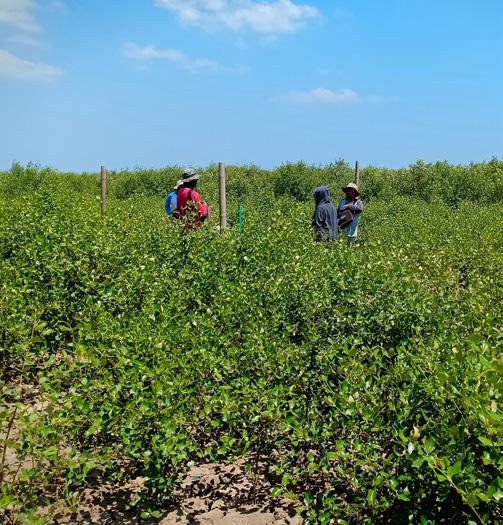
From

Community restoration, Malaysia
Nagarajan Rengasamy, (Global Environment Centre)
Incorporating local communities into mangrove conservation efforts is crucial for long-term sustainability. Economic incentives, such as tree buyback systems, community-led planting initiatives, and post-planting maintenance and protection serve as powerful drivers for participation. Drawing from its 25year experience, the Global Environment Centre (GEC) in Malaysia emphasizes the importance of integrating ecological and socio-economic indicators into mangrove conservation strategies for lasting success. Partnering with enthusiastic local community groups amplifies impact and fosters a sense of ownership. Advocating for the inclusion of these indicators in policies can further enhance community involvement and facilitate the transition towards a circular economy rooted in mangrove conservation.
barren to thriving: a dedicated community group in Demak, Central Java, Indonesia, successfully restored mangroves on their eroding coastline using an ecological mangrove restoration method in which the stabilization of coastal sediments allows for the natural regeneration of mangroves. © Kuswantoro, Wetlands International Indonesia.
Photo: © Global Environment Centre (GEC)
Figure 28: The best practices shared in the Guidelines and through case studies are based on lessons learned from real-world projects. They shift the approach from single-species
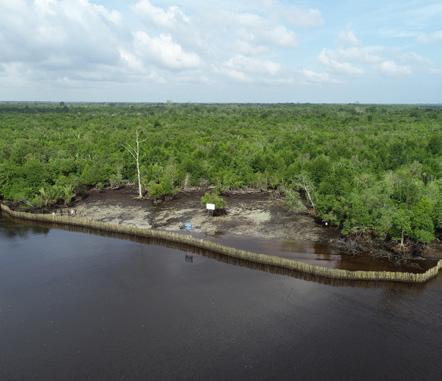
The Mangrove Restoration Tracker Tool in action
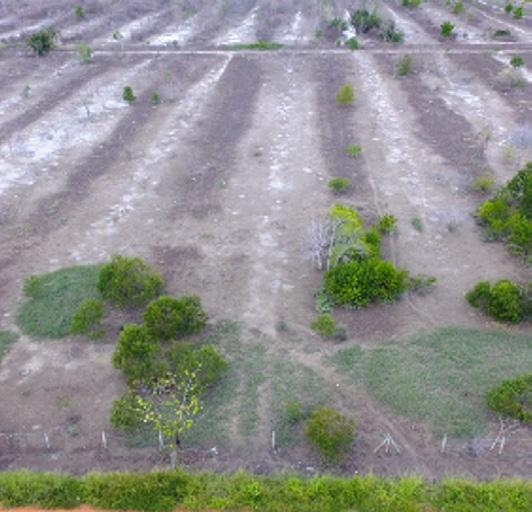
Yayasan Konservasi Alam Nusantara (YKAN) is supporting mangrove restoration in collaboration with the government and other partners. The work is carried out by personnel at sites across several regions (including East Kalimantan and Riau Province).
The Mangrove Restoration Tracker Tool has proven to be an effective and efficient data recording system that can capture data for multiple sites. It includes comprehensive monitoring parameters that are easy to use, even in the field.
While YKAN feel the MRTT would benefit from visualization tools and increased access to restoration data from other sites, it has been useful to manage restoration progress, and YKAN partners are committed to increasing its uptake.

Six guiding principles for successful mangrove restoration
To ensure a holistic vision of mangrove restoration, the GMA partners, scientists, and practitioners developed six guiding principles that serve as guardrails for successful mangrove restoration and can be applied in every phase of the project cycle.
Principle 1: Safeguard nature and maximize biodiversity
Protect the remaining intact mangrove ecosystems, enhance their resilience, and implement science-based ecological restoration protocols.
Principle 2: Employ the best information and practices
Use the best available science-based knowledge, including Indigenous, traditional, and local knowledge, for mangrove interventions.
Principle 3: Empower people and address their needs
Implement, in all aspects of project design, social safeguards that operate locally and contextually to protect and enhance community member rights, knowledge, and leadership to achieve fair and equitable benefit sharing.
Principle 4: Align to the broader context –operate locally and contextually
Operate in the local context, including cultural customs, resource use, management, and ownership regimes, while taking a land and seascape approach and aligning to international trends and their local implications.
Principle 5: Design for sustainability
Create sustainable mangrove projects and programs that are inclusive of how these initiatives will last into the future, including considerations for financing, threat abatement, community stewardship, and climate change.
Principle 6: Mobilize high-integrity capital
Ensure capital flows at the scale needed and allow funding to be distributed to ready-to-scale projects.
The process of successful mangrove restoration is nuanced, complex, and site-specific. Comprehensive project designs bring together community leaders, local stakeholders, and project managers with experts in restoration, data collection, and ecology, and facilitate knowledge sharing and capacity building across the project team.
Aji Anggoro, Topik Hidayat (YKAN)
Photo: Preventing further erosion through a sediment entrapment breakwater. © Miftahul Bayyan (YKAN)
The Global Environment Centre, Sahabat Hutan Bakau Kampung Dato’ Hormat, and local stakeholders in Malaysia managed tidal hydrology and planted 60,000 mangroves in a successful restoration project that enriched the habitat, biodiversity, and carbon storage.
© Global Environment Centre (GEC).
The Community-Based Ecological Mangrove Restoration (CBEMR) method
The Community-Based Ecological Mangrove Restoration (CBEMR) method, pioneered by the Mangrove Action Project (MAP), represents an innovative approach to mangrove restoration that has garnered global recognition for its efficacy and sustainability.
Employ the best information and practices
Unlike traditional planting projects, this method focuses on a holistic approach that prioritizes the restoration of fundamental ecological processes. This involves analyzing biophysical parameters, like hydrology and topography, as well as socio-economic factors, such as land tenure and livelihoods.
Implementation of CBEMR involves a range of activities tailored to each site. By integrating traditional knowledge with scientific expertise, CBEMR projects foster adaptive management practices that respond to changing environmental conditions and community needs.
Empower people and address their needs
Key to the success of CBEMR is its emphasis on community involvement and empowerment. By engaging local stakeholders, including community members, NGOs, and government representatives, from the outset, CBEMR ensures that restoration efforts are not only effective but also sustainable in the long term. Local communities are empowered to become stewards of their mangrove ecosystems, fostering a sense of ownership and responsibility.
Safeguard nature
Crucially, CBEMR also recognizes conservation over restoration, acknowledging the irreplaceable value of existing mangrove ecosystems. Mature mangroves serve as vital seed and propagule sources, support biodiversity, and provide ecosystem services. Therefore, CBEMR encourages the conservation of healthy mangroves before embarking on restoration efforts.
Align
to the broader
context –operate locally and contextually
Community collaboration and background research are foundational to the CBEMR process. Engaging with local communities allows for a deeper understanding of the site dynamics, historical context, and socioeconomic factors influencing mangrove health. Through stakeholder consultations and participatory decisionmaking, CBEMR projects establish clear objectives and action plans that align with local needs and aspirations.
Design for sustainability
The MAP team conducts CBEMR training workshops, where participants learn how to identify the underlying stressors behind previous mangrove loss, as well as concrete methods for improving biophysical and socio-economic outcomes.
By building capacity among practitioners and communities, CBEMR facilitates more effective restoration efforts. The CBEMR method has been implemented worldwide, demonstrating its adaptability to diverse environmental and socioeconomic contexts.
Mobilize high-integrity capital
Investments in mangrove restoration projects had been considered ‘risky’ since many projects celebrated large planting efforts, yet saw failure rates of up to 90% in the following years. But methods like CBEMR have proven replicable and scalable, resulting in projects with long-term success that are worth investing in. Conservation and restoration of mangroves is starting to attract large-scale finance aimed at supporting local to national-scale actions.

Policies and permitting 2030 Targets
Under the UN Decade on Ecosystem Restoration and the Kunming-Montreal Global Biodiversity Framework (GBF) (2022) countries pledge to “ensure that by 2030 at least 30% of areas of degraded terrestrial, inland water, and marine and coastal ecosystems are under effective restoration…”. Questions still exist regarding the legal interpretation of this Target: narrow definitions of terms like “degraded” and “effective” could reduce the footprint of ecosystems that need to be restored. It is also unclear whether countries should spread their efforts across terrestrial and coastal and marine ecosystems, or whether they can focus primarily on terrestrial ecosystems5.
Legal permitting frameworks
Restoration is a local activity but depends highly on national plans and policies. Costa Rica’s National Blue Carbon Strategy aims to facilitate mangrove conservation
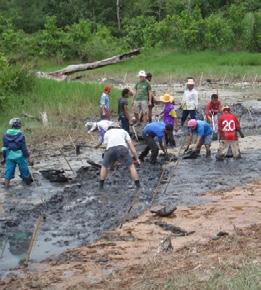
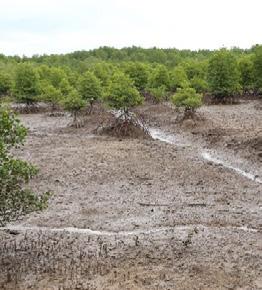
and restoration by engaging communities in carbon credit programs. By contrast, complex permitting frameworks can prove to be costly and time-consuming, and have even led to some proponents abandoning restoration.
Tenure is also a complicating factor in many countries, with mangroves occupying spaces which may include public, private, and even Indigenous tenures. This raises issues as to who has legal rights to carry out projects, who has the entitlements to any benefits generated from projects (e.g. carbon credits), and who has legal responsibility for any adverse effects that may arise from a project (e.g. flooding of neighboring land).
Resolving these legal barriers requires additional research and targeted law and policy reform to facilitate mangrove restoration and allow for rapid up-scaling of restorative actions.
5 Bell-James, J., Foster, R., Shumway, N. (2023) The permitting process for marine and coastal restoration: A barrier to achieving global restoration targets?. 5(12) Conservation Science and Practice e13050.
The process of CBEMR in practice in Ban Lang Da, Krabi, Thailand. Left: the abandoned shrimp pond in 2010. Middle: community engagement in restoring the hydrology to allow natural water flows and encourage natural mangrove regeneration. Right: the same site in 2018 with extensive natural mangrove © MAP.
7. The way ahead 7.1 Financing for success

The pathway to finance for mangrove protection is now much clearer thanks to The Mangrove Breakthrough’s Roadmap.
Stefanie Simpson, Emily Landis, and Christine McClung (The Nature Conservancy (TNC)), Jennifer Ring (Systemiq), Jennifer Howard (Conservation International (CI))
Efforts to restore lost mangroves, and protect those that remain, are gaining traction. But there remain large funding needs to accomplish these goals.
Many benefits of conserving and restoring mangroves can be underpinned by strong financial arguments. By investing in mangroves, we not only protect ecosystems, but also enhance economic gains through tourism, fisheries, and carbon sequestration, and prevent economic losses associated with storm surges and coastal flooding.
This decade represents our “last best chance” to reverse downward trends in the status of mangroves and it is imperative for the financial sector to enhance its commitments. We have known that a diverse funding approach is necessary to mangrove conservation, but the pathway to this was unclear. Since the 2022 State of the World’s Mangroves report, we have seen significant progress in outlining financial needs and a roadmap through The Mangrove Breakthrough.
At COP28, countries and non-state actors committed to restoring 15 million hectares (ha) of mangrove by 2030, aiming for sustainable finance of US$4 billion. These commitments signal an impactful moment for mangroves on the global stage. Now we look to mobilize this roadmap.
By investing in mangroves, we not only protect ecosystems, but also enhance economic gains through tourism, fisheries, and carbon sequestration.
The following includes partner perspectives and case studies on finance mechanisms that will support our mangrove goals, from the growth of blue carbon markets, the realization of mangrove insurance, and the emergence of blue carbon positive business economies, all underpinned by support from visionary philanthropic coalitions.
The GMA, Mangrove Alliance for Climate, and other partners convened at COP28 to discuss implementation of the Mangrove Breakthrough Finance Roadmap. © COP28 UAE
The Mangrove Breakthrough
The Mangrove Breakthrough Financial Roadmap outlines a strategic plan to catalyze finance for mangroves. Today, these vital ecosystems are massively underfunded. But ~US$4 billion in investment by 2030 could unlock sustainable, long-term flows of capital in regenerative models, like blue carbon, sustainable fisheries, aquaculture, and ecotourism, that ensure mangroves are more valuable standing than destroyed.
Scaling investment calls for action to build a pipeline, create proof points, and shift incentives. To unlock the change needed, the Financial Roadmap recommends a “toolbox” of seven complementary financial mechanisms, including incubators to create and scale new projects, debt for small- and medium-sized enterprises, microfinance, blue bonds, and innovative mangrovelinked insurance.
No single organization can deliver this alone. Private, public, and philanthropic capital with different mandates and risk-return profiles must all step up.

US$4 billion in investment by 2030 could unlock sustainable, long-term flows of capital in regenerative models, that ensure mangroves are more valuable standing than destroyed.
Combining these sources of capital in “blended” mechanisms will be key to de-risking private investment in nascent business models and emerging markets.
In parallel, critical enabling conditions are needed for these mechanisms to succeed. These include supportive policies, robust frameworks, and strong community engagement to ensure that investments translate into tangible conservation outcomes while boosting livelihoods and wellbeing. Taken together, these strategies aim to unlock investment in mangroves as a key component of resilient, low carbon, and naturepositive economic development.
BC+ will explore business models that tightly weave together protection and production goals, making coastal habitat preservation a crucial component of success. While specific interventions will vary based on the economic and ecosystem context, BC+ will focus on developing regenerative blue carbon business models that enhance healthy ecosystems, increase revenue generation, and enhance ecological function while minimizing disturbance. Examples include saltwater agriculture and mangrove positive aquaculture.
BC+ will achieve this by identifying and scaling up successful business models and encouraging widespread adoption through grants and technical assistance for implementing partners. By 2050, the program aims to:
1. Conserve and restore up to 16.9 million hectares of mangroves, seagrasses, tidal marshes, and kelp.
2. Achieve climate benefits up to 2.2 gigatons (Gt) of CO2e.
3. Increase incomes for over 50 million people.
7.1.1 Visionary philanthropy
Philanthropic investments offer huge flexibility.
Peter Bryant (Builders Vision)
And yet, up until about 2020, mangrove conservation had not received meaningful funding at scale. Just 1% of all marine conservation philanthropic support went towards mangroves.
Considering mangrove systems’ invaluable benefits and ecosystem services, it is hard to understand why they have not received the attention or funding needed. These ecosystems are vital in combating climate change and sustaining community resilience.
It is fulfilling to see that funders are beginning to realize how important mangrove systems are. Philanthropic support for mangrove conservation continues to rise, and this past year, a group of U.S. and European foundations launched the Ocean Resilience & Climate Alliance (ORCA) to catalyze new capital commitments for mangroves and other blue carbon systems. I’m pleased to say that ORCA just passed US$300 million in new commitments to oceans-climate solutions. Part of that funding will be dedicated to increasing efforts to conserve mangrove systems all over the world.
Over the next 1-3 years, my hope is that philanthropic investments will have laid the groundwork for sustainable mangrove conservation models, substantially increased the area of mangroves under effective management, and demonstrated successful strategies that can attract broader investments from other sectors and partners like investors, development agencies, and the banking/insurance sector.
Led by CI and TNC, with support from partners including the Mangrove Breakthrough and the GMA, BC+ is looking beyond carbon markets to showcase innovative business models and secure funding for coastal conservation by engaging with governments, local stakeholders, and financial institutions.
Philanthropies play an indispensable role in mangrove conservation, particularly by providing the flexible capital that is crucial for nurturing early-stage projects, pioneering new business models, enhancing local capacities, and de-risking ventures to elevate their impact at scale. This flexibility allows philanthropic funds to fill gaps that other forms of capital, constrained by stricter requirements and return expectations, cannot address.
Ultimately, the goal is to ensure that these vital ecosystems are preserved and enhanced as a critical component of global environmental health, climate resilience, and community wellbeing.
Blue Carbon Positive Business Model Activator (BC+)
The Sundarbans coastal communities are transforming their future by producing, packaging and marketing a variety of natural mangrove products such as mangrove tea, pickle, juice, and molasses under the brand name BANOJIBI, as well as helping to restore the mangrove forest along the river bank. © BEDS (Bangladesh Environment and Development Society).
7.1.2 Unlocking the potential of carbon markets
Carbon credits and carbon markets can drive capital towards critical climate and nature solutions.
Whitney Johnston (Salesforce)
Carbon markets can play an important role in unlocking finance for mangrove conservation and restoration. Over 1 million hectares of mangroves are considered financially viable for carbon finance, providing more than 30 million tons of CO2e in annual climate mitigation1
Demand for high-quality blue carbon credits is potentially worth US$10 billion2, but there is a pressing need for more high-quality projects to meet the growing demand and a need for solutions to mobilize investment.
To build confidence and catalyze demand, corporate buyers need assurance of delivery timelines, volume, and quality. Quality frameworks (e.g., the IC-VCM Core Carbon Principles Framework), transparent reporting, third-party verification, independent ratings, and risktransfer products (e.g., insurance and guarantees) are essential tools for building trust and credibility in this nascent market.
While carbon credits and carbon markets are far from perfect, they have the potential to drive capital towards critical climate and nature solutions. Carbon credits should only be used as part of a comprehensive climate strategy that includes decarbonization as a top priority.
Over 1 million hectares of mangroves are considered financially viable for carbon finance, providing more than 30 million tons of CO2e in annual climate mitigation1.
Salesforce seeks to strengthen the broader carbon market and to help scale blue carbon in service to a net zero and nature-positive future, grounded in people and climate justice. We set a goal to purchase 1 million tons of high-quality blue carbon credits, provided funding for four early-stage blue carbon projects, and helped develop the High-Quality Blue Carbon Principles and Guidance. Most recently, we invested in a technology solution for blended finance – the ORRAA Octopus Desk.
While corporate buyers can play a critical role, many players and levers will be needed to realize the potential of blue carbon. Each blue carbon investment represents a unique opportunity and risk profile that must be matched with the appropriate type(s) of capital and risk mitigation measures, for which a blended finance approach can be impactful alongside the development of clearer policies and frameworks.
1 Yiwen, Z.,Friess, D., Sarira, T., Siman, K., Koh, L. (2021). Global potential and limits of mangrove blue carbon for climate change mitigation.
2
e0000061.
We are aiming to realize our commitment to procure 1 million tons of high-quality blue carbon credits, while also investing in enabling conditions to create a rising tide of finance for mangroves that lifts all boats.
7.1.3 Insuring resilience
By cushioning communities from natural disasters, mangroves are highly relevant to the insurance industry.
Suzanne Scatliffe (AXA XL)
Healthy mangrove forests are effective natural barriers against hurricanes, storm surges, and erosion. They reduce the risk and severity of property damage in coastal areas and preserve livelihoods – qualities that are highly relevant for the insurance industry.
There are many ways that insurance companies can help to protect these critical ecosystems:
1. Cost-effective protection. Conservation and restoration of mangroves can often be more costeffective than constructing man-made infrastructure for coastal protection. Insurers can consider funding mangrove protection projects through NGO partnerships to increase resilience against natural disasters.
2. Data and research collaboration: Insurance companies can collaborate on research initiatives to better quantify the economic value of mangroves and the specific benefits they offer in terms of risk mitigation. This data can inform more accurate pricing of insurance products and the development of specialized policies that reflect the protective value of natural ecosystems.
There are many ways that insurance companies can help to protect these critical ecosystems.
3. Community benefits: Beyond just protecting physical assets, mangroves provide critical ecosystem services such as fisheries enhancement and water purification, supporting local livelihoods. Through mangrove conservation investments, companies can align their corporate citizenship or social responsibility goals with their fundamental purpose of building societal resilience.
Read more about our mangrove insurance project in the case study on page 118 and, how AXA XL is supporting development of Blue Carbon Resilience Credits
Current Biology. 31.
Friess D.A., Howard, J., Huxham, M., Macreadie, P.I., Ross, F. (2022) Capitalizing on the global financial interest in blue carbon. PLOS Climate 1(8):
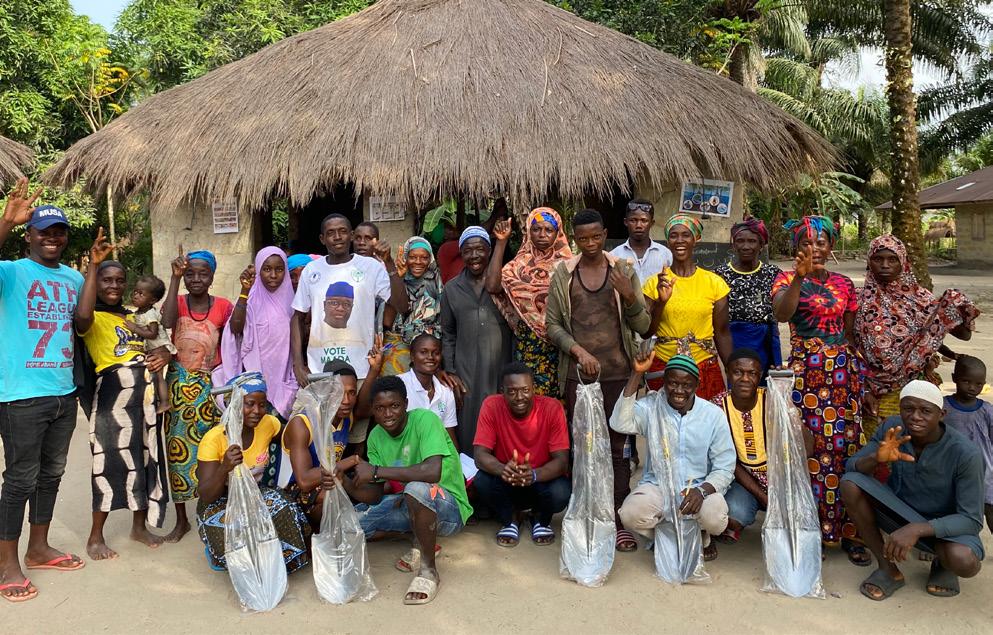
Community-centric blue carbon in West Africa
John Stelzer (West Africa Blue)
West Africa has lost between 25% and 50% of its mangrove forests over the past 30 years due to overfishing and population pressures. Coastal communities in the region are also among the poorest and most climate-vulnerable in the world.
West Africa Blue (“Blue”) is a project developer specializing in large-scale, locally led mangrove conservation and restoration. Building on longstanding, trusted relationships with community partners, Blue’s projects mitigate climate change, provide adaptation benefits, protect biodiversity, and enhance livelihoods, especially for women.
Blue is using a blended financing model, including grants, technical assistance, and impact investment, combined with carbon finance, to mobilize and operate its projects. Innovative de-risking structures have also been employed, such as political risk insurance, and have attracted investors that are new to West Africa. Blue is aiming to help catalyze the market for sustainable blue carbon by sharing lessons learned from its first two projects in Sierra Leone and Guinea, including a transparent benefits-sharing framework.
Blue’s team facilitates a community-led mangrove conservation and restoration project, starting with educational modules aligned with the principle of free, prior and informed consent (FPIC). Photo: © Max Mayer, West Africa Blue

San Crisanto mangrove insurance
Ariane Kaploun and Ana Pachon (AXA Climate)
San Crisanto is a fishing community made up of approximately 150 Mayan families within the Yucatán Peninsula, Mexico. Their economic activity has been structured around 800 hectares of mangrove forest through restoration and conservation financed through the sale of carbon credits, as well as the development of ecotourism.
This mangrove forest is highly exposed to natural disasters. In 2002, Hurricane Isidore destroyed 99% of the area, causing significant flooding and bringing local economic activity to a halt.
AXA Climate hence developed an innovative parametric product to protect the community against hurricanes. This insurance will play an essential role by facilitating rapid financing for damaged mangrove forests to be restored, as well as the repairs of related infrastructure linked to fishing or ecotourism.
Photo: © ClimateSeed

Parametric insurance
Diane Figueroa and Jacob Ashton (Rare)
Rare and the leading global advisory, broking and risk solutions company Willis Towers Watson (WTW) are designing a parametric insurance product that helps Filipino fishers adapt to climate change by reimbursing lost income incurred from bad weather days. This builds resilience in coastal communities, better equipping them to steward local mangrove forests and other ecosystems.
Parametric insurance provides pay-outs based on the nature of a hazard event rather than the scale of loss incurred, which dramatically accelerates payouts following a hazard event. Such insurance is only available for registered fishers, encouraging commitment to sustainable fishing. Supporting such livelihoods also helps avert unsustainable extraction from nearby vulnerable coastal ecosystems, including mangroves.
Photo: Fishers gathering shellfish in Del Carmen, Philippines. © Rare
7.2 Progress in policy
Climate change, biodiversity, fisheries, and agricultural policies all recognize the importance of mangroves.
Luz Gil (The Nature Conservancy (TNC)), Susanna Tol (Wetlands International (WI)), Adriana Vidal, Anete Berzina-Rodrigo, and Vatosoa Rakotondrazafy (International Union for Conservation of Nature (IUCN)), Lydia Slobodian (Georgetown University), Justine Bell-James (University of Queensland), Tanmatra Bhanti and Emily Goodwin (Rare)
Given their immense relevance, from local to global scales, mangroves are significantly influenced by policies at all levels, ranging from local zoning regulations to global environment and climate agreements. Consequently, ensuring the successful protection of mangrove ecosystems requires coordinated efforts across national and international levels, underpinned by robust policy frameworks.
As growing populations have increased food demand, agriculture and aquaculture policies have been major drivers of mangrove loss and degradation around the world. However, as our scientific understanding of mangroves’ importance for food and livelihoods has grown, national policies have also shifted to protect and restore mangroves as a key component of fisheries and food security.
The successful protection of mangrove ecosystems requires coordinated efforts across national and international levels, underpinned by robust policy frameworks.
International developments for mangrove action
International policy agreements drive global collective action, guiding national efforts and allocating resources effectively. As the understanding of the interconnections between nature and climate has grown in recent years, so has the importance placed on protecting, restoring, and sustainably managing mangrove ecosystems.
Policies that recognize this include the UN Framework Convention on Climate Change’s (UNFCCC) UAE
Consensus (see Box 8) and the Convention on Biological Diversity’s (CBD) Global Biodiversity Framework (GBF) (see Box 9), as well as the work of the Food and Agriculture Organization of the United Nations (FAO) on coastal fisheries management – for example, in the Voluntary Guidelines for Securing Sustainable Small-Scale Fisheries and the Environmental Stewardship of Small Scale Fisheries.
With nature at its heart, UNFCCC’s COP28 brought unprecedented recognition to the crucial role of mangroves in advancing the objectives of the Paris
Agreement. The Global Mangrove Alliance (GMA) showcased a robust presence at COP28, engaging in more than 20 side events to advocate for ambitious policies and commitments, and facilitate knowledge sharing, collaboration, and partnerships – essential for scaling up efforts to protect mangroves worldwide.
At the 2023 UNFCCC’s COP28 in Dubai, countries adopted a landmark agreement to transition away from fossil fuels, a historic (and long-overdue) accomplishment after 28 years of UNFCCC convenings, and eight years since the signing of the Paris Agreement. Countries also called for complementary climate action on nature, oceans, and food systems.
The UAE Consensus urged parties to preserve and restore oceans and coastal ecosystems, enhance ocean-based mitigation, and bolster ocean-based adaptation and resilience measures. Similarly, the Global Goal on Adaptation (GGA) called for enhanced ecosystem-based adaptation actions. US$186.6 million in new financing for nature and climate was announced at COP28 for forests, mangroves, and the ocean.
The Kunming-Montreal Global Biodiversity Framework
In 2022, the CBD adopted the landmark Kunming-Montreal Global Biodiversity Framework (GBF), which serves as a global action plan for biodiversity and provides the mandate for countries to halt and reverse biodiversity loss by 2030.
Protecting, restoring, and sustainably using coastal and marine ecosystems, including mangroves, can help achieve multiple GBF targets. Given the critical importance of mangroves to coastal communities for food security and livelihoods, the protection of many mangrove ecosystems towards the global 30x30 target will often fall under the Other Effective Area-based Conservation Measures (OECMs) category (see Section 6.1). Categorizing mangrove protection as OECMs can support the recognition and financing of locally led conservation and sustainable use of mangroves by Indigenous Peoples and local communities. Countries are currently identifying mangrove areas meeting OECM criteria to contribute to their national 30x30 targets.
10
Box
Food systems and fisheries
Global political recognition is growing on the role of food systems as a climate and biodiversity solution. At the UNFCCC, the UAE Consensus, and the Global Goal on Adaptation urged action to enhance sustainable, climateresilient and regenerative food production, and equitable access to food and nutrition for all. The GBF sets clear targets for enhancing biodiversity in agriculture, aquaculture, and fisheries, including by conserving and restoring ecosystems.
The Ocean Breakthroughs, led by the Marrakech Partnership for Global Climate Action (MPGCA), have set the Aquatic Food target to provide US$4 billion annually by 2030 to support resilient aquatic food systems.
The FAO’s 2024 update of the Small-Scale Fisheries Guidance emphasizes the importance of maintaining, restoring, and enhancing local ecosystems, especially mangroves, for coastal fisheries and livelihoods.
11
Emirates Declaration on Sustainable Agriculture, Resilient Food Systems, and Climate Action
At COP28, 159 countries signed the Emirates Declaration on Sustainable Agriculture, Resilient Food Systems and Climate Action, committing to scale up adaptation and resilience for farmers, fishers, and food producers by promoting sustainable practices that boost productivity, protect land and natural ecosystems, and support sustainable aquatic blue foods. Additionally, over 200 non-state actors joined a Call to Action on Transforming Food Systems for People, Nature and Climate
Updating national biodiversity and climate commitments for mangroves
Global political momentum has led to nature and climate action being considered in combination more strongly than ever before across global climate, biodiversity, and ocean decisions (e.g., the World Trade Organization (WTO) Agreement on fisheries subsidies, the 2023 High Seas Treaty and the upcoming UN Ocean Conference (2025)). In 2023-2025, countries under CBD and UNFCCC are required to update their national biodiversity and climate strategies to align with the CBD’s GBF (2022) and the outcomes of the UNFCCC’s first Global Stocktake (2023). These processes represent a critical opportunity to enhance mangrove action in national climate and biodiversity strategies.
The 2023 Joint Statement on Climate, Nature and People, issued jointly by the UAE UNFCCC COP28 Presidency and the China CBD COP15 Presidency, calls for fostering alignment of these national strategies.
Integrating mangroves across both climate and biodiversity commitments in these frameworks sends a strong signal of national policy
priorities.
Integrating mangroves across both climate and biodiversity commitments in these frameworks sends a strong signal of national policy priorities and can help drive resources and action for mangrove protection and restoration.
Current state of play: policy
As of 2023, 61 countries have incorporated mangrove action in their national climate commitments, as indicated by a 2023 analysis by the Ocean and Climate Platform, Conservation International, IUCN, Rare, The Nature Conservancy, Wetlands International and WWF.
Similarly, 50 governments have also endorsed the Mangrove Breakthrough (including Mangrove Alliance for Climate’s countries), committing to secure the future of 15 million hectares of mangroves and accelerating towards effective implementation of mangrove action on the ground by 2030. (See Section 7.3)
Mangroves at the 2025 UN Climate Change Conference
The 2025 UN Climate Change Conference (UNFCCC COP30) will convene in November 2025 in Brazil, with nature and IPLCs (Indigenous peoples and local communities) high on the agenda. The GMA, with partners of the Mangrove Breakthrough, plans to promote the key role of mangroves for climate action at COP30 by leveraging its expansive network and expertise in advocating for mangrove conservation and restoration and garnering enhanced climate pledges.

Staff from Rare, Conservation International, and Wetlands International participated in a panel with the delegates from Panama and Indonesia to show how the Global Mangrove Watch data can make the case for mangrove inclusion into Nationally Determined Contributions. © Luz Gil, TNC.
Tools for informing global policy commitments
1. Using the Global Mangrove Watch for mangrove data
The Global Mangrove Watch (GMW) can support governments in the integration of mangrove commitments into national climate and biodiversity commitments. GMW data can be combined with national datasets and other tools to facilitate action at the local level and get further insight on the causes of loss and degradation to inform decision-making. For more information on this, see policy briefs on Integrating Mangroves in NDCs and Integrating Mangroves in NBSAPs.
2. Best Practice Guidelines for Mangrove Restoration (2023)
It is critical that national policies incentivize community-based ecological restoration interventions that are based on the best available science and the latest best practices. These Guidelines (see Section 6.3) support governments in target setting, monitoring, and identifying concrete actions, policies, and programs to meet national targets to mitigate climate change, increase coastal resilience, and enhance biodiversity.
3. The Blue Carbon and NDCs: Guidelines on Enhanced Action (2nd edition, 2023)
This document recommends a tiered approach to demonstrating how a variety of motivations and starting points represent viable pathways for the inclusion of coastal blue carbon ecosystems in NDCs.
4. Guidance for Including Coastal GreenGray Infrastructure in NDCs
This policy brief provides an overview of how coastal green-gray infrastructure solutions can contribute to achieving national climate goals and outlines recommendations for countries on how to include them in their NDCs and national adaptation planning.
5. International policy framework for blue carbon ecosystems: recommendations to align actions across international policy processes for the conservation and restoration of coastal blue carbon ecosystems (2023)
This policy framework, developed by Conservation International and IUCN, provides an overview of the intersections and opportunities for blue carbon ecosystem conservation and restoration in the relevant international policy processes.
6. Mangrove Law and Policy: Legal and policy frameworks that enable mangrove conservation, restoration, and sustainable use, in support of global goals for climate, biodiversity, and sustainable development (2023)
This policy brief explores selected nationallevel legal and policy options for mangrove conservation, restoration, and sustainable use, illustrated by case studies from the GMA partners and gives key considerations and recommendations for developing and implementing mangrove laws and policies in alignment with international goals.

Dr Laura Michie (MAP) and Henry Kumo of the Kenya Forestry Research Institute present on the Global Mangrove Watch platform during a CBEMR training in Faza, Kenya. The workshop participants included staff from the Kenya Forest Service and other government groups, helping to make the connections on the use of global tools in local decision-making. © Mangrove Action Project.
3
Challenges for national and local policies
Most mangrove countries incorporate mangrove protection measures into their national laws or policies, such as restrictions or prohibitions on cutting mangroves, inclusion of mangroves in environmental impact assessments and coastal planning processes, cross-sectoral coordination mechanisms, and national mangrove management plans or regulations. Around 14% of the world’s mangroves benefit from the highest level of protection, with at least 19 jurisdictions prohibiting all cutting and clearing within their territory3
Given the inter-linkages between mangrove action, fisheries, and food security, effective national and local coastal conservation policies should be designed in coordination with the agriculture and fisheries sectors. Policies that create highly protected areas or install direct prohibitions on clearing mangroves can be ineffective when communities that depend on these ecosystems for food security and livelihoods are not involved in their governance and management.
Instead, effective policies should incorporate these communities in the protection, restoration, and management of mangroves for clear ecosystem service outcomes. As of 2023, at least 53 jurisdictions containing over 83% of global mangrove area have national legal frameworks for community management of mangrove areas, either through explicit recognition of community management rights or frameworks for community conservation agreements3. At the same time, unsustainable upland agriculture can have a direct impact on mangrove ecosystems, leading to their degradation and loss, and impacting communities’ resilience to climate change and long-term food security.
Around 14% of the world’s mangroves benefit from the highest level of protection, with at least 19 jurisdictions prohibiting all cutting and clearing within their territory3.
In Guinea Bissau efforts are being made to restore mangroves by balancing long-term resilience objectives, biodiversity conservation, and the immediate needs of inhabitants. Strategies being implemented include participatory land use planning, reducing pressure on mangrove wood by constructing improved clay stoves for cooking, and the development of solar salt production (see Section 5.4). Other strategies include oyster aquaculture to reduce the pressure on wild oysters and their mangrove habitats, improving living conditions by providing transportation in water and developing diversified gardens for community consumption and sale.
In Madagascar, Locally Managed Marine Areas (LMMAs) play a pivotal role in mangrove restoration. Despite boasting 280 LMMAs across the country, Madagascar does not have yet a legal framework for LMMAs.
To address this issue, recognition of LMMAs could be achieved by highlighting the commendable efforts of small-scale fishers in mangrove restoration. This recognition not only acknowledges their contributions but will also strengthen their right to access mangrove resources, such as shrimp and crabs, essential to ensure food security within coastal communities.
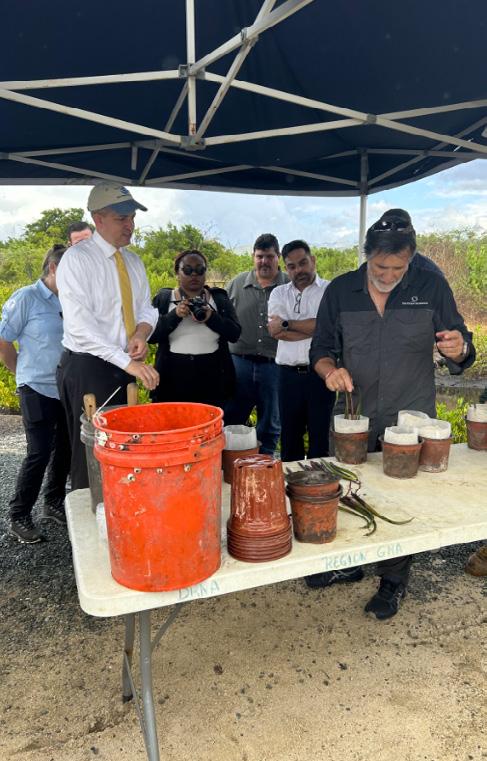
The U.S. Deputy Secretary of Commerce, Don Graves, at the mangrove nursery in Jobos Bay in Puerto Rico with restoration expert Manuel Merello. This trip to the largest mangrove restoration project in the U.S. was organized by The Jobos Bay National Estuarine Research Reserve, The Ocean Foundation, and BoriCorps. © Jason Donofrio, The Ocean Foundation.
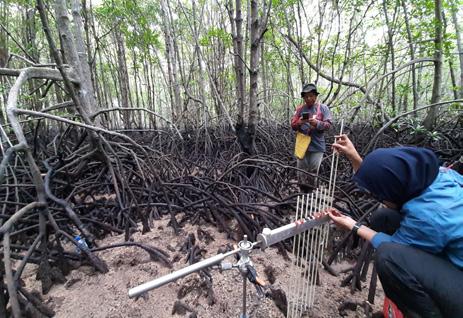
Mainstreaming mangrove blue carbon into policy
Frida Sidik, Research Center for Oceanography (National Research and Innovation Agency (BRIN))
As the country with the most mangrove forests in the world, Indonesia has implemented many strategies and measures to conserve this critical ecosystem. Given the potential contribution of blue carbon ecosystems to enhancing national climate ambitions, the Government of Indonesia has included blue carbon in climate policies and development plans.
While blue carbon is mainstreamed into policy, there remain gaps and challenges, including complexity in mangrove management and coordination. A framework of national blue carbon strategies was created to address five key issues in Indonesian blue carbon: policy and governance, science, outreach and communication, sustainable financing, and pilot projects. These strategies seek to address the issues through three main approaches: science, policy, and finance. Framework implementation has gained national and international support.
Photo: © Frida Sidik, BRIN
Mangrove Law and Policy Database developed through a partnership between WWF-US, Georgetown Law and Griffith University (unpublished)
7.3 The Mangrove Breakthrough
Mobilizing US$4 billion for the sustainable management of 15 million hectares of mangroves globally.
Kristina Rodriguez (High-Level Climate Champions (HLC)), Carlos Correa, Mark Beeston (Conservation International (CI)), Emily Landis, Luz Gil (The Nature Conservancy (TNC)), Jennifer Tabola (Wetlands International), Anelise Zimmer (The Pew Charitable Trusts)
The Breakthrough provides a framework for State and non-State actors to mobilize collective efforts.
Mangrove Breakthrough achievements
On December 4th, 2023, the GMA and the UN Climate Change High-Level Champions, in partnership with Systemiq, launched the Mangrove Breakthrough Financial Roadmap (see Section 7.1). The Financial Roadmap is the strategic blueprint for the mobilization of significant financial resources in support of the conservation and restoration of mangrove ecosystems. It received endorsements from various financial, private sector, and philanthropic institutions, including HSBC, Bezos Earth Fund, Salesforce, and Bank of America.

The Mangrove Breakthrough, launched by the United Nations’ High-Level Climate Champions (HLC) and the GMA, serves as a rallying call for accelerated action and investment supported by the mobilization of US$4 billion of sustainable finance. The goals of the Breakthrough mirror those of the GMA, along with ensuring long-term finance for the sustainable management of 15 million hectares of mangroves globally. The Breakthrough provides a framework for State and non-State actors to mobilize collective efforts towards achieving these ambitious goals. The work follows a set of Guiding Principles that prioritize sustainability, biodiversity, equity, and effective science-based conservation and restoration.
The Mangrove Breakthrough’s Community of Action, comprising over 100 stakeholders from civil society organizations, governments, Indigenous people, and the private sector, collaborates on various projects to drive a transformative shift in how we approach mangrove conservation and restoration, and aims to address climate change, protect biodiversity, and support coastal communities.
Achieving the goals of the Mangrove Breakthrough will directly support the GMA and result in a significant contribution to international frameworks, such as the Paris Agreement, Kunming-Montreal Global Biodiversity Framework, 30x30 targets, and the UN Decades on Ecosystem Restoration and Ocean Science.
On December 9th 2023, during UNFCCC COP28, a ministerial and non-state actor-led event was cohosted by the COP28 Presidency, the UAE Ministry of Climate Change and Environment, the High-Level Climate Champions and the GMA. During the highlevel convening, governments, financial institutions, philanthropies, NGOs, and other stakeholders made ambitious commitments to advance the Mangrove Breakthrough goal of securing the future of 15 million hectares of mangroves by 2030.
The Mangrove Breakthrough Council convening
Since COP28, the Mangrove Breakthrough has progressed with the launch of its governance structure, beginning with the Council formation. This group of cross-sector leaders will guide the Mangrove Breakthrough in establishing the Secretariat. The Secretariat’s role will be to convene stakeholders around an inclusive strategy that facilitates on-the-ground implementation, capacity building, scaling financial mechanisms, tracking success, communications, and thought leadership.
Government engagement
Governments are crucial stakeholders to achieve a step change in mangrove action. By joining the Mangrove Breakthrough, governments can demonstrate their leadership to turn their mangrove protection and restoration commitments into concrete actions and impacts. As of COP28, 50 governments (Figure 30) representing 60% of the world’s mangroves are supporting the Mangrove Breakthrough targets.
Governments can join the Mangrove Breakthrough by signing an Endorsement Letter committing to:
1. Setting and meeting ambitious but achievable contributions towards the Mangrove Breakthrough.
2. Joining the Mangrove Breakthrough’s Community of Action.
3. Setting up the enabling conditions and, if possible, provide new catalytic funding for mangrove action.
4. Adhering to the six Mangrove Breakthrough Guiding Principles.
Conservation International CEO, Dr. M. Sanjayan, giving remarks at the Mangrove Breakthrough Financial Roadmap’s launch, UNFCCC COP28 (Dubai, UAE). © Kristina Rodriguez, HLC.

Ministerial
Convening,
Government endorsements to the Mangrove Breakthrough must now translate into action. The Mangrove Breakthrough’s Nationally Determined Contributions (NDCs) Task Force is harnessing the opportunity of the 2025 updates to countries’ NDCs to the Paris Agreement to drive mangrove conservation, restoration, and finance. The NDC Task Force is an initiative led by partners, including The Pew Charitable Trusts and other members of the GMA, to transform Mangrove Breakthrough government endorsements into clear, science-based, and mangrove-positive NDCs.
The Mangrove Breakthrough initiative and its global call to action highlights the essential role of government involvement in safeguarding and restoring crucial ecosystems in the global response to the climate crisis. Governments already involved must lead by example, initiating tangible measures and mobilizing resources, including policy formation, funding allocation, and the execution of localized strategies that mirror this global commitment. By enhancing their involvement, these governments not only advance their sustainability objectives but also encourage others to join.
The Mangrove Alliance for Climate
Building on global efforts to promote biodiversity and shine a spotlight on nature-based solutions, the Mangrove Alliance for Climate (MAC) is a governmentled initiative chaired by the UAE and Indonesia that brings together national governments to promote mangroves as a nature-based solution to climate change. The MAC was launched at COP27 and seeks to scale up and accelerate conservation and restoration efforts of mangrove ecosystems for the benefit of communities globally and to recognize the importance of these ecosystems for climate change mitigation and adaptation.
At COP28, the Mangrove Breakthrough and MAC announced the ambition to secure a formal partnership in 2024. Together, these entities will work synergistically to advance the Mangrove Breakthrough and achieve its goals.
Implementation roadmaps for the Mangrove Breakthrough
A first step in translating the global ambition of the Mangrove Breakthrough into local action is in transforming the global goals into regional restoration and conservation targets. Based on spatial data from the Global Mangrove Watch platform, it has been possible to generate regional targets and to identify where the greatest potential areas for mangrove protection, loss reduction, and restoration are located.
Recognizing that each country with mangroves has unique policy, economic, and social conditions, the GMA is creating national summaries for regions in west Africa, the Americas, and Asia. These summaries aim to:
1. Help government representatives without specialized knowledge of mangrove management.
2. Guide donor and investor decision-making.
3. Highlight existing mangrove projects and initiatives.
Lastly, we must take the Financial Roadmap and turn it into a fundable project pipeline, developed with local stakeholders and investors, to support both shortterm and long-term mangrove conservation projects. By linking project supply with investment demand, the Breakthrough will convert global financial commitments into practical, on-the-ground actions.
Wetlands
International CEO, Han de Groot, giving the closing remarks at the Mangrove Breakthrough
UNFCCC COP28 (Dubai, UAE). © Kristina Rodriguez, HLC.
Mangrove endorsing countries
Figure 30: As of July 2024, the following territories (in blue) had endorsed the Mangrove Breakthrough: Argentina, Australia, Bahrain, Bangladesh, Barranquilla, Belgium, Brazil, Burundi, Chile, Colombia, Costa Rica, Cuba, Dominican Republic, Ecuador, El Salvador, France, Gambia, Germany, Guinea-Bissau, India, Indonesia, Jamaica, Japan, Kuwait, Liberia, Malaysia, Maldives, Mauritius, Mexico, Morocco, Mozambique, Norway, Oman, Pakistan, Palau, Panama, Peru, Philippines, Qatar, Quintana Roo (Mexico), Rio de Janeiro (Brazil), Russia, Senegal, Sierra Leone, South Korea, Spain, Sri Lanka, UK, United Arab Emirates, Venezuela, Yucatán (Mexico).
8. Final words
Building a better future based on knowledge and collaboration.

8.1 An update on the Global Mangrove Alliance
Partnership is at the heart of all our efforts to safeguard mangroves.
Benjamin Christ and Hannah Pickard (Impact by Design, Inc.)
With over 100 member organizations in more than 30 countries, the Global Mangrove Alliance (GMA) has become pivotal for mangroves. We’ve been able to reach thousands of practitioners through workshops and webinars, and many more through our tools, resources, and these reports. We are highly engaged at international conferences, holding side events at MMM6 and at the UNFCCC COP28 in December 2023, where several Mangrove Breakthrough commitments were secured from crucial mangrove countries.
Partnership stands at the core of what we do. By sharing our knowledge and understanding, we can develop best practices, avoid repeating past mistakes, and streamline our efforts to safeguard mangroves. Where we identify gaps, we work to address them as highlighted many times over in this report. Restoration challenges led to the development of the Best Practice Guidelines for Mangrove Restoration, and the Mangrove Restoration Tracker Tool. The GMW Loss Alerts have been established to fill gaps in knowledge and direct forest managers to address change. The National Chapters initiative is helping to connect work on the ground with both wider learning and funding.
We learn from each other, and as the partnership has grown, so the rollcall of interventions by GMA partners has become truly remarkable.
Further learning exchanges on policy challenges and solutions for members also led to a suite of Policy Briefs and a series of Science to Policy webinars. And the need to move faster and at larger scales without sacrificing equity and quality led to our involvement in The Mangrove Breakthrough.
We learn from each other, and as the partnership has grown, so the rollcall of interventions by GMA partners has become truly remarkable. This is illustrated by many of the photo stories and case studies throughout this report, although these barely scratch the surface of what is being achieved. We are busy, daily, around the world, restoring mangroves, empowering communities, and influencing governments and the international community.
Oyster harvester, Dionewar Island, Senegal © FAO, Sylvain Cherkaoui
We have also increased the internal capacity of the coordinating team to ensure that the GMA can keep up with its growth. Impact by Design, Inc. Is now the Program Management entity of the GMA and has been pivotal in strengthening the partnerships that led to the formation of the Mangrove Breakthrough initiative. We have added two new seats to our Steering Committee to better represent our diverse membership and National Chapter interests, and we have grown the size and leadership of our various Working Groups.
Through extensive fundraising efforts, including a successful application to the 2022 Food Planet Prize, the GMA has directly supported restoration training in

Ecuador, Indonesia, and Kenya, but this is just the start. We’ve held Global Mangrove Watch training in even more countries and are planning a training curriculum that can be tailored to the needs of our members and partners to provide support that makes sense for the diverse range of mangrove countries.
The GMA’s next priority is to identify, analyze, and support mangrove projects that are most impactful and grounded in science. We continue working on research and ways to disseminate and popularize the conservation and restoration approaches with highest success rates, but we are also focusing on raising the voices of communities and tailoring those approaches to local contexts to ensure that global solutions also work to meet local needs.
We march towards 2030 supported by the power of data, the value of local ecological knowledge, the innovation of sustainable finance opportunities, and hope, grounded in the potential of our united achievements.

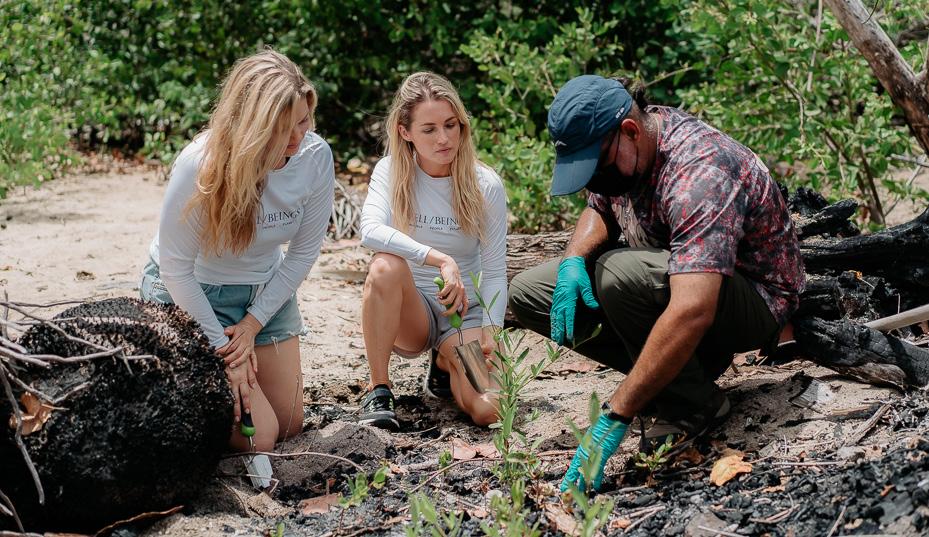
Do you work on mangrove projects?
Complete the GMA’s 2024 Impact Stock Take to share your experiences and help us:
• Measure worldwide progress towards the 2030 Goals.
• Identify and connect viable projects with funding and training opportunities. This could include your project!
We urge you to take part!
Scan or click on the QR code to take our survey and find out more.
WELL/BEINGS is funding restoration of mangroves in Vieques, Puerto Rico, that were destroyed by Hurricane Maria. The field team recently planted 2,000 white mangrove (Laguncularia racemosa) seeds, employing a proven technique. © Harold Camilo, WELL/BEINGS.
Since 2017, the community group Federation Miaramientagna has successfully restored 2,355 hectares of mangroves in Tsimipaika Bay, northwest Madagascar. Thanks to communitywide involvement, the average survival rate of the planted trees is 86%. © Leah Glass, Blue Ventures.
In the embrace of the mangroves, we see a portrait of diversity, where each leaf , flower and fruit tells a story of adaptation and vitality. © Pratiksha Dabolkar, PES’s RSN College of Arts and Science Farmagudi, Ponda Goa
8.2 The journey to 2030
Our ambitions are running high for the world’s mangroves.
Maricé Leal and Mark Spalding (The Nature Conservancy (TNC))
From carbon finance to insurance - the investment opportunities in mangroves seem endless.
Much depends on this decade to avoid a climate tipping point, and to secure a future for biodiversity. Almost halfway through, the reasons to keep going are clearer than ever.
Through their multitude of benefits, mangroves sustain and safeguard entire communities. Food security is increasingly important as demographic change and political and climatic disruptions reduce certainty in many countries. Healthy mangrove ecosystems can provide bountiful and sustainable food supplies, far more than when converted to intensive, but often short-lived, agriculture and aquaculture.
Meanwhile, mangroves are critical to our response to climate change, both in mitigating change through carbon storage and sequestration, and through more local benefits - by helping us adapt to the change we are already too late to avoid. These many roles that mangroves play translate to a wealth of funding opportunities. From carbon finance, to resilience credits, biodiversity credits, and insurance - the investment opportunities in mangroves seem endless.
The GMA has continued to support the scientific bedrock that gives clarity and direction to mangrove management and conservation. This also helps to justify these investment needs to secure the future of mangroves. In this report we describe a more than six-fold improvement in the resolution of the global



extent map, and we present new maps and models of commercial fish, soil carbon, and protection from storm surges. Through clear science, global to local engagement, and personal stories from those who know them best, the case has been made to halt further loss, protect the mangroves that remain, and restore their historical extent to the best of our ability.
Our ambitions are high, and our impacts must be higher if we are to accomplish our 2030 Goals. Through the collective efforts of global and local partnerships, we can ensure that mangroves, and everything that depends on them, survives...and thrives.
Kayakers paddle through the Ting Kok Mangroves in Tai Po, Hong Kong. This area supports a rich diversity of mangroves and associated fauna. © Yolanda Sun, TNC Photo Contest 2021.
Kiunga Village in Lamu County, Kenya, is highly dependent on the food and income sources generated from the nearby mangroves and coral reefs. © Mwangi Kirubi.
Local conservation teams meet with trainers from Mangrove Action Project in Bengkalis, Indonesia, to assess the feasibility of restoration after a fire. © Mangrove Action Project.
